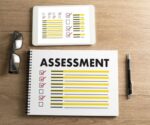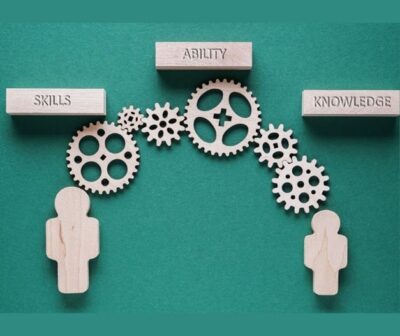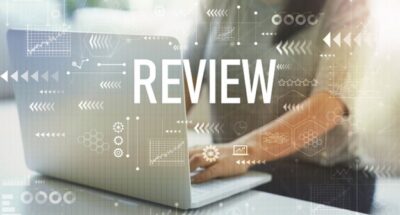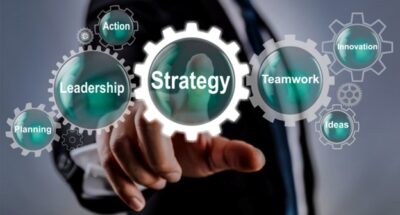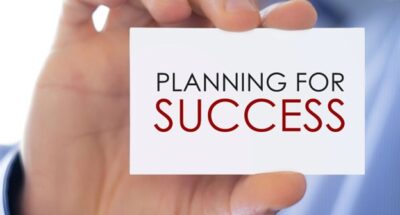Evolutionary Leader – WDP1 (Focus Enhancement)
The Appleton Greene Corporate Training Program (CTP) for Evolutionary Leader is provided by Ms. Kapoor Certified Learning Provider (CLP). Program Specifications: Monthly cost USD$2,500.00; Monthly Workshops 6 hours; Monthly Support 4 hours; Program Duration 48 months; Program orders subject to ongoing availability.
If you would like to view the Client Information Hub (CIH) for this program, please Click Here
Learning Provider Profile

Ms. Kapoor is a Certified Learning Provider (CLP) with Appleton Greene, renowned for her over 15 years of management experience including over 7 years of people management, 10 years of leadership experience and 11 years of process improvement and professional development experience including coaching, mentoring and training at various levels including executives and CEOs. Her specialties lie in personal and professional development and leadership, with a strong focus on empowering workplace and business leaders in exceling in their roles, unlocking their potential & enjoying their professional success through confidence, effectiveness and being empowering, authentic and purposeful in their career, business and in life.
Ms. Kapoor’s extensive industry experience spans Healthcare, with commercial achievements in Seattle, WA, and Dallas, TX.
As the Founder and CEO of her conscious leadership coaching company for the past five plus years, Ms. Kapoor has been an award-winning Conscious Leadership Coach and a best-selling author of multiple books highly acclaimed as must-reads for aspiring and ambitious workplace leaders who want to unlock their full leadership potential and impact.
Her contributions to leadership and personal development have been featured prominently, including regular monthly columns in Executive Function Magazine as well as listings in prestigious accolades such as Marques Who’s Who 2023, Brainz Magazine’s Global 500 Awards in 2020 and 2021, Brainz Magazine’s CREA Awards 2021, Corporate Vision Magazine’s Corporate Excellence Awards 2021, a feature article in ValiantCEO Magazine, a brand spotlight feature in E.G.O. Entertainment Network News and being 1 of 4 women featured in BuzzFeed’s article, “Four Women Choosing To Impact The World Through Their Work,” just to name a few.
Ms. Kapoor is also the dynamic host of two tv shows where she challenges perceptions and inspires personal transformation through engaging presentations and expert interviews. Her mission is to help individuals overcome obstacles and embrace their full potential, both personally and professionally.
Her service skills encompass leadership development, leadership and executive coaching, business strategy, process improvement, management and operations, change management, mindset transformation and speaking and presentation skills.
MOST Analysis
Mission Statement
The mission of the ‘Focus Enhancement’ workshop is to empower workplace managers and leaders with the critical tools and insights necessary to master the art of time and energy management initially for the purpose of being able to optimally participate in the ‘Evolutionary Leader’ corporate training program but also for long-term efficiency and productivity.
In today’s fast-paced and demanding corporate environment, managers and leaders are often inundated with a multitude of responsibilities and distractions that can hinder their ability to operate at peak efficiency. This workshop is dedicated to transforming these challenges into opportunities for growth, efficiency, and innovation.
At the core of our mission is the belief that effective time and energy management is not just a skill, but a foundational element that enables personal well-being and professional excellence. We recognize that managers and leaders who manage their resources effectively can foster a workplace culture that prioritizes focus and innovation, leading to enhanced performance and organizational success. Therefore, this workshop is meticulously designed to equip participants with the essential skills to navigate the complexities of modern work life while maintaining their personal well-being and achieving sustainable success.
Our first goal is to optimize the participation of every leader on this conscious leadership development journey. We understand that leaders are often stretched thin and balancing numerous tasks, which is why this workshop strategically targets creating an environment that is free from distractions and overwhelm. We aim to guide participants in cultivating their unique ideal state—an environment that supports their focus and productivity while minimizing disruptions. By establishing such an environment, leaders can maximize their engagement and derive the most benefit from our training.
A key component of our mission is to teach leaders how to master prioritization. In a world where time is a finite and, in some cases, a scarce resource, knowing how to prioritize tasks is essential. This workshop provides leaders with the frameworks and strategies they need to discern what is most important and urgent, allowing them to direct their energies toward activities that yield the highest returns. This skill not only enhances individual productivity but also contributes to the overall effectiveness of the teams they lead.
Boundary-setting is another pillar of this workshop. Leaders often face challenges in setting and maintaining boundaries, which can lead to burnout and a decreased quality of life. We are committed to helping participants learn how to establish and communicate clear boundaries, empowering them to protect their time and energy. By doing so, they can focus on strategic priorities and foster a healthier work-life balance, which is crucial for long-term success and personal fulfillment.
Mindful energy allocation is also a cornerstone of this workshop. Participants will learn to recognize their peak energy periods and align their most demanding tasks with these times. This approach ensures that leaders can work more efficiently and effectively, optimizing their output while minimizing fatigue. By managing their energy wisely, leaders can sustain high levels of performance and creativity, essential ingredients for driving innovation and achieving organizational goals.
Ultimately, the ‘Focus Enhancement’ workshop is a critical foundational step that prepares leaders for their conscious leadership development transformational journey. By instilling the principles of effective time and energy management, we aim to lay a solid launching pad for leaders to thrive in their roles and inspire those around them.
Objectives
01. Assessing Focus and Efficiency – Evaluate current time and energy management practices to identify patterns, inefficiencies, and opportunities for improvement to enhance productivity and focus.
02. Designing Focus and Balance – Envision and construct an optimal work environment and personal state that minimizes distractions and promotes a sustainable work-life balance.
03. Creating Leader Role Clarity – Gain a deep understanding of your leadership responsibilities and objectives to establish clear priorities and set boundaries, reducing stress and enhancing focus.
04. Focused Clarity – Develop a prioritized list of tasks and goals to streamline efforts on high-impact activities, fostering efficiency and reducing overwhelm.
05. Time Mastery Blueprint – Master time management by organizing tasks based on importance and urgency, incorporating breaks to prevent burnout and maintain energy levels.
06. Mindful Energy Management – Align mental, emotional, and physical energy with tasks to enhance productivity and well-being, preventing burnout and fostering resilience.
07. Establishing Healthy Boundaries – Define and uphold boundaries that protect time and energy, promoting a balanced and productive work environment.
08. Delegating Tasks – Learn to delegate effectively, optimizing team performance and freeing up time to focus on high-priority leadership tasks.
09. Designing Your Efficient Space – Transform your workspace into an efficient and focused zone that supports concentration and minimizes distractions.
10. Celebrate and Evaluate – Recognize personal achievements and critically assess progress to sustain motivation and develop strategies for continuous improvement.
11. Navigating Workload Changes – Equip yourself with strategies to manage evolving demands and maintain balance in both professional and personal spheres.
12. Conscious Leader Launchpad – Leverage insights from previous steps to build a robust foundation for your leadership journey, ensuring sustainable success and innovation.
Strategies
01. Assessing Focus and Efficiency: Begin by evaluating your current time and energy management practices. Keep a detailed log of your daily activities for a period of one week or so to uncover patterns, inefficiencies, and energy peaks. Use this awareness to identify opportunities for improvement to enhance your productivity and focus.
02. Designing Focus and Balance: Reflect on your findings from your assessments and envision your ideal workplace state of being and work environment. Consider how you can cultivate intentionality and regain control, transitioning from reactive to proactive leadership. Identify critical elements needed to create a balanced and focused workspace and personal state.
03. Creating Leader Role Clarity: Use the ‘Hats of Leadership’ framework to clarify and gain a deeper understanding of your leadership role and responsibilities. Determine and clarify key objectives for your role, identifying any red flags that indicate a lack of clarity. Apply this framework to navigate challenges and enhance both efficiency and satisfaction in your leadership role.
04. Focused Clarity: Transform the clarity gained from your role assessments into strategic goals and priorities. Set clear goals and rank tasks by importance and urgency to concentrate your efforts on high-impact activities. Move beyond the to-do list to align daily actions with your strategic vision.
05. Time Mastery Blueprint: Develop a comprehensive time management plan. Allocate specific time slots for tasks based on priority. Use techniques to minimize distractions and combat procrastination, and leverage technology to enhance efficiency. Incorporate regular breaks to prevent burnout and maintain energy levels.
06. Mindful Energy Management: Understand and align your mental, emotional, and physical energy with tasks to optimize productivity. Identify your energetic ‘sweet spot’ by analyzing the five core human components. Recognize how introversion and extroversion impact your energy management and implement strategies to maintain energy throughout the day, enhancing both productivity and well-being.
07. Establishing Healthy Boundaries: Define and uphold boundaries that safeguard your time and energy. Reflect on your self-respect, self-love, and self-care foundations to align boundaries with core values and goals. Tackle people-pleasing tendencies and brainstorm to enhance boundary-setting practices.
08. Delegating Tasks: Recognize the importance of effective delegation for optimizing your time and energy as well as your team’s growth and performance. Identify tasks suitable for delegation and recognize the potential within your team. Build trust as the foundation for effective delegation, learning to let go of perfectionism and avoid micromanaging. Embrace the delegation journey from initial hurdles to achieving lasting success.
09. Designing Your Efficient Space: Transform your workspace into a catalyst for creativity and efficiency by organizing and reducing clutter. Incorporate elements of nature and calmness to optimize your environment. Regularly assess and adjust your workspace to ensure it supports your personal and professional goals, fostering an efficient and distraction-free zone.
10. Celebrate and Evaluate: Embrace the power of recognition and celebration. Regularly review and realign your goals and strategies. Recognize personal achievements and celebrate milestones to sustain motivation. Observe the impact of your new initiatives on growth and development. Embrace failures as stepping stones, using them as learning opportunities for continuous improvement.
11. Navigating Workload Changes: Equip yourself with strategies to manage evolving demands. Regularly review your workload and adapt techniques to maintain balance. Stay flexible and implement strategies that allow you to navigate changes while maintaining focus and productivity.
12. Conscious Leader Launchpad: Use insights gained from this workshop to build a robust foundation for your leadership journey. Reflect on your progress and integrate new strategies moving forward. Set clear intentions for success and approach your next phase of this program with confidence and clarity.
Tasks
01. Guides Review and Note-Taking: Thoroughly go through the Distance Learning, Tutorial Support, and How to Study Guides. Make detailed notes to fully prepare for your conscious leadership development journey.
02. Checklist and Familiarization: Complete the Distance Learning Checklist, familiarize yourself with the Tutorial Support Procedure, and understand the Qualification Requirements in the How to Study Guide.
03. Course Manuals and Project Study: Be aware that each course manual has its own set of project study exercises. Be sure to go through each workshop course manual thoroughly and then complete the Project Study exercises corresponding to each course manual as you progress, as each course manual builds upon the previous one.
04. Assessing Focus and Efficiency: Maintain a detailed log of your daily activities for one week or so to identify patterns, inefficiencies, and energy peaks. Complete a Time Audit to evaluate your current time management practices, analyze sources of interruptions via a Distraction Analysis and areas where focus is lost, and track and document your energy levels via an Energy Peaks Identification throughout the day to recognize peak productivity times.
05. Designing Focus and Balance: Reflect on insights from your Time Audit, Distraction Analysis, and Energy Peaks Identification assessments to understand your current practices. Craft a very detailed, comprehensive vision of your ideal work environment and state of being, identifying elements that enhance focus and productivity.
06. Creating Leader Role Clarity: Review your job description and engage in a conversation with your manager to clarify your role objectives, documenting your insights for future reference. Map your role using the ‘Hats of Leadership’ framework, analyze each aspect, and develop a personal growth plan, reflecting on your findings and documenting them.
07. Focused Clarity: Identify strategic goals based on your leader role clarity and document them. Review your daily tasks, identify misalignments with your strategic goals, and make necessary adjustments. Additionally, create a comprehensive task list, rank tasks using the Eisenhower Box, and adjust priorities, identifying appropriate task to delegate or eliminate as needed.
08. Time Mastery Blueprint: Allocate specific time slots for priority tasks based on your energy peaks, experimenting with different time management techniques and reflecting on their effectiveness. Review your current technology usage, identify gaps, and explore new tools to enhance efficiency, implementing these tools strategically and adjusting as needed. Assess your current rest practices, identify areas for improvement, and integrate new strategies to ensure regular breaks and maintain energy levels.
09. Mindful Energy Management: Conduct a self-assessment to identify your disposition and tailor your energy management practices accordingly. Set a challenge week to test daily energy boosters, track results, and develop a personalized toolkit for continuous improvement. Additionally, identify key areas for lifestyle improvement, set daily actions, track progress, reflect on the impact, and integrate changes into your routine.
10. Establishing Healthy Boundaries: Reflect on past exercises to assess your current boundaries and identify opportunities for improvement. Develop a plan to integrate boundaries into your time management, brainstorm communication strategies, and practice saying no to non-essential tasks.
11. Delegating Tasks: Review delegation opportunities, consider team member skills, brainstorm task assignments, document your plan, and reflect on its effectiveness. Define task objectives, set clear expectations, establish progress check-ins, determine deadlines, document the plan, and reflect on the process. Additionally, schedule and prepare for meetings to discuss delegation, conduct the meetings, and document insights.
12. Designing Your Efficient Space: Assess workspace ergonomics, lighting, organization, and biophilic elements, documenting findings and planning improvements. Minimize distractions, enhance ergonomics, optimize lighting, incorporate natural elements, and reflect on changes, adjusting as needed.
13. Celebrate and Evaluate: Establish a routine for daily recognition, weekly reflection, and monthly milestone celebrations. Define evaluation metrics, conduct daily and weekly reviews, and adjust strategies based on data analysis. Additionally, reflect on past failures, identify lessons learned, develop growth strategies, document insights, and commit to continuous learning.
14. Navigating Workload Changes: Develop a workload changes toolkit based on past learnings and apply it in real-world scenarios, collaborating and sharing insights with peers. Set objectives, identify key metrics, and plan regular reviews to incorporate feedback and adjust strategies.
15. Conscious Leader Launchpad: Review current practices, incorporate additional strategies, and set actionable goals for leadership development. Reflect on positives, define goals, visualize success, and commit to your intention for the remainder of the ‘Evolutionary Leader’ program.
Introduction
Welcome to the ‘Focus Enhancement’ workshop, the inaugural step in our ‘Evolutionary Leader’ corporate training program. This workshop is meticulously crafted to empower workplace managers and leaders with the critical tools and insights necessary to master the art of time and energy management. In today’s fast-paced corporate environment, leaders are often inundated with a multitude of responsibilities and distractions that can hinder their ability to operate at peak efficiency. Our mission is to transform these challenges into opportunities for growth, efficiency, and innovation.
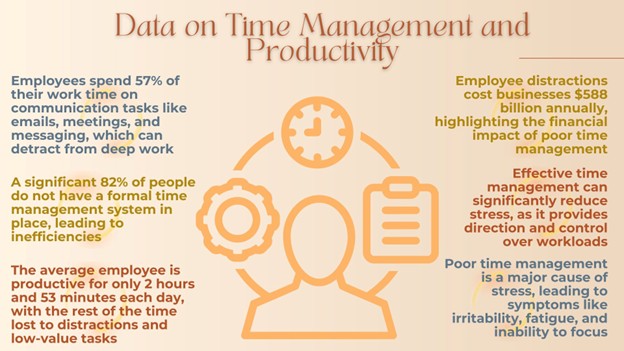
Mission and Framework:
At the heart of our mission is the belief that effective time and energy management is not merely a skill but a foundational element for personal well-being and professional excellence. Managers and leaders who manage their resources effectively can foster a workplace culture that prioritizes focus and innovation, leading to enhanced performance and organizational success. This workshop is designed to equip participants with the essential skills to navigate the complexities of modern work life, while maintaining personal well-being and achieving sustainable success.
Our goals are to optimize participation and engagement among leaders in this conscious leadership development journey. Recognizing the common challenge of balancing numerous tasks, this workshop strategically targets creating an environment free from distractions and overwhelm. By cultivating an ideal state, leaders can maximize their engagement and reap the most benefit from our training.
Objectives and Strategies:
1. Assessing Focus and Efficiency: Evaluate current time and energy management practices to identify patterns, inefficiencies, and opportunities for improvement.
2. Designing Focus and Balance: Envision and construct an optimal work environment that minimizes distractions and promotes a sustainable work-life balance.
3. Creating Leader Role Clarity: Gain a deep understanding of leadership responsibilities to establish clear priorities and set boundaries, reducing stress and enhancing focus.
4. Focused Clarity: Develop a prioritized list of tasks and goals to streamline efforts on high-impact activities.
5. Time Mastery Blueprint: Master time management by organizing tasks based on importance and urgency, incorporating breaks to prevent burnout.
6. Mindful Energy Management: Align mental, emotional, and physical energy with tasks to enhance productivity.
7. Establishing Healthy Boundaries: Define and uphold boundaries that protect time and energy, promoting a balanced and productive environment.
8. Delegating Tasks: Learn to delegate effectively, optimizing team performance and freeing up time for high-priority leadership tasks.
9. Designing Your Efficient Space: Transform your workspace into an efficient zone that supports concentration and minimizes distractions.
10. Celebrate and Evaluate: Recognize achievements and critically assess progress to sustain motivation and develop strategies for continuous improvement.
11. Navigating Workload Changes: Equip yourself with strategies to manage evolving demands and maintain balance.
12. Conscious Leader Launchpad: Leverage insights from previous steps to build a robust foundation for your leadership journey.
Case Studies and Success Stories:
Real-world examples illuminate the impact of our strategies.
For instance, meet Jane, a marketing executive who transformed a chaotic schedule into a streamlined, productive routine. By prioritizing tasks and setting clear boundaries, she increased her output by 30% and improved her team’s morale.
Consider John, a finance manager who, through structured time audits and energy management, reduced his workweek by 10 hours while boosting his department’s output.
Another example is Lisa, an HR leader who used delegation frameworks to not only prioritize high-impact tasks but also empower her team, resulting in a 20% increase in employee engagement scores.
Common Challenges and Solutions:
Many leaders struggle with prioritizing tasks, handling constant interruptions, and managing energy levels. Our workshop addresses these challenges head-on. We introduce the Eisenhower Box, a matrix for prioritizing tasks based on urgency and importance, and distraction analysis techniques to identify and mitigate sources of interruption. For energy management, we provide strategies to align tasks with energy peaks, enhancing productivity.
Expert Quotes:
“The ability to focus is the cornerstone of modern leadership,” says Dr. Angela Marks, a renowned corporate strategist.
Phil Johnson, author of ‘Leadership and Focus,’ emphasizes, “Leadership is less about what you do and more about where you focus your attention.”
Additionally, Susan Peters, a leading organizational psychologist, notes, “Effective energy management is the key to sustaining high performance and preventing burnout.”
Preparation:
To prepare for the workshop, participants should review the Distance Learning, Tutorial Support, and How to Study Guides. Completing the Distance Learning Checklist and familiarizing themselves with the course manuals and project study exercises will ensure full engagement with the material. Each manual builds upon the previous one, so thorough preparation is crucial.
Resource List:
To further their learning, we recommend “Deep Work” by Cal Newport and “The Power of Habit” by Charles Duhigg. These resources will complement the workshop experience, providing additional insights into effective focus and habit formation.
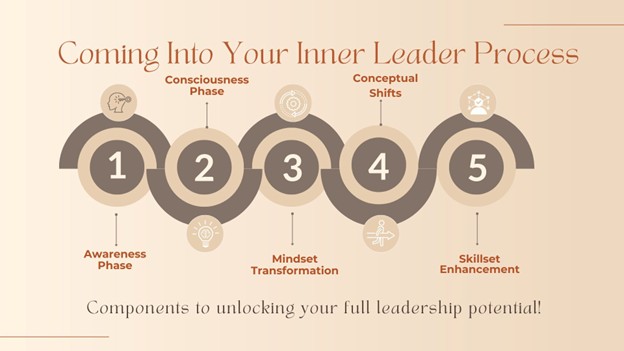
Incorporating the ‘Evolutionary Leader’ Program Methodology:
In today’s dynamic corporate landscape, organizations face myriad challenges, from financial losses due to ineffective leadership to high employee turnover and toxic work environments. Our ‘Evolutionary Leader’ program is grounded in the philosophy that ‘you can only lead others as effectively as you lead yourself.’ This belief underpins our 5-step process, designed to address these pressing issues.
The journey begins with the Awareness Phase, where leaders assess their current strengths and areas for improvement, setting personal development goals that align with their broader leadership vision. This understanding is enhanced in the Consciousness Journey, as leaders define their purpose and values, fostering environments of psychological safety and trust.
Our methodology continues with Mindset Transformation and Conceptual Shifts, encouraging leaders to challenge fixed beliefs and embrace a growth-oriented mindset. Finally, Skillset Enhancement emphasizes continuous professional development, ensuring leaders are equipped with essential skills like communication and conflict resolution.
The program is strengthened by four critical components: a proven strategy, proper tools, expert guidance, and an environment conducive to success. Participants benefit from interactive exercises and personalized guidance, ensuring they navigate their journey with support, empowering leaders to transform themselves and their organizations.
Through these elements, the ‘Evolutionary Leader’ program not only addresses immediate pain points but also lays the foundation for sustainable leadership development and organizational success.
Call to Action:
We invite you to embrace this opportunity to transform your leadership approach and inspire those around you. By the end of this workshop, you will have a solid foundation for your conscious leadership development journey, equipped with skills to achieve sustainable success and drive innovation within your organization.
Ultimately, the ‘Focus Enhancement’ workshop is a critical foundational step that prepares leaders for their transformational journey. By instilling principles of effective time and energy management, we aim to lay a solid launching pad for leaders to thrive in their roles and inspire those around them. We look forward to embarking on this journey with you, equipping you with the tools to lead with focus, clarity, and purpose.
Executive Summary
The first workshop of our ‘Evolutionary Leader’ program is “Focus Enhancement” where we will be exploring improving and optimizing our Time & Energy Management – initially to assist in being able to optimally participate in the ‘Evolutionary Leader’ program but also for long-term optimization of productivity and efficiency.
Effective time and energy management are crucial not only for personal well-being but also for fostering a culture of efficiency, focus, and innovation within the workplace, ultimately leading to improved performance and organizational success. We know that as a workplace manager and leader, you’re already super busy. We want to kick things off by making sure that you’re able to optimize your participation in this journey and therefore your results from this training program by fostering your unique ideal state and environment free from distractions and overwhelm. This workshop is designed to equip participants with the essential skills to effectively manage their time and energy resources, vital for achieving sustainable success in not just this program but also in today’s fast-paced work environment. By mastering the art of prioritization, boundary-setting, and mindful energy allocation, participants can enhance their productivity, reduce burnout, and lay a solid foundation for their forthcoming Conscious Leadership Development journey of the ‘Evolutionary Leader’ corporate training program.
Chapter 1: Assessing Focus and Efficiency
In the “Focus Enhancement” workshop of the “Evolutionary Leader” corporate training program, the step of ‘Assessing Focus and Efficiency’ is pivotal for fostering conscious leadership. Participants begin by meticulously evaluating their current time and energy management practices. This involves tracking their schedule and tasks over the course of a week to gain a comprehensive understanding of how their time is being allocated. By keeping a detailed log, leaders can identify patterns, pinpoint inefficiencies, and recognize where their energy is being most effectively utilized. This self-assessment is crucial in highlighting typical dips in energy and mental exhaustion throughout the day, enabling leaders to strategically plan their workload around periods of peak productivity.
Identifying distractions and sources of overwhelm is another essential component of this step. By examining their schedule and environment, participants can uncover the interruptions that derail focus and contribute to a sense of being overwhelmed. This awareness is fundamental in creating an environment that minimizes these distractions, thus enhancing concentration and reducing stress. Through this process, leaders learn to manage their workload sustainably, incorporating breaks and mindful energy allocation to prevent burnout. By recognizing when to rest and recharge, they can maintain a healthier work-life balance, which is critical for long-term well-being and performance.
Furthermore, this step addresses pain points related to inefficient energy use and the struggle to maintain productivity. By understanding their typical energy cycles, leaders can allocate their most demanding tasks to times when they are most alert and capable, ensuring their efforts are both efficient and effective. This conscious approach to managing energy and focus not only boosts productivity but also contributes to sustainable success and innovation. By fostering an environment that supports deliberate concentration and energy management, leaders are better equipped to prioritize tasks, set clear boundaries, and foster a culture of efficiency and innovation within their organizations.
Chapter 2: Designing Focus and Balance
The second step, ‘Designing Focus and Balance,’ encourages participants to envision their optimal work setting and personal state of being. After a week of assessing their current practices and energy management, leaders are guided to reflect on their findings and creatively brainstorm what their ideal environment would entail. This exercise allows leaders to visualize a workspace and routine that minimizes distractions and enhances focus, tackling the common pain point of feeling overwhelmed by constant interruptions. By defining an environment that supports concentration and clarity, participants can better manage their workload, reducing the risk of burnout.
Addressing work-life imbalance and the lack of prioritization is central to this step. By articulating their ideal state, leaders can identify the boundaries necessary to maintain a healthy balance between professional commitments and personal well-being. This process involves setting clear goals and priorities, which helps leaders focus on what’s truly important and manage their time more effectively. Establishing such boundaries reduces overcommitment and the stress associated with unclear expectations, allowing leaders to say no to non-essential tasks and concentrate on their core responsibilities.
This step also plays a crucial role in promoting sustainable success and innovation. By envisioning an ideal work environment, leaders are encouraged to think creatively about how they can optimize their energy use and productivity. This forward-thinking approach not only addresses inefficiencies but also fosters a culture of continuous improvement and innovation. As leaders define what success looks like for them, they are better equipped to create a roadmap for achieving it, thereby supporting their journey towards conscious leadership and long-term organizational success.
Chapter 3: Creating Leader Role Clarity
The third step, ‘Creating Leader Role Clarity,’ is essential for empowering leaders with a deep understanding of their responsibilities and objectives. This process begins by determining and clarifying the key objectives of one’s role, achieved through reviewing job descriptions and engaging in discussions with managers or directors. Such clarity minimizes distractions and overwhelm, allowing leaders to focus on core responsibilities and manage their workload sustainably. By understanding their roles better, leaders can establish clear boundaries, reducing stress from overcommitment, and ensuring they prioritize tasks effectively.
Our ‘Hats of Leadership’ framework further enhances this clarity by presenting three key aspects: ‘Behind the Scenes’, ‘In the Spotlight’, and ‘In the Director’s Chair’. These elements help leaders recognize the diverse demands of their roles. ‘Behind the Scenes’ covers operations and logistics, demanding attention to detail and problem-solving skills to keep the organization running smoothly. ‘In the Spotlight’ focuses on visible leadership activities like inspiring and motivating teams, requiring charisma and communication skills. Lastly, ‘In the Director’s Chair’ involves strategic planning and vision-setting, necessitating innovation and adaptability. By mastering these buckets, leaders can better manage their time and energy, preventing burnout and enhancing productivity.
Understanding these aspects allows leaders to identify areas for personal growth, aligning their development with role expectations. This structured approach not only helps leaders prioritize effectively but also fosters an environment of trust, loyalty, and innovation. By embracing the ‘Hats of Leadership’ framework, leaders can drive organizational growth and sustain long-term success, ensuring they are equipped to tackle challenges proactively and inspire their teams towards shared goals. This clarity and focus are crucial for leaders aiming to build motivated teams and create a culture of efficiency and innovation.
Chapter 4: Focused Clarity
The fourth step, ‘Focused Clarity,’ empowers leaders to streamline their tasks and focus on what truly matters. This process begins by utilizing insights from their prior assessments, reflections, and leader role clarity determination to develop a comprehensive list of goals and priorities. By ranking tasks based on their importance and urgency, leaders can concentrate their efforts on high-impact activities, effectively managing their time and resources. This structured approach not only alleviates the chaos of distractions and overwhelm but also helps in establishing a clear roadmap for achieving desired outcomes.
Setting clear goals and priorities is instrumental in combating burnout and maintaining work-life imbalance. By identifying tasks that can be delegated, leaders can distribute workloads more evenly, allowing them to focus on strategic objectives and maintain a sustainable pace. This delegation also empowers team members, fostering a collaborative environment where everyone contributes to collective goals. Furthermore, by setting boundaries around their time and energy, leaders can prevent overcommitment and ensure they dedicate sufficient time to personal well-being and professional development, promoting a healthy balance between work and personal life.
Overall, this step is crucial for nurturing a culture of efficiency and innovation within an organization. By concentrating on meaningful goals and delegating appropriately, leaders can enhance their productivity and focus, tackling procrastination and inefficiencies head-on. As leaders become adept at prioritizing their tasks, they foster an environment where sustainable success and innovation thrive, ultimately supporting their journey towards conscious leadership and long-term organizational success. This clarity in goals and priorities not only enhances individual performance but also drives the collective growth and resilience of the organization.
Chapter 5: Time Mastery Blueprint
The fifth step, ‘Time Mastery Blueprint,’ is fundamental in enhancing leaders’ productivity and well-being. This step emphasizes allocating specific time slots for tasks based on their priority, ensuring that leaders focus on what truly matters. By organizing tasks in order of importance and urgency, leaders can minimize distractions and reduce the feeling of being overwhelmed by constant interruptions. This structured approach to time allocation not only sharpens focus but also helps in tackling procrastination, thereby boosting overall productivity.
Incorporating breaks and buffer times is a critical element of the time management plan to prevent burnout. Recognizing the necessity of rest, this step encourages leaders to allocate mindful energy breaks, allowing for moments of recharge. These breaks are essential in helping leaders manage their workload sustainably and maintain a healthy work-life balance. By setting clear boundaries and respecting personal time, leaders can prevent overcommitment, reduce stress, and foster better work-life integration. This balanced approach ensures that leaders are at their most alert and capable when tackling demanding tasks, leading to more efficient energy use and sustained performance.
Overall, developing a time management plan is crucial for nurturing a culture of efficiency and innovation within organizations. By strategically planning their time and incorporating necessary breaks, leaders can enhance their productivity and focus, addressing inefficiencies and maintaining a steady workflow. This proactive approach not only supports the individual growth of leaders but also contributes to the long-term success and resilience of their organization. By mastering time management, leaders are better equipped to lead their teams effectively, driving sustainable success and fostering an environment ripe for innovation.
Chapter 6: Mindful Energy Management
The sixth step, ‘Mindful Energy Management’ is crucial for optimizing leaders’ productivity and efficiency.
In this chapter, we’ll explore how to harmonize your mental, emotional, and physical energy to enhance positivity and productivity. Finding your sweet spot—where your energy expenditure perfectly aligns with your tasks and personality—prevents burnout and fosters well-being. This involves understanding how your energy fluctuates throughout the day and aligning your activities accordingly.
For introverts, who might feel drained by excessive social interaction, and extroverts, who gain energy from engaging with others, recognizing how different activities impact your energy is vital. Whether it’s the quiet of a solitary task or the buzz of a collaborative project, knowing what energizes or depletes you allows for better energy management.
Mindful energy management also involves understanding how people and environments affect your energy levels. Some interactions might invigorate you, while others could drain your reserves. By acknowledging these influences, you can tailor your schedule to incorporate energizing activities around peak performance times, ensuring your energy is used efficiently and effectively.
Balancing energy expenditure in line with your personal traits and external influences is essential for maintaining overall balance and effectiveness. This practice not only enhances personal productivity but also contributes to sustainable success within your organization. As you master energy management, you create a resilient and adaptable work environment, poised to embrace the challenges and opportunities of the future.
Chapter 7: Establishing Healthy Boundaries
The seventh step, ‘Establishing Healthy Boundaries,’ is vital for leaders aiming to cultivate a productive and balanced work environment. This chapter focuses on the transformative power of establishing healthy boundaries, a vital practice for leaders striving to enhance both their leadership effectiveness and personal well-being. This chapter guides participants through reflective and practical exercises designed to help them define, communicate, and uphold boundaries that safeguard their time and energy. By doing so, leaders can significantly reduce stress and improve their work-life balance.
In this chapter, setting healthy boundaries is framed as an act of self-care, self-love, and self-respect. These foundational principles empower leaders to align their actions with their core values and strategic goals, creating a structured environment that supports both personal growth and organizational success. Participants will learn to communicate their availability and limits effectively, ensuring clear expectations with colleagues and team members, which minimizes distractions and enhances team efficiency.
Leaders will also explore strategies to confidently say no to non-essential tasks, preventing overcommitment and fostering a sustainable workload. This approach not only prevents burnout but also ensures that leaders have the focus and energy needed for high-impact activities, promoting a culture of efficiency and innovation within their teams.
By integrating these practices, leaders set a precedent for respect and productivity, paving the way for sustainable success. This chapter on ‘Establishing Healthy Boundaries,’ empowers participants to lead with clarity and intention, ensuring a harmonious balance between their professional and personal lives, and supporting their journey toward conscious leadership.
Chapter 8: Delegating Tasks
The eighth step, ‘Delegating Tasks’ is pivotal for enhancing leaders’ efficiency and reducing their workload through strategic delegation. Leaders begin by identifying tasks that can be delegated and then brainstorming which team members possess the right skills and capacity to handle these tasks effectively. This thoughtful assignment ensures that each task is matched with the right team member, optimizing team performance and allowing leaders to focus their energy on high-priority tasks. By reducing distractions and the burden of handling every detail, leaders can minimize the feeling of being overwhelmed, creating a more streamlined and focused work environment.
Once suitable tasks are identified for delegation, leaders are guided to create a comprehensive delegation plan. This plan includes setting clear objectives, expectations, progress check-ins, and deadlines to ensure mutual understanding and accountability. Scheduling meetings to communicate these aspects is essential, as it fosters an open dialogue between leaders and their team members. This structured approach not only clarifies priorities but also empowers team members by entrusting them with responsibility, thus promoting a culture of efficiency and innovation. Delegation becomes a tool for addressing the pain points of burnout and work-life imbalance, as it allows leaders to manage their workload sustainably while also fostering a collaborative team environment.
Ultimately, by mastering the art of delegation, leaders contribute to sustainable success and innovation within their organizations. This strategic practice helps to address inefficiencies and enhances productivity by allowing leaders to prioritize tasks that require their direct attention. Delegation also reinforces clear boundaries, helping leaders to say no to non-essential tasks, thus preventing overcommitment and enabling a healthier balance between professional and personal responsibilities. As a result, leaders not only improve their own effectiveness but also drive their teams toward achieving long-term organizational goals and fostering a resilient, innovative culture.
Chapter 9: Designing Your Efficient Space
The ninth step, ‘Designing Your Efficient Space,’ focuses on transforming leaders’ immediate surroundings into a beacon of productivity and focus. By setting up a workspace that minimizes distractions, leaders can cultivate a zone that supports deep concentration and prevents the feeling of being overwhelmed by constant interruptions. This involves organizing the workspace to remove clutter, ensuring that necessary tools and resources are within easy reach, and eliminating elements that may cause unnecessary disturbance. Such an environment not only nurtures focus but also enhances energy throughout the day, allowing leaders to engage with their tasks more effectively and efficiently.
Creating an ideal environment goes beyond the physical setup; it requires leaders to maintain the boundaries they have established to protect their focus and energy. This involves setting clear limits on availability, managing interruptions, and ensuring that their workspace promotes a balance between professional demands and personal well-being. By incorporating elements that nurture energy, whether through mindful decoration, optimal lighting, or ergonomic furniture, leaders can create a space that encourages sustainable work habits. This approach helps prevent burnout by reminding leaders to allocate their energy mindfully and provides a supportive backdrop for maintaining a healthy work-life balance.
Ultimately, the creation of an ideal workspace contributes significantly to sustainable success and innovation. By reducing inefficiencies and boosting productivity, leaders can concentrate on tasks that drive organizational goals and foster a creative and forward-thinking culture. This proactive step addresses the pain points of unclear boundaries and distractions, empowering leaders to maintain their focus and manage their workload more strategically. As a result, leaders are better equipped to guide their teams toward achieving long-term success and fostering an environment that is ripe for innovation and growth.
Chapter 10: Celebrate and Evaluate
The tenth step, ‘Celebrate and Evaluate,’ highlights the importance of recognizing achievements and critically assessing progress as essential steps in the journey toward conscious leadership. This chapter encourages leaders to celebrate milestones reached through effective time and energy management, boosting morale and reinforcing positive team dynamics. By fostering a culture of recognition, celebration and appreciation, leaders enhance motivation and engagement within their teams.
The evaluation component enables leaders to analyze their strategies, identifying successes and areas for improvement. This reflective practice is vital for sustaining productivity and reducing stress, as it offers insights into optimizing workflows and managing energy effectively. By assessing their progress, leaders can address persistent challenges and develop targeted solutions, ensuring alignment with both personal and organizational aspirations.
Crucially, this chapter introduces the concept of viewing failure as a learning opportunity, encapsulated in the mantra “fail forward fast.” Leaders are guided to shift their perspective on setbacks, seeing them not as obstacles but as valuable lessons that pave the way toward their goals. This mindset aligns with the vision of their ideal state and work environment each leader crafted in Chapter 2, encouraging them to remain determined and resilient in pursuit of their objectives, regardless of the challenges encountered.
By integrating celebration with the philosophy of learning from failures, leaders lay the groundwork for sustainable success and innovation. Recognizing achievements bolsters team commitment, while embracing a learning mindset fosters an environment ripe for creativity and collaboration. This chapter equips participants with the mindset of continuous improvement and strategic growth, reinforcing their path to achieving long-term organizational success and resilience.
Chapter 11: Navigating Workload Changes
The eleventh step, ‘Navigating Workload Changes,’ equips leaders with strategies to effectively manage evolving demands in both professional and personal spheres. As project scopes shift, seasonal workloads fluctuate, and responsibilities expand at work and home, this chapter provides leaders with the tools to maintain balance and focus amidst these changes.
Leaders are encouraged to apply insights from previous chapters on time and energy management to adapt to these fluctuations. By anticipating busy and slow seasons, leaders can proactively adjust their schedules and allocate resources efficiently, ensuring continuous productivity without succumbing to overwhelm. This approach not only mitigates stress but also enhances resilience, enabling leaders to thrive in dynamic environments.
The chapter emphasizes the importance of flexibility and strategic planning in managing workload changes. Leaders are guided to reassess priorities and redistribute tasks, employing delegation where necessary to maintain efficiency. This adaptability not only supports personal well-being but also cultivates a team culture that is agile and responsive to change, fostering innovation and collaboration.
By mastering the art of navigating workload changes, leaders set the stage for sustainable success. They are better positioned to align their efforts with their organizational goals, driving forward momentum even in the face of shifting demands. This chapter prepares leaders for the next phase of their conscious leadership journey, reinforcing the principles of strategic growth and resilience essential for long-term success and innovation.
Chapter 12: Conscious Leader Launchpad
The twelfth and final step, ‘Conscious Leader Launchpad,’ is designed to equip leaders with the tools and insights necessary for a transformative leadership journey in our ‘Evolutionary Leader’ program. By leveraging the insights gained from effective time and energy management, leaders can build a robust foundation for their development. This step encourages leaders to utilize their newfound understanding of personal productivity peaks and energy allocation to optimize their daily routines and strategic planning in their roles while also participating throughout the ‘Evolutionary Leader’ program. By doing so, they can minimize distractions and feelings of overwhelm, ensuring a focused and efficient approach to their responsibilities while participating in this program. This preparation is key to mitigating burnout, as it promotes sustainable work habits and the ability to recognize when to pause and recharge.
Ultimately, preparing for their conscious leadership development journey is a step toward sustainable success and long-term innovation. As leaders integrate these practices into their leadership style, they create an empowering atmosphere that supports continuous growth and development for both them and their teams. By addressing the pain points related to distractions, burnout, and inefficient processes, leaders are better positioned to drive their organizations forward in a dynamic and ever-evolving business landscape. This preparation not only enhances individual leadership capabilities but also strengthens the organization’s ability to adapt and thrive amidst challenges.
Curriculum
Evolutionary Leader – WDP1 – Focus Enhancement
- Assessing Focus and Efficiency
- Designing Focus and Balance
- Creating Leader Role Clarity
- Focused Clarity
- Time Mastery Blueprint
- Mindful Energy Management
- Establishing Healthy Boundaries
- Delegating Tasks
- Designing Your Efficient Space
- Celebrate and Evaluate
- Navigating Workload Changes
- Conscious Leader Launchpad
Distance Learning
Introduction
Welcome to the Evolutionary Leader corporate training program at Appleton Greene! We’re thrilled to have you on board as you embark on this transformative journey. Through our unique distance-learning approach, you’ll gain practical insights that seamlessly integrate with academic knowledge, ensuring you get the most out of your experience. Our program is thoughtfully crafted to be both rewarding and enjoyable, and we trust you’ll find it as invigorating as it is challenging.
Embracing a new learning style can feel daunting, especially if you’re new to distance learning. Rest assured, we’re here to guide you every step of the way. We’ll provide you with essential information and strategies to help you navigate the materials effectively and make the most of each module. This guide is your starting point, designed to ease you into the process and empower you as a confident distance learner.
Take some time to go through this guide and your tutorial support resources, making notes as you go. By doing so, you’ll lay a strong foundation for your studies and set yourself up for success. We’re excited to support you on this journey and look forward to seeing all that you accomplish.
Study environment
Creating the perfect study environment is key to staying focused and productive. Find a quiet and private space where you can easily shut out distractions. This should be a well-lit room that gives off a calming and pleasant vibe. Treat yourself a little in this space – think a cozy fire, soft background music, gentle lighting, maybe even a nice view if you can manage it. A spacious desk and a comfy chair are essential too. Let your family know your study schedule and set some ground rules so they understand when not to disturb you. Ideally, having a dedicated study area is best, but if that’s not possible, you’ll need to be extra diligent in planning and managing your study time, as it impacts not just you but those around you. Remember, the better your study environment, the more you’ll get out of your time.
Study tools & guidelines
Ensure your study tools are reliable and in excellent condition. You’ll need access to a computer, scanner, printer, and the internet. A comfortable chair that supports your lower back and a well-organized filing system are also essential. Avoid the frustration of dealing with unreliable or inadequate tools that can waste your valuable study time. Keep your equipment updated and ready for use.
Consider establishing study guidelines to maintain discipline in your study habits. This distance-learning guide will provide you with useful tips, helping you decide how best to structure your study routine. It’s equally important to set some ground rules with your family, friends, or anyone you live with. Their understanding and support are key to your success in the Evolutionary Leader program. Make them part of your study journey, as their encouragement can significantly impact your ability to complete the program successfully. Involve them as much as possible to create a supportive study environment.
Successful distance-learning
Embracing the flexibility of distance learning means you’re no longer tied to the traditional classroom setting. You have the freedom to study in a way that suits you best, at your own pace, and aligned with your personal goals. However, unlike conventional training programs, the onus is on you to actively manage your learning journey. This calls for a strong sense of self-discipline and a genuine drive to succeed. If you’re someone who excels at self-management, thrives in solitude, and can motivate others, you’ll likely find success in distance learning.
It’s crucial to stay mindful of why you’re pursuing this path and what you aim to achieve. Keeping these objectives at the forefront will help sustain your motivation during challenging times. Always keep your long-term aspirations and immediate goals in focus. Remember, this journey is self-directed – there’s no one to spoon-feed you information. You’ll need to find ways to motivate and celebrate yourself as you progress. Regularly track your achievements and reassess your goals to ensure you’re on the right path to success.
Self-assessment
Self-assessment is a crucial step in our journey together. As Appleton Greene training programs are designed for post-graduate learners, you likely already have a business-related degree and are familiar with your learning habits. It’s time to really dive into understanding yourself as a learner. Consider when you feel most productive—are you a morning lark or a night owl? Which study techniques do you find most effective? Are you able to maintain consistency in your learning, and how do you keep yourself disciplined? Equally important, how do you make studying enjoyable?
Getting to know your strengths and weaknesses can really set the stage for success. I recommend starting with a SWOT analysis focused on yourself as a student. Identify your internal strengths and weaknesses and look at the external opportunities and threats you face. This insight will be incredibly valuable as you craft your study plan. You’ll want to design it in a way that capitalizes on your strengths and mitigates your weaknesses, making the most of your opportunities while steering clear of potential pitfalls. This proactive approach will help ensure you’re setting yourself up for success from the get-go.
Taking Charge of Your Learning Journey
When you’re diving into a training program, it’s a big commitment. Not just financially, but also in terms of the time you need to dedicate. Ultimately, the success of your training rests with you. This is especially true with distance learning, where the responsibility is even more pronounced. Embracing this responsibility is a key step in ensuring you complete the program successfully. It might be tempting to point fingers when things don’t go as planned, but remember, if the setback is yours, then you have the power to fix it. It’s all in your hands. If you constantly blame others, you’re giving away that power. Everyone learns differently because we’re all unique. What’s effective for one person might not work for another. To succeed, you need to take charge of crafting a study plan that suits you best. If things don’t work out, the accountability lies with you.
Planning
One of the biggest sources of stress is feeling like you’re not in control. Without a plan, we can end up reacting to situations, hoping things will just sort themselves out. Spoiler: they usually don’t. To feel in control, you need clear ideas about your goals and how you’re going to achieve them. Think ahead about what might come up, so you’re ready when it does. It’s much easier to manage planned changes than unexpected ones. This applies to distance learning too. You’ll find the process more enjoyable and manageable if you feel like you’re steering the ship and everything is on track. Even when things don’t go perfectly, having a plan lets you handle hiccups without added stress. That’s why it’s crucial to invest time in planning your studies thoughtfully.
Management
Once you’ve crafted a clear study plan, it’s just as crucial to manage its implementation effectively. Many of us enjoy the planning phase, but it’s during execution that things often go awry. Targets might not be met, and we might not even realize why. Sometimes, we don’t even know if we’re hitting our targets. It’s not enough to simply conclude that the study plan failed. If it’s not working, you need to understand why and what you can do to fix it. Conversely, if your plan is succeeding, it’s important to know why so you can build on that success. Establishing guidelines for self-assessment is key to consistently improving your performance throughout the program. With proper management, your performance should steadily improve as you progress.
Study objectives & tasks
Start by developing your program objectives. These should reflect your reasons for undertaking the training, prioritized clearly. Keep them concise to avoid confusion. Don’t just jot down the first things that come to mind, as they might be too similar. Consider possible departmental headings like Customer Service, E-business, Finance, Globalization, Human Resources, Technology, Legal, Management, Marketing, and Production. Brainstorm ideas under each heading, listing everything you want to achieve, then prioritize these items. Finally, select the top item from each department heading as your program objectives. Aim to limit yourself to five objectives to maintain focus. Achieving these top objectives will likely lead to accomplishing the others. If not, revisit the process and refine your approach.
Study forecast
The Appleton Greene Evolutionary Leader corporate training program is designed to be flexible, typically spanning 49-54 months based on your personal schedule and commitments. This timeline varies because each participant is unique, with individual productivity levels and varying responsibilities. Given that this is a distance-learning program that integrates practical application with academic theory, all project studies are based on real scenarios, requiring thoughtful decisions and compromises. It’s crucial to approach this with patience and realistic expectations to ensure success.
We recommend being prudent with your task and time forecasts. Start by assessing the time you can realistically commit to the program each week. Use the guidelines provided to estimate how long the program will take you to complete. Break the program into logical modules and allocate time to each—these will be your milestones. Utilize tools like spreadsheets, personal organizers like MS Outlook, or even financial forecasting software to create a detailed time plan. By breaking your forecasts into manageable chunks, you’ll find your time management becomes both more productive and accurate. Where possible, use formulas to streamline your time calculations, allowing for adjustments as your actual performance evolves.
For task planning, refer to your list of tasks necessary to achieve your program objectives. Align these with your time plan to determine when each task should be tackled. Focus on implementing tasks rather than estimating when objectives will be met. Ensure each task is completed alongside relevant training modules. Break down each task into approximately ten detailed steps and incorporate these into your study plan. You can use software like MS Outlook or project management tools like MS Project to integrate both your time and task planning effectively.
By following these steps, you’ll develop a clear and realistic forecast, providing a roadmap for tackling tasks and achieving your program objectives efficiently.
Performance management
Managing your performance effectively is essential as you progress through your studies. It’s not just about sticking to your initial study plan; it’s about keeping it aligned with your real-world performance. As you dive deeper into the program, you’ll gain insights into how you perform and manage productivity as a distance learner. After completing your first study module, it’s crucial to reassess your study plan in terms of both time and tasks, making sure they match your actual performance levels.
To do this, start by timing your study sessions. Use an alarm set for hourly intervals and track how much you accomplish within that time. Record your actual progress on your study plan and compare it against your initial expectations. Reflect on both the positive and negative factors influencing your performance and adjust your future forecasts accordingly. Over time, you should find that your forecasts become more accurate and achievable.
When it comes to time management, keep track of the actual time spent studying and note it in your plan. Evaluate your successes in time efficiency, understanding what contributed to them, and apply these insights to future planning. Similarly, analyze your time management failures, identify the causes, and consider them when adjusting your plans. Regularly updating your time forecasts will help you stay realistic and consistent in your time management efforts, ensuring that you don’t fall behind or let your studies become a source of stress.
For task management, mirror this process by timing your study sessions and noting the tasks you complete. Reflect on what helped you achieve task efficiency and incorporate those elements into future planning. Conversely, understand what hindered your task efficiency and adjust your plans to avoid similar issues. Continuously re-evaluating your study plan in relation to task management will keep your objectives clear and help ensure you meet the goals of your program. Consistency in managing both time and tasks is key to measuring your progress and success in your studies.
Staying Connected
You have a team of qualified and experienced professors and tutors ready to support you throughout your training program. Don’t hesitate to reach out and share your progress with them. We maintain electronic records of all tutorial support interactions, ensuring that professors and tutors can review past conversations before responding. This system helps prevent any duplication or misunderstandings and keeps communication smooth and effective. If you encounter any issues with the program, feel free to email them. They likely have experience with similar challenges and can offer valuable guidance to help you move forward. For tips on maximizing tutorial support, check out the Tutorial Support section in your student information guide. Leveraging this resource will enhance your success and enjoyment of the program.
Engaging Colleagues and Family
Discussing your progress with colleagues, friends, and family can be incredibly beneficial. Appleton Greene programs are hands-on and designed to involve others in gathering information, planning, developing processes, and receiving feedback. This means you’ll have numerous chances to test your ideas and gather insights from others. People generally appreciate the challenges of distance learning, so share openly and don’t keep it all to yourself. Your family and colleagues will likely see the benefits of your program efforts, making them more eager to participate than you might expect. Be confident in delegating tasks to those who can gain from the experience. This approach fosters understanding and commitment from those you might rely on for implementing processes later. Share your journey with friends and family; it’s a great way to involve them and build a supportive network.
Making it relevant
The essence of effective learning lies in tailoring it to fit your unique circumstances. It’s essential to consistently draw connections between the program’s content and your personal experiences. Whether through solitary reflection or dynamic discussions with colleagues, client partners, or family, this process is vital for transforming your studies into genuine self-improvement. Be clear on how you want the program to impact you. This means setting specific study goals related to understanding the course content, grasping key concepts, conducting research, or reviewing activities, and applying these lessons to your own life. As you progress through the program, your objectives might evolve. Update your study plan accordingly to keep a clear record of what you’re aiming to achieve, when, and why.
Distance-learning check-list
• Set up your study space, gather your materials, and establish clear study rules.
• Conduct a thorough self-assessment to understand your learning strengths and areas for growth.
• Develop a structured study plan.
• Reflect on your study goals and tasks.
• Create a forecast for your study journey.
• Regularly assess your study performance.
• Revisit and adjust your study forecast as needed.
• Stay consistent in managing your study plan.
• Utilize your Appleton Greene Certified Learning Provider (CLP) for tutorial support.
• Maintain communication with your support network.
By following these steps, you ensure your learning journey is as effective and rewarding as possible.

Tutorial Support
Programs
At Appleton Greene, our corporate training programs, both standard and bespoke, serve as powerful tools to embed business process improvement at the core of our clients’ organizations. Each program is tailored to implement a specific business process, allowing clients to clearly measure their return on investment. We offer a diverse array of established training products across various domains, including customer services, e-business, finance, globalization, human resources, IT, legal, management, marketing, and production. Whether your team is centralized in one location or spread across multiple international offices, we unite them in learning and applying business processes collaboratively. Our global localization approach ensures we deliver a genuinely international service with a personalized touch. Our training programs can be conducted virtually or locally, each uniquely concentrating on a specific business function. They are designed for long-term impact, continually supported by expert learning providers and consultants.
Support available
You’ll be paired with a dedicated Certified Learning Provider (CLP) and an Accredited Consultant, and we encourage regular communication with them. To maintain consistent support, all tutorial assistance is provided online, allowing us to keep records of all interactions. You’ll submit your work to our tutorial support team for evaluation and receive individualized feedback, including specific recommendations to achieve a pass with merit or distinction. You have unlimited attempts to refine and resubmit your project studies until they meet the required standards. The only way to not succeed is by not engaging with the work. Whether it takes you 49 months or 54 months to complete the program, what truly matters is achieving the same high-quality standard in every case.
Support Process
To streamline our communication and ensure you receive the best support, please direct all your future emails to our designated Certified Learning Provider (CLP) Tutorial Support Unit email address. Avoid sending duplicate emails to other Appleton Greene accounts, as this can create unnecessary administrative tasks. We aim to respond to your emails as quickly as possible, but please allow up to 20 business days for general tutorial support inquiries during busy times, as we respond to them in the order received. For project study evaluations, expect a response within 30 business days, excluding weekends and public holidays. Kindly factor this into your planning.
Our communication is managed online via email to help tutorial service support managers review previous correspondence before responding, ensuring a record of all interactions for future reference. These will be stored in your personal Certified Learning Provider (CLP) study file at Appleton Greene throughout your study period. Should you need assistance or clarification at any point, please feel free to reach out by email—we’re here to help. When posing questions, list and number them clearly to ensure each is answered thoroughly.
Time Management
Completing the Evolutionary Leader corporate training program will take approximately four years, consisting of 49 six-hour monthly workshops. Additionally, you’ll dedicate around four hours per week to study on your own schedule. Whether you choose to study from home or work, managing your study plan is your responsibility. There are no formal exams; evaluations are based on your project study submissions and the quality of your internal analysis and supporting documents.
You have the flexibility to adjust your study time as needed – more when you’re free, less when you’re busy. The program is designed with full-time professionals like you in mind, offering ample flexibility. At Appleton Greene, our priority is quality and consistency, regardless of whether you complete the program in 49 months or take 54 months. What matters most is achieving the high standard of quality that defines both our standard and bespoke programs.
Distance Learning Guide
Kick off your training program by diving into the Distance Learning Guide—your essential starting point. This guide is your go-to resource for planning your study schedule, crafting the perfect study environment, and setting the right mindset. By laying a solid foundation during the planning phase, you’ll enhance both your enjoyment and productivity throughout your training journey. The guide is designed to help you adjust your lifestyle to make room for study time and develop effective study habits. It also assists you in tracking your progress, allowing you to measure your performance and achieve your goals. You’ll find explanations of the tools you’ll need and how to use them effectively, as well as guidance on translating academic theory into practical application. Take some time now to work through your distance learning guide and ensure you have a strong foundation in place to maximize your distance learning experience. There’s no need to attend workshops or classes at Appleton Greene offices; the entire program is conducted online. Course manuals and project studies are delivered via the Appleton Greene website and email, allowing you to study at your own pace from the comfort of your home or office, as long as you have a computer and internet access.
How To Study
The How To Study Guide offers a clear understanding of Appleton Greene’s distance learning facilitation methods, providing you with a comprehensive overview of the training program content. It breaks down the step-by-step training methods used by Appleton Greene and shows how course manuals are integrated with project studies. You’ll learn about the research and development required, including the importance of providing evidence and references to support your statements. This guide also clarifies what is needed to achieve a pass with merit or distinction in individual project studies.
Tutorial Support
In our Appleton Greene Evolutionary Leader corporate training program, tutorial support is conveniently available online through the Appleton Greene Client Support Portal (CSP) or via email. A dedicated Program Administration Manager (PAM) oversees all support requests, ensuring they are directed to the most suitable professor or tutor based on the nature of the support needed. Once the professor or tutor addresses a request and answers any questions, the PAM sends the response back to the student via email. This process ensures efficient and secure management of tutorial support between students, professors, and tutors.
Please be aware that general support queries may take up to 20 business days for a response, while project studies evaluations may require up to 30 business days, as requests are handled in the order they are received. It’s important to plan your tutorial support interactions carefully to align with your study schedule and maximize the benefits of the support provided during your study period. Keep copies of all tutorial support emails for future reference, and make sure to follow the format outlined in your guide to tutorial support.
When drafting your tutorial support emails, clearly reference the specific part of the course manual or project study you are working on at the time. You should list and number any questions, limiting them to a maximum of five per email. Being specific with your questions will ensure you receive precise answers, minimizing the risk of misunderstanding or duplication.
The guide to tutorial support is there to help you understand how and when to use support effectively, ensuring you gain the most from your training program. Appleton Greene’s programs aim to empower you to achieve things independently by providing a structured framework, with tutorial support facilitating your practical application of what you learn. This approach to distance learning is sustainable in the long term and proves significantly more effective than traditional short-term knowledge-sharing programs. Therefore, mastering the use of tutorial support is key to maximizing your learning experience with Appleton Greene. This guide explains the role of each training function, how to use them, and provides tips on best practices for tutorial support.
Maximizing Your Tutorial Support Experience
Navigating your training journey with Appleton Greene is greatly enhanced through effective use of tutorial support. This guide is designed to help you make the most of this vital resource. Regularly referring to these tips can ensure you continue leveraging tutorial support effectively. Remember, students who excel are those who engage with tutorial support positively, proactively, and productively.
Foster Positive and Friendly Communication
When reaching out to the tutorial support team, keep in mind that you are interacting with real people. Approach your emails with positivity and friendliness – this approach will likely be mirrored back to you, making the experience more enjoyable and rewarding in the long run.
Crafting a Positive Impression
Every communication is an opportunity to create a positive impression. Consider the image you wish to project. Remember, all communications are stored electronically, providing a reference for tutors to understand your journey and character. It’s beneficial to manage frustrations and emotions professionally, as these can impact the perception of your attitude and ability. Written communication allows you the luxury of time—time to refine your message, ensuring it is thoughtful and professional, avoiding impulsive reactions.
Additionally, the Tutorial Support Unit plays a key role beyond evaluating your work. They also provide recommendations to other learning providers and client contacts within Appleton Greene’s global network. Thus, maintaining a professional demeanor is crucial. By controlling your emotions and focusing on creating a positive impression, you can enhance both your learning experience and professional rapport.
Remember that quality is preferred to quantity
Remember, quality trumps quantity every time. When reaching out to the tutorial support team, think of it as writing a professional letter, not a quick tweet or text. Avoid sending an email for every fleeting thought. This approach won’t be productive for you or the support team. Instead, take the time to craft your communications thoughtfully. Compile your questions into a single email, perhaps once a month, to give the team a clearer picture of your context, application, and study methods. Establish a consistent routine for your support requests and always use the provided tutorial support template. Remember, the Certified Learning Provider (CLP) Tutorial Support Unit is there to help, but they need to evaluate your requests thoroughly and professionally.
Be specific about your questions in order to receive specific answers
Be precise with your questions to get precise answers. Avoid writing essays in your support emails. If your questions are too broad, the support team might struggle to understand what you’re asking or aiming to achieve. Clearly number your questions to ensure you receive specific answers to each one. This is the essence of effective tutorial support via email.
Keep a record of your tutorial support emails
Lastly, keep a record of all your tutorial support emails. This way, you can refer back to them when needed, preventing unnecessary duplication, misunderstandings, or misinterpretations.
Individual training workshops or telephone support
At Appleton Greene, we prioritize equal opportunities for all our learners. This means we don’t offer separate or individual tutorial support meetings, workshops, or telephone support for individual students. Our commitment to equality means we treat every student the same, so we can’t make special financial or study arrangements for anyone, no matter the circumstances. All our tutorial support is provided online, which allows us to keep a comprehensive record of all communications between students, professors, and tutors. This is part of our quality management procedure and aligns with your terms and conditions of enrollment.
Providing support via email ensures that we can thoughtfully consider your questions and provide detailed responses. You can list your questions, focusing on areas where you need clarification, and rest assured that you’ll receive specific answers to each query. This method also gives you a record of all communications and support provided, making the process more efficient and reducing the chance of misunderstandings.
Tutorial Support Email Format
When you need clarification or assistance during your training program, please use this tutorial support format. All tutorial support request emails should follow this format, so it’s a good idea to set up a standard email template for future use. Emails that don’t follow this format may be returned by the Certified Learning Provider (CLP) Program Administration Manager. You can expect a detailed response within 20 business days for general queries and 30 business days for project study evaluations, excluding weekends and public holidays. Your request and the corresponding response will be stored in your electronic Tutorial Support Unit (TSU) file at Appleton Greene for future reference.
Subject line of your email
Please include: Appleton Greene (CLP) Tutorial Support Request: (Your Full Name) (Date), in the subject line of your email.
Main body of your email
Include the following:
1. Appleton Greene Certified Learning Provider (CLP) Tutorial Support Request
2. Your Full Name
3. Date of TS request
4. Preferred email address
5. Backup email address
6. Course manual page name or number (reference)
7. Project study page name or number (reference)
Subject of enquiry
Provide a brief outline of your inquiry in no more than 50 words.
Question 1
Maximum of 50 words (please be succinct)
Question 2
Maximum of 50 words (please be succinct)
Question 3
Maximum of 50 words (please be succinct)
Question 4
Maximum of 50 words (please be succinct)
Question 5
Maximum of 50 words (please be succinct)
Please note that a maximum of 5 questions is permitted with each individual tutorial support request email.
Procedure
• Start by listing the questions you want to ask, then prioritize them. Be sure to reference any relevant course manuals or project studies where necessary.
• Clearly specify your questions and number them. Plan your emails to ensure the content is relevant and focused.
• Format your tutorial support emails correctly using the provided Tutorial Support Email Format.
• Save a copy of your email, including the date sent in the subject title. Keep all tutorial support emails organized in the same file, sorted by date for easy reference.
• Expect a response time of up to 20 business days for general tutorial support emails and up to 30 business days for project study evaluations and assessments. This allows for detailed individual responses, as emails are addressed in the order received.
• If you haven’t received a reply within the expected timeframe, send another copy or a reminder to ensure your email was received. Avoid sending reminders before the appropriate time has passed.
• Upon receiving a reply, save it immediately, noting the date of receipt in the subject heading for easy access. Typically, the tutorial support unit provides individual replies, helping you keep track of your questions and the answers received. With project studies, separate emails may be sent, so maintain records of your original emails.
• Remember to keep your emails positive and friendly. You’re communicating with real people who appreciate the same kindness and respect you do.
• Try not to repeat questions from previous emails. If this occurs, the tutorial support unit will likely refer you to prior responses already provided.
• If you lose your tutorial support email records, you can request a copy from Appleton Greene. Please note that a separate administration fee might apply for this service.
This procedure aims to streamline your interactions with the tutorial support unit, ensuring clarity and efficiency while maintaining a warm and professional tone.

How To Study
Your Certified Learning Provider (CLP) and Accredited Consultant are here to help you kick things off with a solid task list, ensuring you’re clear on your direction and priorities for your training program. It’s also a great way to introduce yourself to the tutorial support team.
Planning your study environment
Your study environment is crucial and directly impacts how much you enjoy your training program. Think about the space you have—make sure it’s comfortable, private, and free from disturbances. The tools and facilities you have at your disposal are key to a successful distance-learning experience. Your tutorial support unit is ready with tips and guidance, no matter where you’re starting from. It’s important to get this right before diving into your training program.
Planning your program objectives
Having a clear list of study objectives, prioritized, is essential before you start your training program. Your tutorial support unit can help ensure your objectives are well-considered and prioritized.
Planning how and when to study
As a distance learner, you have the freedom to study in your own way, at your own pace, and for your own purposes—no need for regular classes. This approach is designed to let you study efficiently outside the traditional classroom. However, it’s important to plan how and when to study, so you’re making the most of your natural strengths and opportunities. Your tutorial support unit can provide assistance and tips to ensure you’re playing to your strengths.
Planning your study tasks
It’s essential to have a clear grasp of the study tasks you need to tackle and their priority levels. These tasks should align seamlessly with your program objectives. The distance learning guide and the tutorial support guide are there to assist you, but if you need any clarification or help, don’t hesitate to reach out to your tutorial support unit.
Planning your time
To realistically complete your program on time, you’ll need to set specific study times in your calendar. You’re in charge of planning and managing your study time, so it’s crucial to get this right. If your time plan isn’t working out, your tutorial support unit is ready to help.
Keeping in touch
Consistency is key. If you communicate in short bursts too often or too infrequently without a pattern, it might raise questions about your study management skills, both for you and your tutorial support unit. It’s clear when a student is in control and when they’re not, and this hinges on your ability to stick to your study plan. Inconsistency often leads to incomplete work.
Charting your progress
Your tutorial support team can assist you in tracking your study progress. Be sure to refer to your distance learning guide for more details.
Making it work
Success in your training program is all about applying yourself and interpreting the material correctly. The outcome is in your hands, so make sure you have a solid strategy to make it work. Your Certified Learning Provider (CLP) and Accredited Consultant are here to guide you through planning, developing, and implementing your program.
Reading methods
Interpretation is personal, but you can enhance it by using consistent methods. Distractions like family, TV, or the Internet, or even other pressing thoughts, can affect your focus. Using recognized reading methods can boost productivity by helping you stay focused and structured when reading important information.
Speed reading
When you first dive into your course manuals, set your reading speed just fast enough to avoid lingering on individual words or tables. With practice, you should be able to skim an A4 page in about a minute. While you won’t grasp every detail, your brain will retain a useful overview, helping you keep individual issues in perspective. Speed reading taps into the memory part of your brain, so don’t stress about what you remember at this stage.
Content reading
After speed reading, it’s time to get serious. Dive into specific sections of your course manual, making detailed notes as you go. This process, known as Content Reading, helps solidify your understanding and interpretation of the material.
Making structured notes on the course manuals
While content reading, take detailed, structured notes in a Word document on your computer. This allows you to update and amend them as needed. Organize your notes under three headings: 1. Interpretation – to clarify your understanding, 2. Questions – to list any queries the material raises, and 3. Tasks – to outline any actions you need to take. If you’ve graduated with a business-related degree, this process should be familiar to you.
Organizing structured notes separately
Once you’ve taken your notes, it’s a good idea to transfer them to a separate study notebook. Use something that makes referencing easy, like a Word document, Excel spreadsheet, Access database, or even a personal organizer on your phone. This process not only helps you cross-check and verify your notes but also significantly aids in understanding and interpreting the material. The better you get at this, the more likely you are to achieve your study objectives.
Question your understanding
Challenge your understanding by explaining concepts to yourself in your own words. Write things down to solidify your grasp of the material.
Clarifying your understanding
If you’re unsure about anything, don’t hesitate to email your tutorial support unit. They’re there to help clarify your understanding.
Question your interpretation
Similarly, challenge your interpretation by writing it down. This helps you qualify and refine your understanding.
Clarifying your interpretation
Again, if there’s any uncertainty, reach out to your tutorial support unit via email for clarification.
Qualification Requirements
To qualify as an Accredited Evolutionary Leader Specialist (AELS), you’ll need to successfully complete the project study and all related exercises for the Evolutionary Leader corporate training program, achieving a pass with merit or distinction. All monthly workshops should be applied and tested within your company. These project studies can be done at your own pace, in the comfort of your home or office. There are no formal exams; assessment is based on the successful completion of these project studies. Unlike theoretical case studies, these projects involve real program processes that require thorough research and development. They help us measure your understanding and interpretation of the training program and assess your qualification merits. All project studies are based entirely on the training program content, allowing you to integrate what you’ve learned into your corporate training practice.
Evolutionary Leader – Grading Contribution
Project Study – Grading Contribution
Assessing Focus and Efficiency – 10%
Designing Focus and Balance – 10%
Creating Leader Role Clarity – 10%
Focused Clarity – 10%
Time Mastery Blueprint – 10%
Mindful Energy Management – 10%
Establishing Healthy Boundaries – 10%
Delegating Tasks – 10%
Designing Your Efficient Space – 05%
Celebrate and Evaluate – 05%
Navigating Workload Changes – 05%
Conscious Leader Launchpad – 05%
TOTAL GRADING – 100%
Qualification grades
A mark of 90% = Pass with Distinction.
A mark of 75% = Pass with Merit.
A mark of less than 75% = Fail.
If you fail to achieve a mark of 75% with a project study, you will receive detailed feedback from the Certified Learning Provider (CLP) and/or Accredited Consultant, together with a list of tasks which you will need to complete, in order to ensure that your project study meets with the minimum quality standard that is required by Appleton Greene. You can then re-submit your project study for further evaluation and assessment. Indeed you can re-submit as many drafts of your project studies as you need to, until such a time as they eventually meet with the required standard by Appleton Greene, so you need not worry about this, it is all part of the learning process.
When marking project studies, Appleton Greene is looking for sufficient evidence of the following:
Pass with merit
A satisfactory level of program understanding
A satisfactory level of program interpretation
A satisfactory level of project study content presentation
A satisfactory level of Unique Program Proposition (UPP) quality
A satisfactory level of the practical integration of academic theory
Pass with distinction
An exceptional level of program understanding
An exceptional level of program interpretation
An exceptional level of project study content presentation
An exceptional level of Unique Program Proposition (UPP) quality
An exceptional level of the practical integration of academic theory
Preliminary Analysis
Preliminary Analysis: Focus Enhancement
The ‘Focus Enhancement’ workshop equips leaders with foundational skills for mastering time and energy management, crucial for personal well-being and professional success. To deepen participants’ understanding, we recommend the following online articles. Each provides practical strategies and insights that align with the workshop’s objectives to foster productivity and focus within the workplace.
Online Article:
By Hanna Hart
Forbes
2024
“Productivity And the Hard Truth About Time Management”
Abstract:
Published on Forbes, this article challenges conventional time management concepts by highlighting the importance of embracing limitations and making conscious choices about time use. It argues that true productivity involves prioritizing meaningful activities and accepting that not everything can be accomplished. The article encourages readers to focus on experiences that enrich their lives, advocating for a shift from mere task completion to purposeful living.
Introduction:
Time is a finite resource, and how we choose to spend it defines our personal and professional success. This article prompts readers to rethink their approach to time management, suggesting that the key lies in accepting our limitations and focusing on what truly matters. By prioritizing meaningful activities over the pursuit of endless productivity, leaders can cultivate a more balanced and fulfilling life. This perspective supports this workshop’s emphasis on mindful energy management and setting boundaries to protect time and energy.
If you would like to know more

Book:
By Cal Newport
Grand Central Publishing
2016
“Deep Work: Rules for Focused Success in a Distracted World”
Abstract:
“Deep Work” by Cal Newport delves into the benefits of intense concentration on tasks that require cognitive effort. Newport presents a compelling case for the necessity of deep work in achieving remarkable productivity and creativity, offering strategies to cultivate this skill in an increasingly distracted world.
Introduction:
In an era where distractions are ubiquitous, Newport’s “Deep Work” is a vital resource for leaders who wish to excel in focus and efficiency. The book’s exploration of deep concentration aligns with the workshop’s aim to enhance focus by providing practical techniques to reduce distractions and prioritize important work. Participants will find Newport’s insights invaluable as they seek to optimize their work environment and manage their time effectively.
If you would like to know more

Book:
By Jim Loehr and Tony Schwartz
Free Press
2003
“The Power of Full Engagement: Managing Energy, Not Time, is the Key to High Performance and Personal Renewal”
Abstract:
Loehr and Schwartz challenge the traditional focus on time management by emphasizing energy management as crucial for high performance. They provide a framework for managing different types of energy—physical, emotional, mental, and spiritual—to achieve optimal performance and renewal.
Introduction:
“The Power of Full Engagement” shifts the paradigm from time management to energy management, a key theme in this ‘Focus Enhancement’ workshop. This book is essential for participants looking to align their tasks with their peak energy levels, thereby enhancing productivity and reducing burnout. The strategies detailed by Loehr and Schwartz will help participants foster a balanced work-life environment, supporting the workshop’s objectives of mindful energy management.
If you would like to know more

Book:
By James Clear
Avery
2018
“Atomic Habits: An Easy & Proven Way to Build Good Habits & Break Bad Ones”
Abstract:
James Clear offers a comprehensive guide to habit formation, explaining how tiny changes can lead to remarkable results. “Atomic Habits” provides actionable steps to build effective habits and break detrimental ones, emphasizing the compound effect of small habits on achieving success.
Introduction:
For leaders striving to improve their focus and efficiency, “Atomic Habits” is an invaluable resource. Clear’s method of habit formation supports this workshop’s objective of creating a time mastery blueprint by enabling participants to develop consistent, productive habits. This book offers the tools necessary to sustain motivation and streamline tasks, aligning with the goals of enhancing productivity and reducing overwhelm.
If you would like to know more

Book:
By Greg McKeown
Crown Currency
2014
“Essentialism: The Disciplined Pursuit of Less”
Abstract:
In “Essentialism,” Greg McKeown advocates for focusing on what truly matters, suggesting that by doing less but better, individuals can achieve more meaningful work. The book provides guidance on eliminating non-essential tasks to concentrate on high-impact activities.
Introduction:
“Essentialism” is perfectly suited for participants of this ‘Focus Enhancement’ workshop who need to refine their focus and prioritize their tasks effectively. McKeown’s philosophy resonates with the workshop’s goal of achieving focused clarity and prioritization, helping leaders discern essential tasks and reduce stress from overwhelming demands. This book’s approach to focusing on impactful work complements the workshop’s mission to foster a culture of efficiency and innovation.
If you would like to know more

Book:
By David Allen
Penguin Books
2002
“Getting Things Done: The Art of Stress-Free Productivity”
Abstract:
David Allen’s “Getting Things Done” presents a systematic approach to managing tasks and priorities, enabling individuals to achieve stress-free productivity. The GTD method offers practical tools for capturing, clarifying, organizing, reflecting, and engaging with tasks effectively.
Introduction:
For participants seeking to enhance their organizational skills and maintain focus, “Getting Things Done” offers a comprehensive system that aligns with the workshop’s objective of mastering time management. Allen’s GTD methodology provides the structure needed to prevent burnout and achieve sustainable success, supporting the transformational journey outlined in this ‘Focus Enhancement’ workshop. This book serves as a practical guide for leaders to optimize their productivity and lead with clarity and purpose.
If you would like to know more
Course Manuals 1-12
Course Manual 1: Assessing Focus and Efficiency
Why Determining Your Current State and Environment is Important
In the fast-paced world of workplace management and leadership, the pressures of wearing multiple hats and managing a myriad of responsibilities can often leave leaders feeling overwhelmed. The constant barrage of interruptions and the multitude of tasks can make the idea of taking on anything new, such as participating in a long-term corporate training program, seem daunting. This is where the importance of assessing your current state and environment becomes paramount. Poor time management has significant financial implications, with UK businesses losing an estimated £80 billion annually due to inefficiencies. These inefficiencies lead to missed deadlines and poor work quality, which can demotivate teams and lower morale, creating a cycle of low motivation and poor performance that ultimately affects overall productivity.
Recognizing and acknowledging how your current state and environment might be hindering your current efficiency and productivity, as well as potentially your ability to engage fully in the ‘Evolutionary Leader’ program is a critical first step. Without this awareness, you might not realize the extent to which you are being negatively impacted. Our goal is not just to have you participate but to ensure you can show up as your best self, capable of fully receiving and benefiting from the training. By fostering an environment free from distractions and overwhelm, you set the stage for personal growth and progression into becoming a conscious, authentic leader.
To further illustrate, imagine trying to listen to an important conversation while surrounded by the noise of a busy street. Your current work environment might be creating a similar scenario for your focus and productivity, where the ‘noise’ of constant demands and interruptions prevents you from truly engaging with your work or with this program. Identifying these factors is essential to clear the path for effective learning and leadership development.
The ‘Focus Enhancement’ workshop is designed to improve and optimize your time and energy management, not just for the duration of this program, but for long-term success. Effective management of these resources is essential for personal well-being and for cultivating a culture of focus and innovation within your organization. According to a 2023 survey, 66.7% of organizations are putting in efforts to implement various initiatives to improve efficiency, underscoring the importance of effective time and energy management among workplace leaders and staff.
Moreover, as you embark on this journey, mastering the art of prioritization, boundary-setting, and mindful energy allocation will enhance your productivity, reduce burnout, and build a solid foundation for your conscious leadership development. This conscious approach ensures that you are not only prepared to engage with the program but are equipped to lead with clarity and purpose in today’s demanding work environment. You will find that mastering these skills not only advances your professional capabilities but also enhances your personal life by improving your ability to manage stress and achieve a work-life balance that supports overall well-being.
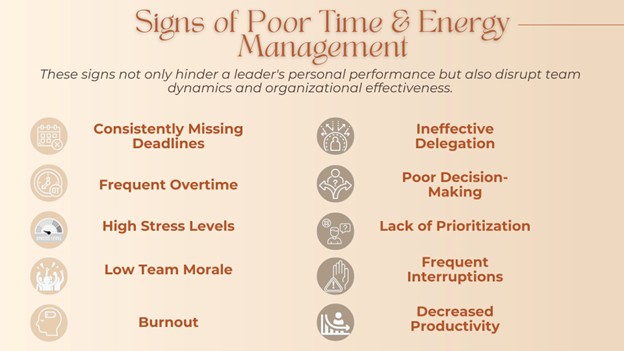
The Value of Assessing Your Current State and Environment
Understanding and evaluating your current state and environment is a fundamental step in the journey towards conscious leadership development. This evaluation lays the groundwork for optimizing time and energy management by increasing your self-awareness and consciousness on various levels, which are crucial for personal growth, development, and well-being, as well as fostering a culture of efficiency and innovation within your organization. Here’s why this assessment is invaluable:
Enhancement of Personal Well-Being
By meticulously assessing your current practices, you gain clarity on how your time and energy are being utilized. This self-awareness allows you to identify areas where you may be stretched too thin, leading to mental and emotional strain. Tackling these issues enables you to create a healthier work-life balance, crucial for maintaining long-term well-being and peak performance. For instance, through self-assessment, you might discover that you are spending a disproportionate amount of time on low-priority tasks, leaving little room for strategic thinking or personal activities that recharge you. By redirecting your focus, you can enhance both personal satisfaction and professional output.
Cultivation of a Focused Environment
A thorough assessment helps pinpoint distractions and sources of overwhelm in your daily routine. Studies show that ineffective time management leads to missed deadlines and poor work quality, affecting morale and productivity. By actively working to eliminate these interruptions, you foster an environment conducive to focus and concentration. This not only enhances your personal productivity but also sets a standard for your team, encouraging a collective commitment to maintaining a distraction-free workspace. Consider implementing techniques such as time-blocking or setting specific ‘focus hours’ where interruptions are minimized, thus allowing you and your team to delve deeper into tasks that require significant cognitive resources. We’ll actually be exploring techniques such as these in an upcoming chapter of this workshop.
Improvement in Efficiency and Innovation
Understanding your energy cycles and time allocation allows you to strategically plan tasks during periods of peak productivity. Efficient use of time and energy fosters a culture of innovation, as it frees up mental space for creative thinking and problem-solving. This strategic planning can be enhanced by integrating tools and resources designed to streamline workflows, thereby reducing the cognitive load on you and your team members and encouraging innovative approaches to challenges.
Creation of the Ideal State for Program Participation
Participating in the ‘Evolutionary Leader’ program requires you to be at your most receptive and engaged. By assessing and optimizing your current state and environment, you prepare yourself to fully participate in the training. This preparedness enables you to absorb the program’s teachings more effectively, setting the stage for personal growth and the development of authentic leadership skills. Imagine entering each session with a clear mind and a focused intention, ready to engage deeply with the material and discussions, thus maximizing your learning potential and leadership transformation.
Achievement of Sustainable Success
The insights gained from this assessment empower you to make informed decisions about prioritization, boundary-setting, and energy management. These skills are vital for achieving not only immediate success in the program but also long-term success in your leadership role. By embedding these practices into your daily routine, you lay a foundation for sustainable performance and innovation. This strategic approach not only ensures that you can handle current challenges but also prepares you to adapt to future demands with resilience and foresight.
In conclusion, the process of assessing your current state and environment is not merely an exercise in introspection; it is a strategic move towards becoming a more effective, conscious leader. By embracing this step, you empower yourself and your team to achieve greater efficiency, foster a culture of innovation, and drive sustainable success. Through this journey, you will transform your understanding of leadership from one of reaction to one of strategic foresight, enabling you to lead with confidence and clarity.

Case Studies
The article titled “Leadership and Time Management: Strategies for Managing Your Time Effectively” from De Mode Magazine provides insightful case studies on how prominent leaders utilize time and energy management to enhance their effectiveness:
1. Elon Musk: As the CEO of Tesla and SpaceX, Musk is renowned for his rigorous management practices. He employs a time management technique known as time blocking, where he divides his day into five-minute slots. This method allows him to manage not only his time but also his energy levels effectively, ensuring he remains focused and productive across multiple high-demand roles. By strategically scheduling his time and energy, Musk can tackle critical tasks with vigor and maintain high productivity levels.
2. Warren Buffett: The legendary investor exemplifies disciplined management of both time and energy. Buffett dedicates a significant portion of his day to reading and thinking, activities that recharge his mental energy and enhance his decision-making capabilities. His approach underscores the importance of balancing energy expenditure with restorative activities, allowing him to make strategic investment decisions with clarity and insight.
3. Angela Merkel: During her tenure as Chancellor of Germany, Merkel was praised for her ability to manage a demanding schedule while maintaining her energy levels. She focused on critical issues and often used weekends for concentrated work sessions, allowing her to recharge and approach complex challenges with renewed focus and energy.
4. Tim Cook: As the CEO of Apple, Cook is known for his meticulous planning and management of both time and energy. He starts his day early, prioritizing tasks that require high energy and allocating time for direct interactions with employees and partners. Cook’s structured approach ensures he remains engaged and energized, fostering a collaborative and innovative work environment.
These case studies illustrate that effective management of time and energy is crucial for strategic prioritization and sustained focus. By adopting such practices, leaders can enhance their decision-making capabilities, inspire their teams, and drive their organizations toward sustained success. These examples highlight the critical role of managing both time and energy in leadership, demonstrating how it can be leveraged to achieve both personal and organizational goals.
You can read the full case study here
10 Examples of Evaluating Your Current Time & Energy Management Practices
Here, we explore ten pivotal examples of evaluating your current practices to enhance your participation in the ‘Evolutionary Leader’ program as well as boost your long-term productivity.
Time Audit
Conducting a comprehensive time audit to map out your daily activities can be very eye-opening. Studies show that on average, employees spend 2.5 hours per day on distractions. By identifying where your time goes, you can reclaim these hours for more meaningful tasks. Consider using tools such as time-tracking apps or journals that provide visibility into how each segment of your day is spent, allowing you to make informed adjustments to your schedule.
Energy Peaks Identification
By tracking your energy levels throughout the day, you can identify your peak performance times. Research indicates that aligning tasks with natural energy peaks can increase productivity by 20%. This insight is helpful in scheduling demanding tasks for when you are most alert. Use energy mapping techniques to understand your daily rhythms and align high-concentration tasks with these periods to maximize output.
Distraction Analysis
Evaluating your work environment to identify common distractions can be very insightful as well. Data suggests that it takes approximately 23 minutes to refocus after an interruption. Minimizing these can significantly enhance your concentration and efficiency. Identify common interruptions and develop strategies such as setting boundaries or using noise-canceling devices to minimize their impact.
Task Prioritization Evaluation
By analyzing your task list to ensure alignment with your personal and professional goals, you can reduce stress levels by 30% and enhance overall output. Implement prioritization frameworks like the Eisenhower Box or the ABC prioritization method to ensure that your focus remains on tasks that offer the greatest value and impact.
Boundary Assessment
Assessing the boundaries you have set around your work and personal time is critical. According to studies, workplace leaders who establish clear boundaries experience a 25% reduction in work-related stress, leading to better work-life balance. Work on defining clear start and end times for work and communicating these boundaries to your team to ensure mutual respect and understanding of personal time.
Workload Management Review
Reflecting on your current workload management strategies can be helpful in implementing structured workload management that can lead to a 15% improvement in task completion rates. Consider methods such as Kanban boards or Gantt charts to visualize your workload and manage tasks more effectively.
Environmental Optimization Check
Taking the time to evaluate your physical workspace for factors that may affect productivity can result in an optimized environment that improves focus by 15%. Simple adjustments like ergonomic furniture or better lighting can make a significant difference. Conduct a workspace audit to identify and address elements that may be hindering your focus or comfort.
Technology Utilization Analysis
Examining how you use technology in your daily routine can be very helpful. Effective use of digital tools can cut down task time by 30%, freeing up energy for strategic thinking and innovation. Explore automation tools and task management software that streamline processes and reduce manual inputs.
Goal Alignment Reflection
Taking time to reflect on how your daily activities align with your long-term goals is critical. Ensuring alignment can increase motivation and reduce burnout, with aligned workplace leaders showing a 22% increase in performance. Regularly review your goals and adjust your activities to ensure they are contributing towards your desired outcomes.
Rest and Recharge Strategy Evaluation
It’s vitally important to assess your strategies for rest and recovery. Regular breaks and adequate sleep are crucial, as they can boost cognitive function by up to 40%. Develop a rest plan that incorporates short breaks throughout the day and longer periods for recuperation, ensuring sustained energy and focus.
Incorporating these examples into your self-assessment will not only prepare you for optimal participation in the ‘Evolutionary Leader’ program but also set the stage for sustainable productivity and well-being in your professional as well as your personal life. Through prioritization, boundary-setting, and mindful energy allocation, you can reduce burnout and foster an environment of focus and innovation.
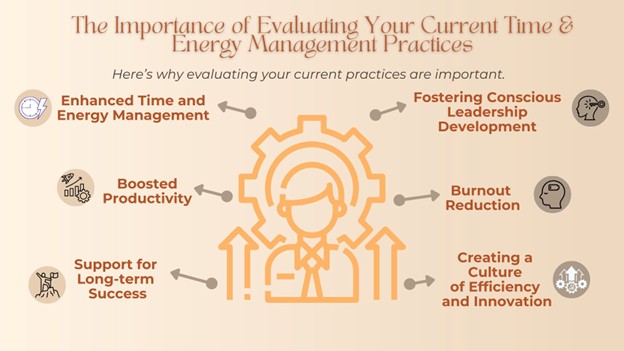
The Importance of Evaluating Your Current Time & Energy Management Practices
Here’s why these ten examples are pivotal:
Enhanced Time and Energy Management
By conducting a thorough assessment of your current practices, you can identify inefficiencies and areas where time and energy are being wasted. This awareness is the first step towards reclaiming these resources, allowing you to allocate them more effectively to tasks that truly matter.
Boosted Productivity
Each example provides a strategic approach to optimizing performance. For instance, aligning tasks with energy peaks ensures you’re working when you’re most efficient, while minimizing distractions can drastically reduce time lost to refocusing. Together, these strategies lead to a significant increase in productivity.
Support for Long-term Success
The insights gained from these assessments lay a solid foundation for ongoing growth and achievement. By understanding your current state, you can set realistic goals and develop strategies that align with your long-term vision, ensuring sustained progress.
Fostering Conscious Leadership Development
Conscious leadership development requires a deep understanding of oneself and the environment. These assessments help leaders develop self-awareness and adaptability, key traits that enable them to lead with empathy and insight, driving team performance and innovation.
Burnout Reduction
By prioritizing tasks and setting clear boundaries, these assessments help in managing workloads more sustainably. This approach not only prevents burnout but also promotes a healthier work-life balance, which is essential for maintaining long-term well-being and effectiveness.
Creating a Culture of Efficiency and Innovation
When leaders model and exemplify effective time and energy management, they set a standard that permeates their teams and the organization. This culture of efficiency enables teams to focus on innovation and creativity, with less time spent on mundane or redundant tasks.
Overall, these assessments are integral to mastering the art of focus, enabling participants to navigate the demands of leadership with confidence and clarity. By embracing these practices, leaders can enhance their capabilities, drive organizational success, and embark on a transformative journey within the ‘Evolutionary Leader’ program.
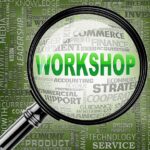
Exercise
• Share Your Insights:
• Identify Common Distractions:
• Share Strategies:

Course Manual 2: Designing Focus and Balance
Cultivating Intentionality & Taking Back Control!
In the fast-paced world of management and leadership, it often feels as though control over your daily schedule is a distant dream. With constant interruptions, unexpected challenges, and pressing staff issues, the sense of being swept away by the day’s demands can be overwhelming and deeply stressful. However, it’s important to recognize that, despite these hurdles, you can take control of your day by cultivating intentionality in your actions and decisions. This begins with a commitment to self-awareness and a conscious understanding of the people, tasks, and circumstances that shape your work environment, which is why we first covered this in the previous chapter. In this chapter, we’ll begin to take your newfound awareness and consciousness to cultivate intentionality and take back control!
The Essence of Intentionality
Intentionality involves living purposefully and making deliberate choices about how you spend your time and energy. It requires a deep understanding of your values, goals, and priorities, allowing you to align your actions with what truly matters. This conscious alignment ensures that your daily activities are meaningful and aligned with your broader life goals. By practicing intentionality, you prepare yourself to navigate the daily chaos with clarity and purpose, which involves setting clear boundaries and priorities, ultimately allowing you to manage your time more effectively and focus on what truly matters.
Steps to Cultivate Intentionality
Intentionality requires preparation and practice. Start by envisioning your desired ideal state and environment and then take small, deliberate steps to bring it to life. This might mean carving out time for deep work, scheduling regular breaks to recharge, or being mindful of how you allocate your energy throughout the day. Such practices not only enhance your productivity but also reduce the stress associated with feeling out of control of your schedule and what happens throughout your workday. Defining your ideal state and environment may seem like a daunting task, but it can also be extremely freeing and fun!
Transforming Vision into Reality
With intentional focus, you can transform this vision into reality. By aligning your work environment with your aspirations, you create a space that supports concentration, creativity, and leadership growth. As you develop this ideal state, you empower yourself to lead with confidence and foster a culture of mindfulness and efficiency within your organization. Intentional practices not only serve your personal well-being but also contribute to long-term organizational success, paving the way for a leadership style that is both effective and sustainable.
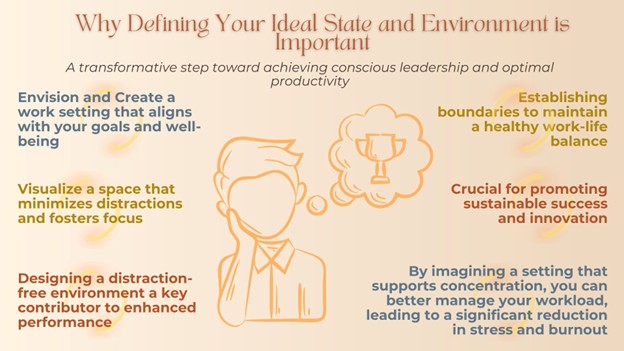
Why Defining Your Ideal State and Environment is Important
In the “Focus Enhancement” workshop, the importance of ‘Designing Focus and Balance’ comes to the forefront as a transformative step toward achieving conscious leadership and optimal productivity. After evaluating your current practices, this chapter encourages you to envision a work setting that aligns with your goals and well-being, a critical exercise in today’s fast-paced and often overwhelming work environment.
Defining your ideal state and environment is necessary because it allows you to visualize a space that minimizes distractions and fosters focus. Statistics reveal that workplace distractions can reduce productivity by up to 40%, making the ability to design a distraction-free environment a key contributor to enhanced performance. By imagining a setting that supports concentration, you can better manage your workload, leading to a significant reduction in stress and burnout.
Establishing Boundaries for Better Balance
This step also emphasizes the importance of establishing boundaries to maintain a healthy work-life balance. Studies indicate that individuals with clear boundaries experience a 25% improvement in work-life satisfaction. By articulating your ideal state, you set priorities that align with both your professional duties and personal well-being, reducing overcommitment and the stress of unclear expectations. This clarity empowers you to focus on essential tasks and manage your time more effectively, ultimately allowing you to concentrate on your core responsibilities.
Furthermore, defining your ideal environment is crucial for promoting sustainable success and innovation. Envisioning a workspace tailored to your needs encourages creative thinking, helping you to optimize energy use and productivity. This forward-thinking approach addresses inefficiencies and fosters a culture of continuous improvement and innovation. By identifying what success looks like for you, you can create a strategic roadmap to achieve it, supporting your journey toward conscious leadership and long-term organizational success.
Empowerment Through Visualization
Defining your ideal state and environment is a vital exercise that enhances focus, reduces burnout, and fosters a culture of innovation. It empowers you to set boundaries and prioritize effectively, paving the way for a sustainable and successful leadership journey in the ‘Evolutionary Leader’ program.
Transitioning from Reactivity to Proactivity
In the demanding world of workplace management, leaders often find themselves operating from a place of reactivity due to a multitude of responsibilities and the need to oversee various team members and tasks. While reactivity may seem necessary in the short term, its long-term effects can be detrimental both personally and organizationally. Reactivity can lead to heightened stress levels, eventually manifesting as physical ailments such as fatigue and burnout. Mentally and emotionally, constant reactivity can cause decision-making paralysis and reduced creativity, impairing a leader’s effectiveness. Moreover, an organization that operates reactively may suffer from poor workplace culture, as teams become accustomed to constant firefighting rather than strategic planning, leading to decreased morale and productivity.
The Shift to Proactivity
Conversely, adopting a proactive approach is crucial for enhancing a leader’s effectiveness and productivity. Proactivity involves anticipating challenges and opportunities, allowing leaders to strategize and allocate resources efficiently before issues arise. This shift not only aids in personal well-being—through reduced stress and improved focus—but also fosters a culture of innovation and forward-thinking within the organization. Statistics indicate that proactive teams are 31% more productive, as they are better at managing their workload and prioritizing tasks that align with their strategic goals. By transitioning to a proactive mindset, leaders can create a more balanced work environment that promotes sustainable success.
Strategies for Proactive Leadership
To achieve this proactive state, leaders must prioritize effective time and energy management. This involves setting clear boundaries, defining priorities, and consciously allocating energy to tasks that drive the organization forward. In doing so, leaders can enhance their own productivity and lay the groundwork for a workplace culture that values strategic planning and continuous improvement. As participants in the ‘Evolutionary Leader’ program’s Focus Enhancement workshop, you will learn to craft your ideal state and environment, enabling you to operate with greater clarity and purpose. This proactive approach not only addresses inefficiencies but also supports your journey towards conscious leadership and long-term organizational success.
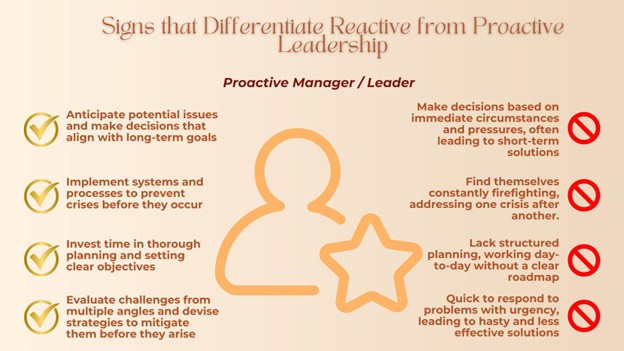
Signs that Differentiate Reactive from Proactive Leadership
Decision-Making Style: Reactive leaders tend to make decisions based on immediate circumstances and pressures, often leading to short-term solutions. In contrast, proactive leaders anticipate potential issues and make decisions that align with long-term goals.
Crisis Management: Reactive managers often find themselves constantly firefighting, addressing one crisis after another. Proactive managers, however, implement systems and processes to prevent crises before they occur.
Planning Habits: Reactive leaders may lack structured planning, working day-to-day without a clear roadmap. Proactive leaders invest time in thorough planning and setting clear objectives.
Response to Challenges: Reactive managers are quick to respond to problems with urgency, which can sometimes lead to hasty and less effective solutions. Proactive managers evaluate challenges from multiple angles and devise strategies to mitigate them before they arise.
Communication Style: Reactive leaders often communicate in response to issues as they surface, whereas proactive leaders maintain open and continuous communication to pre-empt misunderstandings and align team objectives.
Time Management: Reactive individuals often feel overwhelmed by an endless list of tasks. Proactive individuals prioritize and delegate effectively, ensuring they focus on tasks that align with strategic goals.
Adaptability: Reactive leaders may struggle to adapt to new situations, often being caught off guard. Proactive leaders anticipate changes and prepare their teams to adapt smoothly, fostering a culture of agility and resilience.

Case Studies
The case studies on intentionality and proactivity in leadership offer valuable insights for enhancing organizational effectiveness.
The first study on Satya Nadella’s tenure at Microsoft underscores how intentional leadership can drive cultural transformation. By fostering a growth mindset and encouraging innovation, Nadella’s intentionality resulted in a significant cultural shift, enhancing collaboration and creativity within Microsoft. You can read the full case study here
The second study reveals the impact of leader proactivity on follower proactivity, highlighting mechanisms like role breadth self-efficacy and felt responsibility for constructive change. This demonstrates that proactive leadership can elevate team performance and promote an innovative work environment.
You can read the full case study here
The third study on time and energy management from Herrmann International emphasizes the importance of integrating energy management with time management to enhance productivity. It distinguishes between time management, which focuses on efficiently using finite time, and energy management, which involves optimizing one’s energy levels for peak performance. The study highlights the Whole Brain® Thinking framework, which helps individuals understand their thinking preferences and align tasks with their energy patterns. By managing energy effectively, teams can improve focus, reduce burnout, and achieve better results. Techniques like identifying energy patterns, setting mini-goals, taking regular breaks, managing cognitive load, and creating flow-state routines are recommended to maximize productivity and well-being.
You can read the full case study here
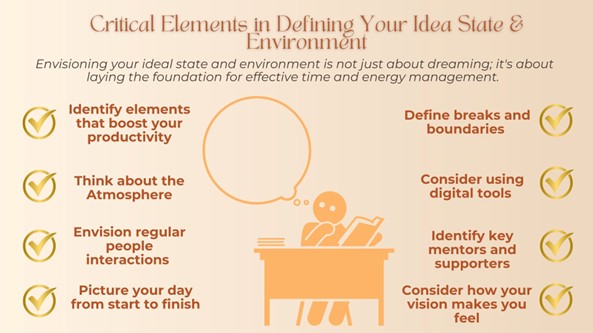
Critical Elements in Defining Your Ideal State and Environment
Let’s explore the critical elements to consider when crafting an environment and induced state that is ideal in enhancing your leadership capabilities and supports your personal and professional growth.
Identify Elements That Boost Your Productivity
Begin by identifying the key factors that enhance your productivity. This could include quiet spaces for deep work, access to natural light, or specific tools and resources that streamline your tasks. Understanding these elements allows you to design a workspace that supports your efficiency and effectiveness.
Think About the Atmosphere
Consider the atmosphere of your ideal work environment. Is it vibrant and energetic, or calm and serene? The atmosphere you choose should align with your work style and the tasks at hand, fostering an environment where you can thrive.
Envision Regular People Interactions
Reflect on the types of interactions you wish to have with colleagues and team members. Is collaboration a priority, or do you need periods of focused solitude? Clearly defining these interactions helps in maintaining a balanced and productive work dynamic.
Being aware of how others energy affects you and how you recharge your own energy – whether you are an introvert, an extrovert or are somewhere in between, is important to know and consider as well in defining how you interact with others. Introverts often recharge through solitude and may find large group interactions draining, while extroverts typically gain energy from social engagement and collaborative environments.
By recognizing how you recharge and how others’ energy influences you, you can tailor your interactions to suit your natural tendencies. This awareness not only enhances personal well-being but also optimizes your ability to contribute effectively within your team. Whether you need to schedule quiet time for focused work or thrive in dynamic group settings, aligning your work environment with your energetic needs ensures sustained productivity and a harmonious balance in professional interactions.
Picture Your Day from Start to Finish
Visualize your ideal day from morning routines to end-of-day reflections. This element helps in structuring your day to maximize energy and focus, ensuring you are prepared to tackle tasks efficiently and effectively.
Define Breaks and Boundaries
Establish clear boundaries in order to avoid overwhelm and ultimately burnout. Determine when and where breaks will occur to recharge and maintain productivity. Defining these boundaries is crucial for sustaining energy levels and preventing burnout.
Consider Using Digital Tools
Leverage digital tools and technologies that can enhance productivity and efficiency. Whether it’s project management software or communication platforms, these tools can help streamline processes and improve collaboration.
Identify Key Mentors and Supporters
Recognize the mentors and supporters who can assist you in your leadership journey. These individuals provide valuable insights and encouragement, helping you navigate challenges and seize opportunities for growth.
Consider How Your Vision Makes You Feel
Finally, reflect on the emotional response your ideal state evokes. Does it inspire motivation and excitement, or does it feel overwhelming? Adjust your vision to ensure it is both aspirational and attainable, promoting a positive emotional state that fuels your success.
By focusing on these critical elements, you can define an ideal state and environment that supports your leadership development and enhances your ability to manage time and energy effectively. This process not only prepares you for the ‘Evolutionary Leader’ program but also lays a foundation for sustained achievement in your professional life.

Exercises
1. Divide into Small Groups (2-4 participants per group):
2. Reflect on Intentionality:
3. Discuss and Share Insights:
4. Create a Vision Board:
5. Present and Reflect:

Course Manual 3: Creating Leader Role Clarity
Bridging the Gap: From Where You Are to Where You Want to Be
Now that we’ve mapped out your current practices in time and energy management and identified your aspirations, it’s time to start bridging that gap. This journey is pivotal not just for your personal well-being but also for cultivating a workplace culture that thrives on efficiency, focus, and innovation. As a leader, you’re undoubtedly managing a packed schedule, but this program is here to help you optimize your participation and maximize your results by fostering an ideal environment free from distractions and overwhelm.
Bridging this gap involves mastering the art of prioritization, boundary-setting, and intentional energy allocation. These skills are not just theoretical; they are the building blocks for enhancing productivity, reducing burnout, and laying a solid foundation for your journey in conscious leadership development. By understanding and implementing these strategies, you empower yourself to manage your responsibilities with greater clarity and purpose.
As we delve into the ‘Creating Leader Role Clarity’ chapter, consider this your opportunity to transform how you approach your role. Embrace this chance to refine your time and energy management, thereby driving personal and professional success.
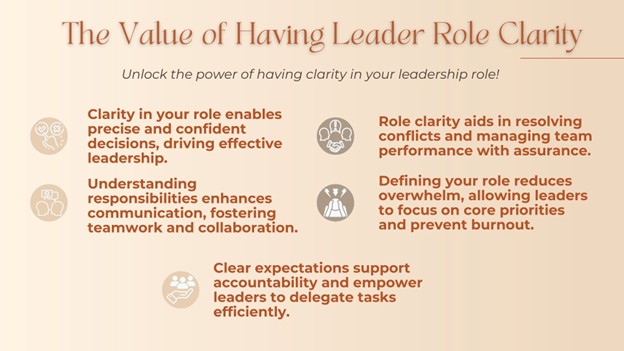
What is Leader Role Clarity?
Stepping into a leadership role can often feel like navigating uncharted territory, filled with uncertainty and questions about expectations. If you find yourself unsure about your role and responsibilities, know that you’re not alone. Many leaders experience this sense of being adrift, especially when first transitioning into leadership or taking on new positions.
At the heart of overcoming this challenge lies the concept of leader role clarity. This crucial element involves having a clear understanding of what is expected of you in your leadership role and the responsibilities you are tasked with. Achieving this clarity is vital, as it serves as the foundation upon which effective leadership is built.
When you possess leader role clarity, you empower yourself to make informed decisions and communicate effectively with your team. It fosters a culture of accountability and enables you to delegate tasks with confidence, ensuring that each team member is contributing to shared goals. Furthermore, clarity in your role aids in handling conflicts with composure and managing diverse personalities within your team, enhancing overall performance.
Through this understanding, you will also be better equipped to set personal and professional boundaries, prioritizing tasks that align with your core responsibilities. This not only reduces feelings of overwhelm but also allows you to manage your workload sustainably, preventing burnout and maintaining focus.
In this journey towards achieving role clarity, remember that this is your path to becoming a more effective leader. Embrace the opportunity to define your role with precision, as it will lead to more harmonious team dynamics and a thriving workplace culture. With clarity, you will be ready to inspire and lead your team with confidence, driving both personal and organizational success.
The Need for Leader Role Clarity: Enhancing Efficiency and Satisfaction
Understanding why leader role clarity is essential will not only transform your leadership experience but will also significantly impact the overall success of your team and organization. In today’s dynamic work environment, clarity in job roles, especially in leadership roles, is more crucial than ever.
Statistics reveal that employees who have role clarity are 53% more efficient and 27% more effective in their work. This clarity leads to a 25% improvement in overall work performance, underscoring the importance of having a well-defined understanding of your responsibilities and expectations. Moreover, 75% of employees with high role clarity report greater job satisfaction, which is pivotal in maintaining a motivated and engaged workforce.
However, achieving this clarity has become increasingly challenging. Many workplace employees, including managers and leaders, face the issue of vague and overly general job descriptions, which offer little guidance or direction. This lack of specificity creates confusion and undermines the ability to hold each other accountable. It often results in a blame culture, where finger-pointing and the “that’s not my job” mentality prevail.
Role clarity in every employee role, but especially in management and leadership roles, is vital for fostering accountability and reducing these counterproductive behaviors. When leaders have a clear understanding of their roles, they can set precise goals, delegate effectively, and ensure that team responsibilities are aligned. This clarity not only enhances decision-making by providing clear guidelines and expectations but also cultivates a culture of trust and collaboration, where each team member knows their contribution towards shared goals.
Embracing role clarity is not just about personal growth; it’s about shaping a productive and harmonious work environment. By committing to this clarity, you pave the way for increased efficiency, innovation, and satisfaction within your team, driving both individual and organizational success.
Determining, Clarifying, and Understanding Key Objectives for Your Role
In the dynamic landscape of leadership, understanding the key objectives of your role is fundamental for achieving clarity and focus. A well-crafted job description can serve as a roadmap, outlining your primary responsibilities and helping you align your efforts with organizational goals. However, the journey towards role clarity doesn’t end with a document; it is enhanced through ongoing dialogue with your manager or director, ensuring that your understanding is aligned with the strategic vision of the organization.
Statistics reveal that leaders with clear role objectives are 53% more efficient in their duties and experience a 25% improvement in overall work performance. This clarity not only reduces stress but also fosters a work environment where goals are transparent and achievable. Engaging in meaningful conversations with your manager allows you to refine your objectives, understand expectations, and align your role with the broader organizational strategy.
When you take the time to determine and clarify your role’s key objectives, you empower yourself to prioritize tasks that are crucial for success. This focus reduces the risk of overwhelm and burnout, as you can set boundaries that prevent overcommitment. A clear understanding of your objectives also enhances your ability to communicate effectively with your team, fostering a sense of purpose and direction.
Moreover, these conversations with your manager or director are pivotal in identifying opportunities for personal and professional growth. By understanding the goals and challenges of your role, you can tailor your development efforts to address these areas, ensuring that you are equipped to meet the demands of leadership with confidence and competence.
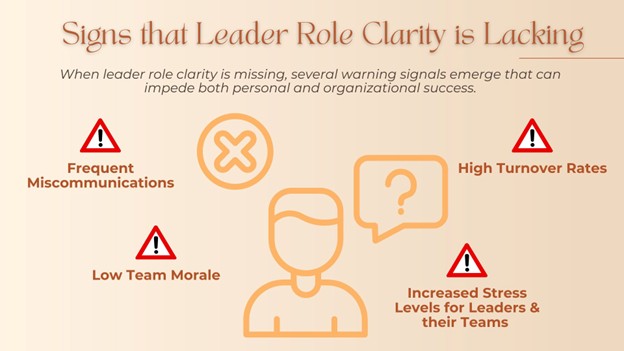
Signs that Leader Role Clarity is Lacking: Identifying the Red Flags
Recognizing the signs of lacking leader role clarity is crucial for any leader aiming to enhance their leadership effectiveness and foster a positive team environment. When clarity is missing, several warning signals emerge that can impede both personal and organizational success.
One of the most telling signs of unclear leadership roles is frequent miscommunications. Teams where roles are not clearly defined often experience confusion about responsibilities, which leads to messages being misunderstood or tasks being duplicated. This not only wastes time but also creates frustration among team members, hindering productivity.
Low team morale is another indication that leaders may lack role clarity. When team members are unsure about their or their leaders’ roles, it can lead to a lack of direction, resulting in decreased motivation and engagement. This uncertainty fosters an environment where team dynamics suffer, ultimately affecting performance and innovation.
High turnover rates are often symptomatic of role ambiguity. According to recent studies, workplaces with clear role definitions report significantly lower turnover rates, as employees feel more satisfied and valued in their positions. Conversely, when roles are not well-defined, employees are more likely to leave in search of environments where expectations are clear and achievable.
Increased stress levels are also prevalent in organizations where leader role clarity is lacking. Unclear expectations can lead to an overwhelming workload, as leaders struggle to prioritize tasks and manage their teams effectively. This stress not only affects leaders but trickles down to their teams, creating a high-pressure atmosphere that can lead to burnout.
It’s essential to address these signs proactively to improve leadership effectiveness and team dynamics. By establishing clear roles and responsibilities, leaders can reduce miscommunications, boost morale, and decrease turnover rates. Cultivating an environment of clarity empowers leaders and their teams to work more efficiently, fostering a culture of trust and collaboration.

Case Studies
In exploring the importance of leader role clarity, these case studies demonstrate how clear job definitions and supportive environments significantly enhance both organizational performance and employee well-being.
The article “Crystal Clear: How Leaders and Coworkers Together Shape Role Clarity and Well-being for Employees in Social Care” explores the impact of leader role clarity on employee well-being in the social care sector. It highlights the importance of coworker support and leader role clarity in enhancing role clarity among employees and leaders. The study found that coworker instrumental support significantly boosts role clarity, which in turn reduces psychological distress and change fatigue while increasing job satisfaction. The positive effects of coworker support on role clarity are amplified when leaders themselves have clear role definitions. This research underscores the critical role of a supportive work environment in fostering role clarity and improving mental health outcomes for employees in high-stress sectors like social care.
You can read the full case study here
The case study from Kn/a HR Consulting highlights the significance of role clarity in organizations, particularly during periods of growth and change. The study involved a role clarity exercise for an organization facing challenges due to new hires and internal promotions, which led to confusion over job duties and supervisory roles. Kn/a HR developed a tool to help departmental teams identify key job objectives and assess whether current duties aligned with these goals. Through group workshops, team members identified inefficiencies and redefined roles, leading to streamlined operations, elimination of unnecessary tasks, and creation of new job descriptions. This process not only clarified roles but also enhanced strategic focus and accountability within the organization. The organization committed to revisiting this exercise annually to maintain clarity and efficiency.
You can read the full case study here
The case study from IPC Consultants focuses on enhancing role clarity through a structured job evaluation in the manufacturing sector. The process involved developing clear job descriptions to eliminate uncertainties in duties and decision-making levels, thereby reducing role duplication and optimizing resource utilization. Employees participated in creating job descriptions, which increased their satisfaction and engagement. The exercise led to improved organizational performance by aligning roles with strategic objectives. This approach demonstrated that clear and precise role definitions enhance performance and efficiency, highlighting the critical role of job evaluation in achieving organizational alignment and productivity.
You can read the full case study here
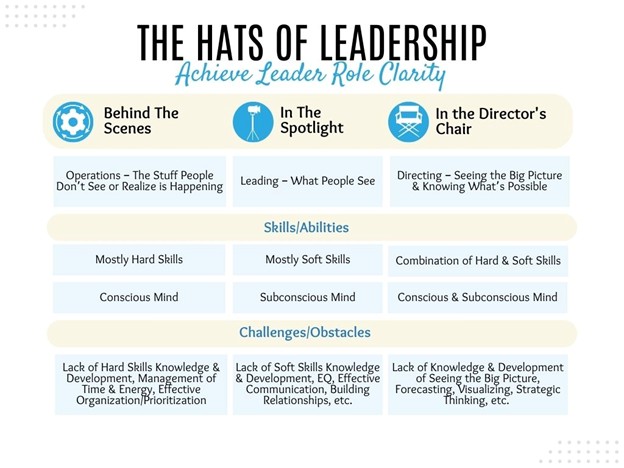
Creating Leader Role Clarity with the ‘Hats of Leadership’ Framework
The “Hats of Leadership” framework is a powerful tool designed to help leaders navigate the multifaceted expectations of their roles with clarity and confidence. It breaks down leadership responsibilities into three distinct aspects or “buckets”: “Behind the Scenes,” “In the Spotlight,” and “In the Director’s Chair.” This structured approach not only clarifies what is expected from leaders but also helps them prioritize tasks and develop the necessary skills to excel in each area.
Statistics show that leaders who have a comprehensive understanding of their roles are 60% more effective in decision-making and experience a 35% increase in team productivity. The “Hats of Leadership” framework is instrumental in achieving this clarity, providing leaders with a roadmap to manage their responsibilities effectively.
The Three Buckets of Clarity:
Understanding and mastering the three buckets of the “Hats of Leadership” framework is crucial for enhancing leadership effectiveness and driving organizational success. These aspects help leaders ensure operational efficiency, foster team engagement, and implement strategic vision. By excelling in these areas, leaders can cultivate a productive work environment, inspire their teams, and strategically steer their organizations towards long-term achievements.
Bucket #1: Behind the Scenes
This bucket focuses on the operational backbone that keeps a leader’s department, and ultimately the organization, running smoothly. It includes tasks such as budgeting, planning, and logistics, emphasizing the need for attention to detail, problem-solving, and analytical thinking. Statistics indicate that leaders who excel in operational management can boost organizational efficiency by up to 23%. By mastering these behind-the-scenes activities, leaders ensure a stable foundation for their team, allowing for seamless operations and fewer disruptions.
Bucket #2: In the Spotlight
“In the Spotlight” captures the visible and interpersonal aspect of leadership, where guiding, inspiring, and motivating others takes center stage. This includes public speaking, team building, and mentorship. Skills such as charisma, emotional intelligence, and communication are vital here. Research has shown that leaders who effectively engage their teams can increase employee satisfaction and loyalty by 45%. Being adept in this area enables leaders to cultivate trust and inspire their teams, driving engagement and enhancing performance even under challenging circumstances.
Bucket #3: In the Director’s Chair
The third bucket, “In the Director’s Chair,” is about strategic vision and long-term planning. It involves tasks like trend analysis, forecasting, and strategic decision-making. Leaders must employ strategic thinking, innovation, and adaptability to succeed here. Data suggests that organizations led by visionary leaders see a 33% higher likelihood of achieving their strategic goals. By seeing the big picture and aligning departmental objectives with the organization’s vision, leaders can anticipate future challenges and steer their teams towards sustained success.
By categorizing their tasks and responsibilities into these three areas, leaders can transform their overwhelm and confusion into clarity and focus.
Illuminates the Skills & Abilities You Need to Excel:
The “Hats of Leadership” framework not only defines the various responsibilities within a leadership role but also illuminates the specific skills and abilities needed to excel in each area. The framework is instrumental in identifying the skills necessary for leadership, distinguishing between hard and soft skills across its three aspects. This approach allows leaders to focus their development efforts, enhancing both hard and soft skills for greater effectiveness.
In the “Behind the Scenes” bucket, leaders engage in operational management and logistics, utilizing a combination of hard and soft skills. Hard skills like analytical thinking and budgeting are essential for resource management, with leaders proficient in these areas achieving up to a 23% increase in operational efficiency. Attention to detail and problem-solving represent the critical soft skills that ensure smooth and effective operations.
“In the Spotlight” focuses on the interpersonal and visible aspects of leadership, heavily relying on soft skills such as charisma, emotional intelligence, and communication. These skills are crucial for inspiring and motivating teams, yet they are often the least developed, making this the area where leaders typically need the most growth. Leaders who excel in these soft skills can see team loyalty and engagement rise by up to 45%. Public speaking, a hard skill, complements these abilities by allowing leaders to effectively communicate their vision.
The “In the Director’s Chair” bucket emphasizes strategic vision and planning, requiring a blend of hard and soft skills. Strategic thinking and trend analysis are key hard skills that help leaders plan for future challenges. Innovation and adaptability are vital soft skills that enable leaders to adjust and drive success, with strategic leaders having a 33% greater likelihood of achieving their goals.
By leveraging the “Hats of Leadership” framework, leaders can accurately identify their strengths and areas for improvement in both hard and soft skills. This clarity promotes targeted development, ensuring leaders are well-equipped to fulfill their roles successfully. Cultivating these skills fosters a thriving organizational culture and long-term achievement.
Determine Which Part of the Brain is Engaged in Each Leadership Aspect:
The “Hats of Leadership” framework is not only about clarifying roles and responsibilities but also about understanding how different aspects of leadership engage various parts of the brain – the conscious and the subconscious mind. This insight is crucial for leaders aiming to optimize their decision-making and enhance their effectiveness.
The conscious mind is the realm of active thought and focused attention, handling tasks that require deliberate effort and logical reasoning. In contrast, the subconscious mind operates below the level of conscious awareness, influencing behaviors and decisions through ingrained habits and emotional responses.
Understanding which part of the brain is primarily utilized in each leadership aspect helps leaders tailor their approach to different situations, enhancing their overall effectiveness.
Behind the Scenes: This bucket predominantly engages the conscious mind. Tasks such as budgeting, planning, and logistical management demand focused attention and analytical thinking. Leaders skilled in these areas can boost operational efficiency by 23%, as they consciously manage resources and oversee operational details with precision.
In the Spotlight: Here, the subconscious mind plays a significant role. Tasks like public speaking and team building tap into emotional intelligence and charisma—qualities that often emerge from subconscious processes. Since these skills are crucial yet frequently underdeveloped, leaders typically need the most growth in this area. Developing these subconscious-driven skills can increase team loyalty and engagement by up to 45%.
In the Director’s Chair: This bucket requires a balanced use of both the conscious and subconscious mind. Strategic visioning and planning involve conscious strategic thinking and subconscious innovation and adaptability. Leaders who effectively harness both aspects are 33% more likely to achieve their strategic goals, as they can foresee challenges and adapt creatively to changing environments.
For leaders, determining which part of the brain is engaged in each leadership aspect is vital because it allows them to refine their approach, utilizing the strengths of both the conscious and subconscious mind. This understanding aids in developing targeted strategies for personal growth, ensuring leaders can address challenges with the appropriate mindset and skills.
By leveraging the “Hats of Leadership” framework, leaders can fine-tune their cognitive strategies, leading to improved decision-making, enhanced team dynamics, and sustainable organizational success. This brain-based approach equips leaders to navigate their roles with greater clarity and confidence, fostering a thriving workplace culture.
Anticipate and Navigate Challenges & Obstacles:
The “Hats of Leadership” framework not only provides leaders with role clarity but also equips them to anticipate and navigate the challenges inherent in each leadership aspect. By understanding potential obstacles, leaders can adopt a proactive approach, enhancing their effectiveness and contributing to organizational success.
Bucket #1: Behind the Scenes
This aspect focuses on operational tasks such as budgeting, planning, and logistics, which demand high levels of organization and attention to detail. A common challenge in this bucket is balancing competing priorities. Leaders who can anticipate these demands are better positioned to manage resources efficiently, reducing disruptions and improving organizational efficiency by up to 23%. By proactively addressing these challenges, leaders ensure a stable operational foundation that supports their team’s success.
Bucket #2: In the Spotlight
This bucket involves the interpersonal and visible facets of leadership, like inspiring and motivating teams. The key challenge here is maintaining team engagement under scrutiny. Leaders often face the obstacle of cultivating trust and loyalty, especially in challenging situations. By understanding these dynamics, leaders can proactively develop their soft skills, such as emotional intelligence and communication, which can enhance team satisfaction and loyalty by 45%. Anticipating these challenges allows leaders to inspire confidence and drive team performance successfully.
Bucket #3: In the Director’s Chair
Strategic vision and long-term planning are at the core of this bucket. Leaders must contend with the challenge of adapting to market changes and aligning their strategies with the organization’s vision. Those who are adept at forecasting trends and anticipating future challenges are 33% more likely to achieve strategic goals. By proactively engaging in strategic thinking and innovation, leaders can navigate these obstacles, ensuring that their teams are prepared for tomorrow’s challenges.
Understanding the challenges associated with each leadership aspect empowers leaders to plan and implement effective strategies, reducing reactivity and enhancing decision-making. This proactive approach, fostered by the “Hats of Leadership” framework, not only mitigates potential setbacks but also strengthens leadership capacity, leading to improved team dynamics and sustained organizational growth. By anticipating and overcoming these challenges, leaders can cultivate a resilient and innovative workplace, driving long-term success.

Further Leveraging the “Hats of Leadership” Framework:
The “Hats of Leadership” framework is an invaluable tool in helping leaders not only gain clarity in their current roles but also in navigating transitions, shifts, and significant leaps throughout their careers. The framework’s structured approach assists leaders in understanding how to adapt and grow as they encounter various stages of their leadership journey.
Navigating Transitions and Shifts
Leaders often face transitions, whether moving to a new role, team, or even industry. The “Hats of Leadership” framework aids in these transitions by providing a clear understanding of the different skill sets and mindsets required in each leadership aspect. For example, transitioning from an operational focus “Behind the Scenes” to a more strategic role “In the Director’s Chair” requires a shift from detailed logistical thinking to strategic visioning. Leaders who use this framework to anticipate such shifts experience 30% less transitional stress and are 45% more likely to succeed in new roles.
Taking Leaps in Leadership
As leaders seek to elevate their careers or take new leaps, the framework supports identifying and developing the necessary competencies. Whether it’s stepping into a more visible role “In the Spotlight” or expanding strategic influence “In the Director’s Chair,” the framework helps leaders pinpoint areas needing focus and growth. Leaders who actively pursue development in these areas can increase their leadership effectiveness by up to 40%, fostering a smoother transition into elevated responsibilities.
Personal Growth and Career Development
Beyond role clarity, the “Hats of Leadership” framework encourages personal growth by illuminating paths for continuous development. It serves as a guide for leaders to assess their competencies against the demands of their desired career path. By regularly evaluating strengths and weaknesses across the framework’s buckets, leaders can create personalized development plans that align with their career aspirations, significantly enhancing their readiness for future opportunities.
Additional Benefits
The framework also offers unexpected advantages by promoting self-awareness and emotional intelligence. Leaders who engage with the framework often report increased self-confidence and resilience, contributing to both personal and organizational success. Through its comprehensive nature, the “Hats of Leadership” framework empowers leaders to embrace change proactively, ensuring they are equipped to handle the evolving dynamics of their careers and industries.
By leveraging the “Hats of Leadership” framework, leaders not only improve their current effectiveness but also prepare themselves for future challenges and opportunities, facilitating a culture of growth, adaptability, and innovation within their organizations.

Exercise
• Assign Roles: Within your group, assign one person to each “Hat” and the rest as observers.
• If you’re wearing a “Hat,” take 2 minutes to reflect on how it manifests in your current role. Discuss:
o What tasks and responsibilities align with your “Hat”?
o How does this role enhance team productivity and morale?
o What skills and abilities are crucial for excelling in this area?

Course Manual 4: Focused Clarity
Transforming Role Clarity into Strategic Goals & Priorities
As you embark on Chapter 4: Focus Clarity, you are building on the strong foundation of leader role clarity established in the previous chapter. This progress marks a significant step toward optimizing your time and energy management practices. With a clearer understanding of your role, you are now poised to take another crucial leap forward by setting well-defined goals and priorities.
This chapter is designed to take yet another step closer to bridging the gap between where you currently stand in managing your time and energy and where you aspire to be. By setting clear goals and priorities, you empower yourself to focus on the tasks that truly matter, ensuring your efforts are directed towards high-impact activities that align with your strategic objectives. This structured approach not only helps in managing your workload more effectively but also reduces the stress and overwhelm that often accompany a busy leadership role.
In this chapter, you are encouraged to leverage the insights and clarity gained from previous exercises. By setting meaningful goals and priorities, you lay the groundwork for achieving both personal and organizational success, strengthening your journey toward becoming a conscious leader capable of driving long-term growth and innovation.
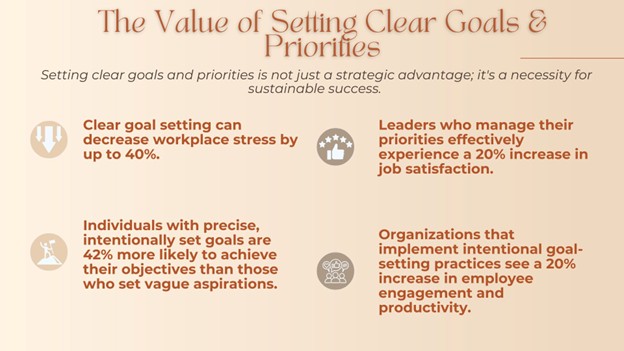
Why Setting Clear Goals & Priorities is Needed
In the ever-evolving landscape of leadership, setting clear goals and priorities is not just a strategic advantage; it’s a necessity for sustainable success. Research indicates that leaders who set specific goals are 30% more likely to achieve significant outcomes compared to those who do not. This clarity allows leaders to navigate the complexities of their roles with precision and purpose.
Clear goals and priorities serve as a compass, guiding leaders through daily tasks and long-term projects. By defining what truly matters, leaders can allocate their time and energy more effectively, reducing the noise of distractions and focusing on high-impact activities. This targeted approach enhances productivity and minimizes the risk of burnout, a concern highlighted by studies showing that clear goal setting can decrease workplace stress by up to 40%.
Moreover, establishing well-defined priorities fosters a culture of efficiency and innovation within organizations. Teams that operate under clear directives are 25% more productive, as they understand their objectives and how their efforts contribute to broader organizational goals. This alignment not only boosts morale and engagement but also drives collective achievement.
Prioritization is crucial for maintaining work-life balance. By identifying tasks that can be delegated, leaders can manage their workload sustainably, ensuring they dedicate time to both professional responsibilities and personal well-being. This balance is vital, as it supports mental health and reduces the likelihood of burnout, with data suggesting that leaders who manage their priorities effectively experience a 20% increase in job satisfaction.
The Power of Intentional Goal Setting
In the dynamic environment of leadership, the power of intentional goal setting stands as a pivotal factor for success. Unlike the common approach where goals are often vaguely defined and lack strategic alignment, intentional goal setting is a deliberate process that ensures clarity, specificity, and measurable outcomes. This distinction is crucial, as studies show that individuals with precise, intentionally set goals are 42% more likely to achieve their objectives than those who set vague aspirations.
Intentional goal setting involves crafting goals that are not only specific but also measurable, attainable, relevant, and time-bound (SMART). This approach helps leaders to focus their efforts on what truly matters, driving both personal and organizational growth. By aligning goals with broader strategic objectives, leaders can create a clear roadmap for success that encourages accountability and progress tracking.
A critical component of intentional goal setting is its ability to foster motivation and commitment. When goals are well-defined and aligned with personal values and organizational missions, leaders and their teams are more engaged and inspired to take action. This alignment is supported by data indicating that organizations that implement intentional goal-setting practices see a 20% increase in employee engagement and productivity.
Furthermore, intentional goal setting helps to mitigate the common pitfalls of procrastination and distraction. By prioritizing tasks that directly contribute to strategic outcomes, leaders can better manage their time and energy, reducing the likelihood of burnout. Research reveals that leaders who adhere to intentional goal-setting frameworks experience a 25% reduction in stress and overwhelm, enabling them to maintain a sustainable work-life balance.
Incorporating intentional goal setting into leadership practices is not just about achieving immediate targets; it’s about cultivating a culture of precision, focus, and continuous improvement. By setting clear, intentional goals, leaders are empowered to steer their teams toward a more innovative and resilient future, ensuring that every effort contributes meaningfully to the organization’s success. This intentionality transforms aspirations into tangible results, driving both individual and collective achievement in the fast-paced world of conscious leadership.
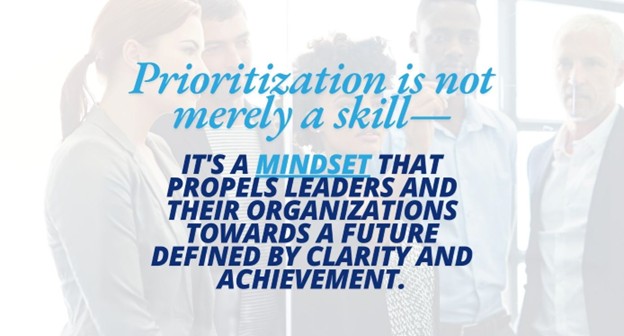
The Power of Prioritizing
In the realm of effective leadership, the power of prioritizing stands as a cornerstone for achieving strategic objectives and maximizing productivity. When leaders prioritize effectively, they are able to allocate their time and energy to tasks that yield the highest returns, both personally and organizationally. This strategic approach is not just about managing tasks—it’s about steering the entire team towards meaningful outcomes with precision and focus.
Statistics underscore the transformative impact of prioritization. Research shows that leaders who prioritize effectively can boost their productivity by as much as 25%. This increase is attributed to the ability to concentrate on high-value tasks and minimize time spent on less critical activities. By discerning the difference between what is urgent and what is important, leaders can ensure that their efforts are aligned with their strategic goals, ultimately driving the organization forward.
Effective prioritization also plays a pivotal role in stress reduction. Leaders who systematically prioritize their tasks experience a significant decrease in stress levels, as much as 30%, according to recent studies. This reduction stems from the clarity and confidence gained when leaders know their focus is on what truly matters. By having a clear hierarchy of tasks, leaders can approach their responsibilities with a sense of control and purpose, avoiding the overwhelm that comes with juggling too many priorities at once.
Moreover, prioritization enhances decision-making and facilitates swift, decisive action. When leaders prioritize effectively, they create a roadmap that guides their teams through complex projects and challenges. This clarity fosters a proactive rather than reactive culture, where teams are prepared to tackle obstacles with strategically aligned solutions. Data indicates that organizations that emphasize prioritization in their leadership practices see a 20% improvement in team collaboration and problem-solving abilities.
Lost in the Hustle: Recognizing the Signs of Unclear Goals
In the fast-paced world of leadership, the absence of clear, intentional goals can have significant repercussions for workplace managers and leaders. Recognizing the indicators of unclear goal setting is crucial in preempting potential pitfalls and steering organizations towards success.
One of the primary indicators that a leader lacks clear goals is a noticeable decline in productivity. Without clearly defined objectives, leaders and their teams often find themselves adrift, expending energy on tasks that yield minimal impact. Studies show that workplaces with poorly articulated goals can see up to a 20% reduction in productivity, as employees struggle to prioritize tasks and allocate resources efficiently.
Another telltale sign is increased stress and burnout among leaders and their teams. When goals are ambiguous or constantly shifting, it creates an environment of uncertainty and pressure. Leaders may find themselves overwhelmed by a seemingly endless list of responsibilities without a clear sense of direction. Research indicates that unclear goals contribute to a 30% increase in stress levels, as individuals grapple with the anxiety of unmet expectations and the lack of a coherent path forward.
Additionally, the lack of clear goals can lead to a diminished sense of direction and purpose within the organization. Teams without specific targets may experience a drop in morale and engagement, as they struggle to see how their efforts contribute to broader organizational success. Data highlights that companies with vague or undefined goals report 25% lower employee engagement, as workers become disengaged due to the absence of a motivating vision.
Moreover, leaders who do not set intentional goals may notice a breakdown in communication and collaboration across the team. The lack of clear objectives often results in misaligned efforts, where team members are uncertain about their roles and responsibilities. This misalignment can hinder decision-making processes and slow down progress on key projects. Organizations that fail to prioritize clear goal setting can encounter a 15% decline in team collaboration, as confusion and miscommunication persist.
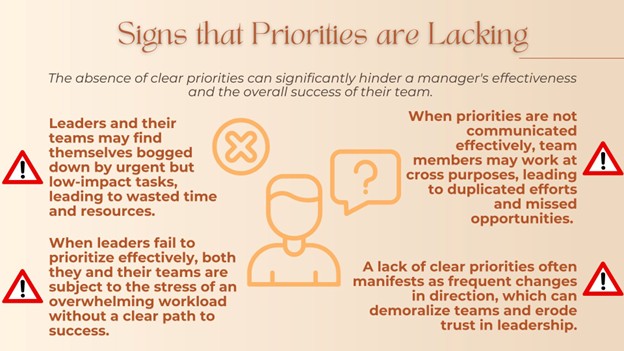
Caught in the Chaos: Unveiling the Impact of Unclear Priorities
In the demanding environment of leadership, the absence of clear priorities can significantly hinder a manager’s effectiveness and the overall success of their team. Recognizing the signs of lacking priorities is vital for initiating necessary adjustments and fostering a more organized and efficient workplace.
A key indicator that priorities are unclear is a noticeable drop in efficiency. Leaders and their teams may find themselves bogged down by urgent but low-impact tasks, leading to wasted time and resources. This inefficiency can be quantified, with studies indicating that organizations without well-defined priorities often experience up to a 30% decrease in overall productivity. Employees can become overwhelmed with tasks that do not contribute to long-term goals, resulting in a misallocation of effort.
Increased stress and burnout are other significant signs that priorities need to be reevaluated. When leaders fail to prioritize effectively, both they and their teams are subject to the stress of an overwhelming workload without a clear path to success. Research suggests that lack of prioritization can lead to a 40% increase in stress levels, as individuals grapple with the pressure of unmet deadlines and a chaotic work environment. This stress not only affects performance but also contributes to higher turnover rates, as employees seek less stressful work settings.
Misaligned efforts across the organization further highlight the absence of clear priorities. When priorities are not communicated effectively, team members may work at cross purposes, leading to duplicated efforts and missed opportunities. This misalignment can severely impact strategic initiatives, with data showing a 20% decline in successful project completion rates in organizations lacking clear priorities. Without a shared understanding of what tasks are most important, teams struggle to achieve cohesive results.
Additionally, a lack of clear priorities often manifests as frequent changes in direction, which can demoralize teams and erode trust in leadership. When leaders continuously shift focus without clear justification, it leads to confusion and a lack of confidence in the organization’s vision and mission. This instability can result in a 25% decrease in employee engagement and morale, as team members become disillusioned with the constant state of flux.

Case Study
In the ‘Case Study’ section of Chapter 4, we delve into real-world examples that underscore the transformative power of setting clear goals and priorities. These case studies provide invaluable insights into how effective goal setting can enhance leadership effectiveness and boost team performance, illustrating practical applications that drive both individual and organizational success. By examining these scenarios, leaders can better understand the strategic alignment and motivational mechanisms that clear objectives bring to the workplace.
The case study “Goal Setting in Teams: Goal Clarity and Team Performance in the Public Sector” explores the impact of clear goal setting on team performance within the Dutch public sector. The study highlights that goal clarity and self-management significantly enhance team performance. It emphasizes that clear, specific, and challenging goals activate motivational mechanisms such as direction, effort, perseverance, and strategy, which improve performance. The research also notes that while goal clarity positively affects performance, the expected moderating effects of self-management and information elaboration were not significant. This study underscores the importance of clear goals in public sector teams and suggests further exploration into goal setting’s broader dimensions and its impact on performance.
You can read the full case study here
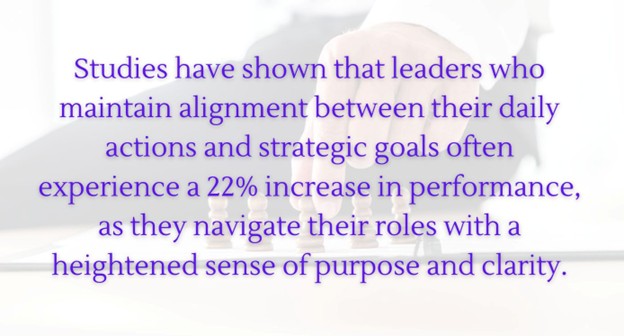
Aligning Daily Actions with Strategic Vision
Creating clear goals and ensuring their alignment with daily activities is a vital process for effective leadership. In the fast-paced environment of workplace management, aligning your daily tasks with long-term objectives can profoundly impact both your motivation and overall well-being. Studies have shown that leaders who maintain alignment between their daily actions and strategic goals often experience a 22% increase in performance, as they navigate their roles with a heightened sense of purpose and clarity.
Goal Alignment Reflection: A Pathway to Success
Reflecting on how your current activities contribute to your broader goals is an essential exercise that can illuminate areas where adjustments might be needed. This reflection assists in identifying tasks that align with your strategic objectives, helping you to streamline efforts and focus on high-impact activities. By regularly reviewing and adjusting your priorities, you can ensure that each task you undertake is meaningful and contributes to your long-term vision.
Practical Tips for Goal Alignment:
Set Clear, Strategic Goals: By defining specific, measurable, attainable, relevant, and time-bound (SMART) goals – this clarity will serve as a guiding light for your daily activities.
Schedule Regular Reflection Sessions: Dedicate time weekly to assess how your daily tasks are aligning with your strategic goals. This reflection can reveal misalignments and highlight areas for improvement.
Adjust and Prioritize: Use insights from your reflection to adjust your daily priorities. Focus on tasks that directly support your long-term goals and consider delegating or removing activities that do not contribute meaningfully.
Incorporate Feedback: Engage with your team, your boss, your colleagues and your peers for feedback on your goal alignment. Their perspectives can offer valuable insights into how your actions support collective objectives.
Monitor Progress: Establish benchmarks for success and regularly review your progress towards your goals. This monitoring not only keeps you accountable but also motivates you as you witness tangible results of your efforts.
By integrating these tips into your leadership practices, you foster a work environment that supports both personal growth and organizational success. Aligning your daily activities with long-term goals not only enhances performance but also reduces burnout, empowering you to lead with confidence and clarity in the journey towards conscious leadership.
Beyond the To-Do List: Strategic Task Prioritization
In the fast-paced world of leadership, understanding how to prioritize tasks effectively can make all the difference in achieving both personal and organizational success. The concept of ‘Priority One’ is crucial here—it represents the single most important task that will drive the most significant impact. By focusing on this priority, leaders can channel their energy and resources efficiently, cutting through the clutter of daily demands.
Task Prioritization Evaluation: A Strategic Approach
To manage tasks effectively, leaders should start by ranking them based on importance and urgency. This approach ensures that high-impact activities receive the attention they deserve, while less critical tasks can be scheduled for later or delegated to others. Delegation not only helps in managing workload efficiently but also empowers team members, fostering a collaborative environment.
Practical Tips for Prioritizing Tasks:
Identify Priority One: Each day, determine your top priority—the task that will move the needle most significantly for your team or organization. Commit to tackling this task first, setting the tone for a productive day.
Create a Prioritization System: Use a three-bucket system to categorize tasks. Bucket one holds your top priority, bucket two includes 2-3 high-priority tasks to address next, and bucket three contains lower-priority tasks to handle as time permits.
Evaluate and Adjust: Regularly review your task list to ensure alignment with your strategic goals. This evaluation helps in identifying tasks that can be delegated or dropped, significantly reducing stress and enhancing productivity.
Develop a Routine: Consistently start your day by addressing your Priority One task. This practice not only mitigates procrastination but also builds momentum for tackling subsequent tasks.
The Power of Priority One
Embracing the ‘Priority One’ strategy is a powerful antidote to procrastination. By confronting the most daunting task first, leaders can break the cycle of delay and indecision. Research indicates that beginning with the most challenging task often reveals it to be less daunting than anticipated, leading to increased satisfaction and reduced stress.
By mastering task prioritization and integrating the ‘Priority One’ approach, leaders can operate from a place of clarity and control. This strategic focus not only enhances individual performance but also drives organizational success, paving the way for a more efficient and resilient leadership journey.

Exercise
• Take a moment to think about your personal goals and tasks that contribute to this team goal.
• Jot down your key goals and consider how they fit into the bigger picture.
• Share your individual goals and tasks with your group.
• As a team, arrange these goals, aligning them under the identified team or organizational goal.
• Discuss how each person’s goals support the overarching objective and identify any gaps or overlaps.
• Work together to prioritize the tasks, determining which ones are essential for achieving the team goal.
• Adjust your individual goals as needed to ensure alignment and effective prioritization.

Course Manual 5: Time Mastery Blueprint
Continuing to Bridge the Gap: A Strategic Approach to Time Management
As we embark on Chapter 5: Time Mastery Blueprint, we continue our journey of bridging the gap between your current time management practices and your aspirations as a conscious leader. This chapter is pivotal in transforming how you allocate your time, enabling you to focus on what truly matters and paving the way for enhanced productivity and well-being.
Effective time management is not just about scheduling meetings or completing tasks; it’s about strategically aligning your time with your highest priorities like we explored in the last chapter. By allocating specific time slots based on the importance and urgency of tasks, you can ensure that your focus remains on high-impact activities that drive both personal and organizational success. This approach minimizes distractions and reduces the feeling of being overwhelmed by constant interruptions, allowing you to harness your full potential as a leader. We’ll explore this concept deeper in this chapter.
Prioritization, which we began exploring in the previous chapter, is the cornerstone of an effective time management plan. By organizing your tasks by their significance and urgency, you can tackle procrastination and maintain a steady workflow. However, true productivity is not achieved by continuous work alone. Incorporating mindful breaks and buffer times is essential to prevent burnout. These intentional pauses allow you to recharge, manage your workload sustainably, and maintain a healthy work-life balance.
Recognizing when to step back is as crucial as knowing when to push forward. By setting clear boundaries and respecting personal time, you prevent overcommitment and foster better work-life integration. This ensures that you remain alert and capable, ready to tackle demanding tasks with renewed energy and focus. We’ll also be exploring this concept deeper in this chapter.
Developing a comprehensive time management plan is a proactive step towards nurturing a culture of efficiency and innovation within your organization. By adopting a structured approach to time allocation, you not only enhance your personal productivity but also set a standard for your team to follow. This foundation supports individual growth while contributing to the long-term success and resilience of your organization.
As you progress through this chapter, you will explore strategies and tools that will help you master time management. These practices will empower you to lead yourself and your team effectively, fostering an environment where innovation thrives and sustainable success is attainable. Embrace this opportunity to refine your time management skills and watch as it transforms your leadership journey and the impact you have on those you lead.
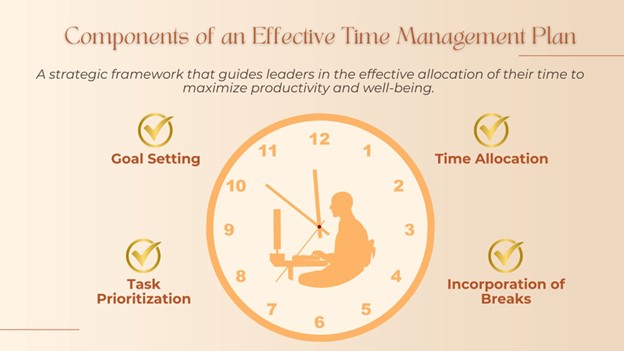
What is a Time Management Plan?
In the context of conscious leadership development, a time management plan is a strategic framework that guides leaders in the effective allocation of their time to maximize productivity and well-being. At its core, a time management plan consists of clearly defined goals, prioritized tasks, and scheduled breaks, all tailored to support both personal growth and organizational success.
Components of an Effective Time Management Plan
Goal Setting: The foundation of an effective time management plan is a set of clear, strategic goals as we discussed in the previous chapter. These goals should align with the leader’s role and the broader objectives of the organization, serving as a roadmap for daily activities.
Task Prioritization: A successful plan incorporates a system for ranking tasks by their importance and urgency. We also explored this in the previous chapter. This helps leaders focus on high-impact activities that drive strategic outcomes, minimizing time spent on less critical tasks.
Time Allocation: The plan outlines specific time slots for tasks, ensuring that each activity receives adequate attention. This structured approach helps prevent overloading and maintains a balanced workflow. We’ll be working on this concept in this chapter.
Incorporation of Breaks: Recognizing the necessity of rest, the plan includes scheduled breaks and buffer times. These pauses are vital for recharging and sustaining energy levels, preventing burnout, and maintaining a healthy work-life balance. We’ll also be working on this concept in this chapter as well.
Purpose and Benefits
A time management plan serves as a blueprint for leaders to navigate their responsibilities efficiently. By allocating time effectively, leaders can reduce stress, enhance focus, and improve productivity. This disciplined approach not only sharpens personal performance but also fosters a culture of efficiency and innovation within their teams. As leaders model effective time management, they set a standard that encourages collaboration and accountability among team members.
Aligning with Conscious Leadership Goals
In line with the principles of conscious leadership, a well-structured time management plan empowers leaders to operate with clarity and purpose. It supports personal growth by promoting self-awareness and intentional action, enabling leaders to meet challenges with resilience and inspire excellence in others. By prioritizing tasks and incorporating mindful breaks, leaders can align their daily activities with their strategic vision, contributing to the long-term success and sustainability of their organization.

Case Studies
In this section, we delve into a series of case studies that illuminate the diverse approaches leaders have adopted to master time management. These real-world examples showcase how strategic planning, prioritization, and the incorporation of mindful breaks can transform not only personal productivity but also organizational success. By examining the unique challenges and innovative solutions faced by leaders from various industries, you will gain valuable insights into crafting a time management plan that aligns with your goals and enhances your leadership effectiveness.
Case Study 1: The Executive Director’s Breakthrough
Background: Sarah, an Executive Director at a nonprofit organization, struggled with constant interruptions and overwhelming task lists. Her goal was to improve her focus and increase her organization’s impact.
Strategies Implemented: Sarah developed a time management plan prioritizing strategic initiatives. She allocated specific time blocks for deep work and incorporated short breaks to recharge. By delegating routine tasks and limiting meeting times, she maintained her focus on high-impact activities.
Challenges Faced: Initially, Sarah found it difficult to disconnect from daily operations. It was a challenge to delegate effectively and trust her team with responsibilities.
Outcomes Achieved: Within six months, Sarah reported a 40% increase in productivity and a significant reduction in stress. Her team became more autonomous, fostering a culture of accountability and innovation.
Case Study 2: The Entrepreneur’s Journey to Balance
Background: Mark, a tech entrepreneur, faced burnout from juggling multiple roles. He aimed to balance his workload while maintaining the growth trajectory of his startup.
Strategies Implemented: Mark developed a time management plan focusing on prioritization and delegation. He used the Eisenhower Box to categorize tasks and set aside weekends for rest and personal activities.
Challenges Faced: Mark initially struggled with the fear of losing control over his business by delegating critical tasks.
Outcomes Achieved: The company saw a 30% growth in revenue, and Mark achieved better work-life balance, leading to renewed creativity and strategic thinking.
Case Study 3: The Manager’s Path to Efficiency
Background: Lisa, a project manager at a manufacturing firm, was overwhelmed by the constant demand for updates and meetings. Her goal was to streamline processes and enhance her team’s output.
Strategies Implemented: Lisa implemented a time management plan that included focused work periods and regular team check-ins. She introduced “No Meeting Wednesdays” to ensure uninterrupted project time.
Challenges Faced: Resistance from some team members who were accustomed to frequent meetings.
Outcomes Achieved: Team productivity increased by 25%, and project delivery times improved. Lisa’s team appreciated the clear focus and improved communication.
Case Study 4: The CEO’s Strategic Focus
Background: Tom, the CEO of a mid-sized company, found his days filled with operational tasks that distracted from strategic planning.
Strategies Implemented: Tom crafted a time management plan that included dedicated strategic planning sessions and regular breaks to maintain energy levels. He employed executive assistants to handle day-to-day operations.
Challenges Faced: Difficulty in stepping back from operations and trusting the leadership team to make decisions.
Outcomes Achieved: The company experienced a 20% increase in strategic goal achievement, and Tom was able to focus on long-term growth initiatives.
Case Study 5: The Educator’s Innovation
Background: Emily, a high school principal, faced challenges in managing her time between administration and educational leadership.
Strategies Implemented: Emily developed a time management plan with a focus on prioritizing educational initiatives. She scheduled regular reflection breaks and collaborative sessions with her staff.
Challenges Faced: Balancing administrative duties with innovative educational programs.
Outcomes Achieved: Improved school performance and increased staff engagement were reported, attributed to Emily’s strategic focus and effective time management.
Case Study 6: The Consultant’s Transformation
Background: James, a management consultant, found his productivity hampered by frequent travel and client engagements.
Strategies Implemented: James created a time management plan that included virtual meetings and travel-free days. He scheduled regular personal time for reflection and skill development.
Challenges Faced: Adjusting clients to virtual interactions initially met some resistance.
Outcomes Achieved: James increased his client base by 15% and improved his work-life balance, leading to greater job satisfaction and client outcomes.
Case Study 7: The Nonprofit Leader’s Success
Background: Anna, the director of a nonprofit, needed to enhance her time management to focus on fundraising and organizational growth.
Strategies Implemented: Anna introduced a time management plan with set times for donor interactions and routine staff engagement. She included regular breaks to prevent burnout.
Challenges Faced: Balancing immediate operational needs with long-term fundraising efforts.
Outcomes Achieved: The nonprofit increased its funding by 25%, and Anna reported a healthier work-life balance and improved mental well-being.
The case studies presented in this section underscore the vital role of personalized time management strategies in achieving leadership excellence and fostering organizational growth. Each leader’s journey highlights the transformative impact of aligning time management practices with strategic objectives, emphasizing the importance of adaptability and intentionality. As you consider your own approach to time management, these examples serve as a reminder that a well-tailored plan can empower you to navigate challenges with confidence, inspire your team, and drive sustainable success.
What Does It Mean to Allocate Specific Time Slots?
Allocating specific time slots is a fundamental time management strategy that involves designating fixed periods for particular tasks to enhance focus and productivity. By committing to specific times for distinct activities, leaders can maintain an organized workflow, ensuring that every task receives the attention it deserves. This approach is particularly beneficial in conscious leadership, where maintaining strategic focus is essential for achieving impactful results.
For instance, leaders might allocate mornings exclusively for strategic planning and high-priority decision-making, utilizing this time for deep work with minimal interruptions. Afternoons can be dedicated to team meetings and collaborative efforts, harnessing the natural ebb of energy to engage with colleagues and address collective goals. Such structured scheduling helps create a rhythm that optimizes both individual and team productivity.
The negative impacts of shifting focus and multitasking are significant. Research shows that it takes an average of 23 minutes to refocus on a task after being distracted. This frequent interruption not only fragments attention but also increases cognitive load, reducing efficiency and heightening stress levels. Conversely, a disciplined allocation of specific time slots allows leaders to concentrate fully on single tasks, thereby enhancing output and decision-making capabilities.
Critical components of effective time slot allocation include:
Prioritization: Identifying and ranking tasks by their importance and urgency ensures that leaders focus on activities aligned with strategic objectives, maximizing the impact of each time block.
Setting Boundaries: Establishing clear boundaries around time slots helps minimize distractions and prevents less critical tasks from intruding, maintaining a steady workflow and mitigating the disruptiveness of multitasking.
Incorporating Breaks: Regular, intentional breaks are essential for sustaining energy and preventing burnout. These intervals allow for mental rejuvenation, enabling leaders to return to tasks with renewed focus and energy. Research indicates that planning your day with breaks can save up to two hours daily, underscoring their importance in maintaining peak performance.
Integrating these components into your time management strategy, allows you to effectively manage your time, energy, and focus enabling you to navigate your role with clarity and purpose, driving innovation and sustainable growth.
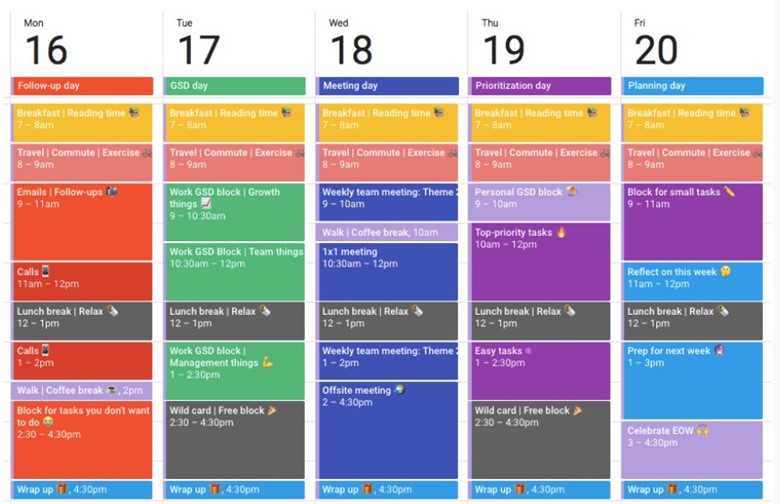
Time Allocation Techniques
Mastering time management is essential for leaders who aim to drive strategic success and foster a thriving organizational culture. This section delves into effective time allocation techniques designed to enhance productivity, focus, and leadership capabilities.
Pomodoro Technique
The Pomodoro Technique, developed by Francesco Cirillo in the late 1980s, is a time management method that enhances mental agility. This technique encourages working in short, focused sessions with regular breaks to prevent burnout and maintain high levels of concentration.
To implement, choose a task and set a timer for 25 minutes (one Pomodoro). Focus solely on the task until the timer rings. Rest for 5 minutes to recharge. After completing four Pomodoros, take a longer break (15-30 minutes).
This cycle not only manages fatigue but also keeps distractions at bay, making it an effective tool for leaders juggling multiple priorities.
Task Batching
Task batching involves grouping similar tasks together to complete them in a single time block. This reduces the cognitive load associated with task-switching and enhances efficiency.
Some examples of Task Batching include dedicating specific times to check and respond to emails rather than constantly monitoring your inbox; batch writing tasks, such as drafting reports or developing presentations, to maintain a flow of creativity; and grouping routine administrative tasks like filing, data entry, or scheduling into one session to streamline operations.
By concentrating on similar tasks, leaders can minimize distractions and maximize productivity.
Day Theming
Day theming involves allocating entire days to specific types of work or themes. This approach helps streamline focus and enhances productivity by dedicating uninterrupted time to a particular category of tasks. For example, Meeting Mondays, Project Wednesdays and Admin Fridays. This technique allows leaders to align their energy and time with their strategic objectives, fostering a more organized work environment.
Time Blocking
Time blocking involves scheduling every part of your day, including work tasks, breaks, and personal activities. This technique requires detailed planning and discipline but offers significant gains in productivity and focus.
The 2-Minute Rule
The 2-Minute Rule suggests that if a task can be completed in less than two minutes, it should be done immediately. This prevents small tasks from accumulating and becoming overwhelming. This rule helps maintain workflow momentum and reduces the mental clutter often associated with minor tasks.
How Time Allocation Minimizes Distractions
Strategic time allocation can significantly reduce distractions and alleviate feelings of being overwhelmed, thereby enhancing productivity and leadership effectiveness. As leaders strive to align their actions with their highest priorities, understanding the impact of distractions and strategies to manage them becomes crucial.
The Psychological Impact of Distractions
Leaders often face common workplace distractions such as non-urgent emails, incessant phone calls, social media alerts, and casual browsing. These interruptions can significantly impact focus, with studies indicating it takes an average of 23 minutes to regain full concentration after an interruption. This constant reorientation not only fragments attention but also increases cognitive load, leading to higher stress levels and decreased productivity. Implementing a structured time allocation approach can help mitigate these interruptions.
Examples of Common Distractions
Non-Urgent Emails and Phone Calls:
Leaders often feel the pressure to respond immediately to communications. However, frequent checking of emails and answering non-urgent calls can disrupt workflow and reduce efficiency.
Social Media Alerts and Browsing:
The allure of social media can be a major distraction. Notifications and the temptation to browse can easily derail focus and consume valuable time.
Benefits of Structured Time Management
Enhanced Focus and Cognitive Clarity:
Allocating specific time slots for tasks allows leaders to fully engage with their work, leading to higher quality outputs and more informed decision-making.
Reduced Stress and Overwhelm:
Structured time management, by setting clear boundaries, helps in managing stress. Knowing when to address specific tasks prevents the last-minute rush, leading to a more composed mindset.
Increased Productivity:
According to research, structured time management can lead to a notable increase in productivity. By prioritizing tasks, leaders ensure their energy is directed towards impactful activities.
Strategies for Managing Distractions
Scheduled Email and Call Times:
Set specific times during the day to check and respond to emails and return phone calls. This practice helps maintain focus during critical work periods.
Social Media Management:
Use apps that block access to social media during work hours, or turn off notifications to prevent interruptions.
Creating a Focused Environment:
Establish a workspace that minimizes distractions, such as closing unnecessary tabs, using noise-canceling headphones, or setting ‘do not disturb’ hours.
Organizational Benefits
Beyond personal advantages, minimizing distractions has profound organizational implications:
Improved Team Efficiency:
When leaders model disciplined time management, it fosters a culture of efficiency and focus within the team, enhancing overall performance.
Better Decision-Making:
With fewer distractions, leaders can assess situations objectively and make decisions aligned with strategic goals.
Innovation and Creativity:
By freeing cognitive resources previously consumed by interruptions, leaders can foster an environment where creativity and innovation thrive.
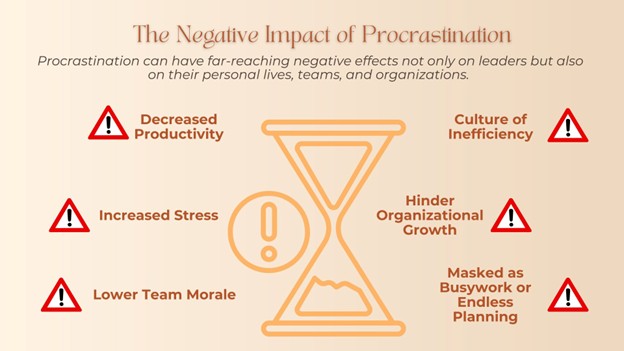
How Time Allocation Helps Leaders Overcome Procrastination
In the journey of conscious leadership development, understanding and addressing procrastination is crucial. Procrastination, the act of delaying tasks despite knowing the adverse consequences, is a common challenge faced by many leaders. Studies suggest that nearly 20% of adults identify themselves as chronic procrastinators, and this behavior can be particularly detrimental in leadership roles where timely decision-making is critical.
Understanding Procrastination Among Workplace Leaders
Leaders often fall into procrastination traps due to the pressure of multitasking and inadequate time management. This is compounded by the nature of leadership roles, which demand constant attention to emerging issues. Many leaders may not even realize they’re procrastinating, masking it as busy work or endless planning. This unconscious habit can stem from the desire for perfection, fear of failure, or simply feeling overwhelmed by complex tasks.
The Negative Impact of Procrastination
Procrastination can have far-reaching negative effects not only on leaders but also on their personal lives, teams, and organizations. Key impacts include:
Decreased Productivity: Procrastinating on important tasks can lead to missed deadlines and rushed work, undermining productivity and quality.
Increased Stress: The constant battle with unfinished tasks contributes to heightened stress levels, affecting mental and physical health.
Team Morale: Leaders who procrastinate may inadvertently set a precedent for their teams, leading to lower morale and a culture of inefficiency.
Organizational Growth: Delays in decision-making and project execution can hinder innovation and strategic growth, impacting the organization’s bottom line.
Overcoming Procrastination with Time Allocation
Time allocation stands as a powerful tool in combating procrastination. By providing structure and clear prioritization, it helps leaders focus on tasks that align with their strategic goals. Here’s how it works:
Structured Planning: By allocating specific time slots for tasks, leaders can break down larger projects into manageable segments, reducing the intimidation factor that often leads to procrastination.
Prioritization of Tasks: Time allocation encourages leaders to prioritize tasks based on urgency and importance, ensuring that high-impact activities receive the attention they deserve. This aligns efforts with strategic objectives, promoting efficiency.
Enhanced Focus and Efficiency: With time allocation, leaders can create a distraction-free environment, concentrating fully on the task at hand. This focus not only enhances productivity but also leads to more effective decision-making.
Time allocation is essential for leaders aiming to overcome procrastination. By fostering a disciplined approach to task management, leaders can enhance their focus, reduce stress, and drive their organizations toward sustainable success.
The Importance of Setting Boundaries in Leadership
In the realm of conscious leadership, setting boundaries serves as a pivotal component of effective time management and personal well-being. Boundaries define the limits of what you will accept and how you manage your time and interactions, both personally and professionally. They ensure that leaders can focus on their priorities without being overwhelmed by external demands.
We’ll be exploring Setting Healthy Boundaries much deeper in a later chapter of this workshop. However, it’s important that we introduce this concept now, especially in the context of effective time management, in order for you to begin working on your Time Management Plan.
What Setting Boundaries Means
Setting boundaries involves establishing clear guidelines on how you spend your time and interact with others. This can include personal boundaries, which dictate your time management, as well as interpersonal boundaries, which manage your interactions with colleagues and stakeholders. By setting these boundaries, leaders create a structured environment that supports their goals and well-being.
For workplace managers and leaders, setting boundaries is crucial for maintaining focus and reducing stress. Without clear boundaries, leaders can become overcommitted, leading to burnout and diminished performance. Establishing these limits allows leaders to prioritize high-impact activities and strategic goals.
Signs That Boundaries Are Lacking
Constant Overwhelm: Frequently feeling rushed or overwhelmed by tasks and commitments.
Lack of Time for Strategic Tasks: Inability to focus on long-term goals due to constant interruptions or urgent demands.
Diminished Work-Life Balance: Difficulty in separating work from personal life, leading to stress and fatigue.
Critical Components of Setting Boundaries
Communication: Clearly articulate your boundaries to colleagues and stakeholders. This might involve setting specific times for meetings or responding to emails.
Consistency: Enforce your boundaries consistently to ensure they are respected. This builds trust and sets expectations with your team.
Flexibility: While boundaries are important, they should not be rigid. Flexibility allows leaders to adapt to changing circumstances without compromising their priorities.
Self-Reflection: Regularly review your boundaries to ensure they align with your evolving role clarity, core values, and leader identity.
Studies show that 60% of professionals who set clear boundaries experience improved work-life balance, which is crucial for sustainable leadership.
Setting boundaries is a fundamental aspect of effective leadership. By establishing clear limits, leaders can focus on their strategic objectives, enhance their productivity, and foster a healthier work environment. This discipline not only supports personal growth but also cultivates a culture of respect and efficiency within the organization. As you continue your journey through the ‘Evolutionary Leader’ training program, embracing and implementing boundaries will be a cornerstone of your leadership development. Again, we will explore this topic in greater depth in a later chapter.
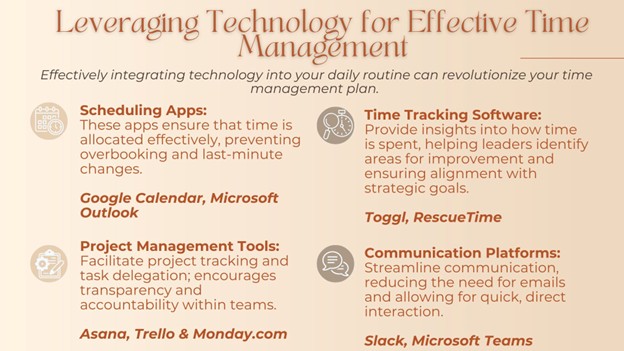
Leveraging Technology for Effective Time Management
In the fast-paced world of leadership, effectively integrating technology into your daily routine can revolutionize your time management plan. Utilizing digital tools strategically not only enhances productivity but also fosters innovation and strategic thinking by freeing up valuable time.
Understanding Technology Utilization in Time Management
Technology utilization in time management involves selectively using digital tools to streamline tasks, organize schedules, and enhance communication, without falling prey to distractions like non-urgent emails or social media alerts. This approach maximizes efficiency and supports leaders in focusing on high-impact activities.
Positive Examples of Technology Utilization
Scheduling Apps: Tools like Google Calendar and Microsoft Outlook help leaders efficiently manage their schedules by setting reminders and organizing meetings. These apps ensure that time is allocated effectively, preventing overbooking and last-minute changes.
Project Management Tools: Platforms such as Asana, Trello, and Monday.com facilitate project tracking and task delegation, allowing leaders to monitor progress and adjust plans as needed. These tools encourage transparency and accountability within teams.
Time Tracking Software: Applications like Toggl and RescueTime provide insights into how time is spent, helping leaders identify areas for improvement and ensuring alignment with strategic goals.
Communication Platforms: Slack and Microsoft Teams streamline communication, reducing the need for emails and allowing for quick, direct interaction. This minimizes interruptions and enhances team collaboration.
The Impact of Technology on Time Management
Effective use of digital tools can cut down task time by up to 30%, according to recent studies. This efficiency gain allows leaders to redirect their energy towards strategic thinking and innovation, fostering a culture of continuous improvement and growth.
Incorporating technology into your time management plan is not about replacing human judgment but enhancing it. By leveraging digital tools appropriately, leaders can streamline operations, reduce stress, and focus on driving strategic initiatives.
Incorporating a Rest and Recharge Strategy into Your Time Management Plan
In the fast-paced world of leadership, the emphasis on productivity often overshadows the fundamental need for rest and recovery. However, a well-structured rest and recharge strategy is an essential component of a comprehensive time management plan, crucial for maintaining cognitive function and preventing burnout.
What is a Rest and Recharge Strategy?
A rest and recharge strategy is a deliberate plan that integrates regular breaks, adequate sleep, and other rejuvenating activities into your daily routine. For workplace managers and leaders, this strategy ensures a sustained level of energy and focus, enabling them to meet their responsibilities effectively.
The Importance of a Rest and Recharge Strategy
Incorporating a rest and recharge strategy into your time management plan is vital for several reasons:
Boosts Cognitive Function: Studies show that regular breaks and sufficient sleep can enhance cognitive function by up to 40%, improving decision-making and problem-solving capabilities.
Prevents Burnout: By scheduling time for rest, leaders can maintain their energy levels, reduce stress, and avoid the pitfalls of burnout, ensuring long-term productivity and well-being.
Enhances Creativity and Innovation: Rest allows the mind to wander, fostering creativity and enabling innovative thinking, which are critical for effective leadership.
Signs of a Lacking Rest and Recharge Strategy
Chronic Fatigue: Feeling perpetually tired despite a full night’s sleep.
Decreased Productivity: Struggling to complete tasks efficiently or effectively.
Increased Irritability: Experiencing heightened stress and irritability due to a lack of downtime.
Tips for Incorporating a Rest and Recharge Strategy
Schedule Breaks: Plan short breaks into your daily schedule to ensure you take time to rest. Use reminders or alarms to prompt these pauses.
Prioritize Sleep: Set a consistent bedtime routine to ensure you get enough rest each night. Avoid screens before bed to enhance sleep quality.
Create a Relaxation Ritual: Dedicate time each day to a relaxing activity that you enjoy, such as reading or listening to music.
Block Out Time for Exercise: Schedule regular physical activity, whether it’s a daily walk or a gym session, to enhance your physical and mental health.
Integrating a rest and recharge strategy into your time management plan is not just beneficial – it’s essential. By recognizing the importance of downtime and incorporating these strategies into your routine, you can enhance your cognitive abilities, prevent burnout, and lead with greater effectiveness and resilience.

Exercise
• Share your ideas on how to allocate time effectively for the scenario you’ve chosen.
• Discuss and list key tasks, prioritizing them based on their importance and urgency. This will help in organizing your thoughts and strategies.
• Work together to create a quick and simple time management plan, assigning specific time slots for each task. Don’t forget to consider incorporating breaks and buffer times for flexibility.
• Visualize the plan by mapping it out, so it’s clear and easy to follow.
• Choose a representative from your group to briefly present your time management plan to everyone else.
• Take a moment to reflect on how these strategies can be applied to your real-world tasks and responsibilities. Think about how this exercise can inform your daily work practices.

Course Manual 6: Mindful Energy Management
Continuing to Bridge the Gap: Celebrating Your Progress Thus Far
Congratulations on the remarkable journey you’ve undertaken in the ‘Evolutionary Leader’ program so far. As we step into Chapter 6, it’s essential to acknowledge the significant strides you’ve made towards bridging the gap between your current time and energy management practices and your envisioned, desired ideal state of being and your environment in the workplace.
Let’s reflect on your achievements thus far: you have heightened your awareness of how you have been and are currently managing your time and energy. This is foundational in crafting a more conscious approach to your daily routines.
You embraced the opportunity to dream boldly and design your ideal work environment and daily state of being, setting the stage for a workplace that fuels your highest potential. This visionary step was followed by deepening your understanding of your role through creating Leader Role Clarity, enhancing both your personal and organizational effectiveness.
Furthermore, you now have a better understanding of why clear, strategic goals and priorities are essential components. And why aligning them with your daily activities is critical to ensure progress towards your long-term vision. This clarity has been complemented by now knowing how to create and implement an effective time management plan, utilizing techniques such as time slot allocation, technology utilization, and a rest and recharge strategy.
Wow! These are huge accomplishments, and you should feel incredibly proud of your progress. Continue to move forward with confidence and intention, knowing that you are building a foundation for lasting personal and professional success.

Understanding the Five Core Human Components
Up until now, our conversation has centered on recognizing your energy dips and peaks, a crucial step in boosting your efficiency and productivity. By being attuned to these fluctuations, you’ve laid the groundwork for more focused and effective energy management. Now, let’s delve deeper to truly understand what energy is and how you can harness its power for personal and professional growth.
Energy is a complex, multifaceted concept that extends beyond mere feelings of being energized or fatigued. It is the driving force that influences every aspect of our lives and leadership effectiveness. To fully leverage this power, it is essential to understand and manage the five core human components: Physical, Mental, Emotional, Energetic, and Spiritual. Each of these components plays a pivotal role in maintaining optimal energy levels and enhancing your leadership capabilities.
While many individuals tend to focus on just one or two of these components, often the Physical and Mental aspects, they may overlook the profound impact of the less acknowledged areas. Unfortunately, this limited focus can result in an imbalance that undermines our health and fulfillment. Research has shown that neglecting these components can lead to increased stress, lower productivity, and compromised well-being.
Physical Health: This is the bedrock of your energy. A healthy body not only supports physical endurance but also enhances your ability to manage other components effectively. Regular exercise, balanced nutrition, and adequate rest are fundamental to sustaining physical energy and, by extension, supporting overall energy management.
Mental Health: Your mental state is a key influencer of your energy. Positive, clear thinking enhances focus and creativity, while negative thoughts can drain your energy reserves. A healthy mental component allows you to manage tasks efficiently, making it a critical factor in energy management and leadership effectiveness.
Emotional Health: Emotional stability ensures consistent energy levels, enabling you to better handle stress and challenges. When emotional health is nurtured, it fosters resilience and adaptability, vital traits for any leader. Emotional intelligence and self-awareness are essential for maintaining this stability.
Energetic Health: Often overlooked, your energetic state impacts your interactions and environment. Balanced energy contributes to a sense of calm and confidence, whereas imbalance can lead to stress and low self-esteem. Techniques like meditation can help align your energetic component, enhancing both personal and collective energy management.
Spiritual Health: This provides a deeper sense of purpose and motivation, fueling your sustained energy and resilience. A healthy spiritual component fosters inner peace, reducing stress and promoting overall well-being. Engaging in spiritual practices can strengthen this component, empowering you to lead with inspiration.
Understanding and nurturing these components is crucial for harnessing the true power of your energy. By maintaining their health and balance, you not only enhance your energy levels but also your capacity to lead effectively.
Defining a Practice of Mindful Energy Management
Mindful energy management begins with an acute awareness and consciousness of how our energy is influenced by the five core human components: Physical, Mental, Emotional, Energetic, and Spiritual. Each of these components contributes to our overall energy levels, which manifest as Mental, Emotional, and Physical energy. Understanding and nurturing these components is key to optimizing our energy and enhancing leadership effectiveness.
A practice of mindful energy management involves recognizing how the health of each core component supports these three types of energy. For instance, physical health directly impacts our stamina and resilience; mental health influences our cognitive clarity and focus; emotional health ensures stability and adaptability; energetic health affects our interactions and sense of calm; and spiritual health provides a deep sense of purpose and motivation.
Finding your ‘sweet spot’—where your energy expenditure perfectly aligns with your tasks and personality—is crucial. This alignment not only prevents burnout but also enhances overall well-being.
Furthermore, understanding how people and environments affect your energy levels is a vital aspect of mindful energy management. Certain interactions or settings can either invigorate or drain you, emphasizing the importance of tailoring your experiences to maintain energy balance.
By cultivating a practice of mindful energy management, you create a tailored approach to your daily routines that maximizes energy efficiency. This includes setting boundaries, prioritizing tasks, and creating environments that support your energy dynamics. As you develop this practice, you not only enhance your own productivity and effectiveness but also contribute to a more energized and resilient organizational culture. This holistic approach empowers you to lead with intention and adaptability in an ever-changing world.
Introversion vs. Extroversion in Mindful Energy Management
In the realm of mindful energy management, understanding the concepts of introversion and extroversion is essential. These personality traits play a significant role in how individuals recharge their energy and what activities either invigorate or drain them.
Introversion is characterized by a preference for solitary activities and a need for quiet environments to recharge. Introverts often find energy in reflection and intimate settings, gaining strength from within rather than external stimulation. They may feel drained by prolonged social interactions or highly stimulating environments. Despite a common misconception, introverts possess inherent leadership capabilities. Their reflective nature often means they lead with thoughtfulness and depth, qualities that are indispensable in transformational leadership.
Extroversion, on the other hand, is marked by a tendency to seek out social interactions and thrive in dynamic environments. Extroverts draw energy from external stimuli and often feel invigorated by engaging with others. Collaborative settings and lively discussions typically enhance their energy levels. While extroverts may excel in social settings, understanding when to step back and recharge is crucial to maintaining sustainable energy.
Research indicates that introversion and extroversion are not mutually exclusive; rather, they exist on a continuum. Approximately 50% of the population falls somewhere between the two extremes, possessing traits of both, known as ambiversion. This balance allows individuals to adapt their energy management strategies based on situational demands.
Understanding where you fall on this spectrum adds a deeper layer of self-awareness to your energy management practice. It empowers you to tailor your activities and interactions to align with your natural preferences, enhancing your effectiveness and productivity.
The Importance of Mindful Energy Management for Leaders
In today’s fast-paced work environment, the role of a leader extends beyond managing tasks to inspiring and guiding teams towards collective success. Establishing a practice of mindful energy management is essential for leaders, as it directly impacts their ability to maintain productivity, mitigate burnout, and enhance overall leadership effectiveness.
For workplace managers and leaders, the stakes are high. According to recent studies, over 60% of managers report feeling overwhelmed by their responsibilities, which can lead to burnout and decreased effectiveness. A practice of mindful energy management enables leaders to navigate these challenges by fostering a balanced approach to energy expenditure, which in turn supports sustained high performance.
One of the primary benefits of mindful energy management is improved productivity. Leaders who are attuned to their energy levels can allocate their resources more efficiently, aligning their peak energy periods with critical tasks. This strategic alignment not only boosts individual performance but also sets a standard for their teams, fostering a culture of efficiency and focus.
Mindful energy management also plays a pivotal role in reducing burnout. By understanding and respecting personal energy limits, leaders can implement restorative practices that replenish their energy reserves. This approach is supported by data indicating that employees who practice effective energy management experience a 20% reduction in burnout symptoms. As leaders model these practices, they promote a healthier, more sustainable work environment for their teams.
Furthermore, mindful energy management enhances leadership effectiveness by cultivating a deeper self-awareness. Leaders who are conscious of their energy dynamics can adapt their communication and decision-making styles to suit various situations, thereby improving their influence and impact. This adaptability is crucial in navigating the complexities of modern leadership, where diverse and often unpredictable challenges abound.
Incorporating mindful energy management into leadership practices empowers leaders to not only optimize their own performance but also to inspire and motivate their teams.
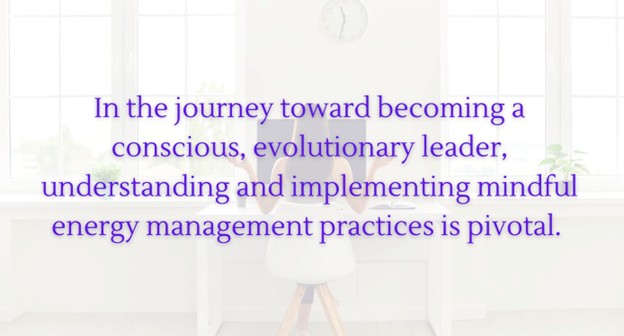

Case Studies
In the journey toward becoming a conscious, evolutionary leader, understanding and implementing mindful energy management practices is pivotal. This section of Chapter 6, dedicated to case studies, offers real-world examples of how organizations have effectively applied these practices to transform their workplace dynamics. By examining these cases, you will gain insights into the tangible benefits of mindful energy management—ranging from increased productivity and reduced burnout to enhanced leadership effectiveness. These stories serve as a testament to the power of aligning energy management strategies with organizational goals and individual well-being. As you explore these examples, consider how these innovative approaches can be tailored to meet the unique needs of your own leadership journey and organizational context.
Case Study 1: Energy Peaks Identification and Task Alignment
A financial services firm implemented an energy peaks identification program for their managers. By tracking when managers were most alert and focused, they were able to align high-priority tasks with these peak times. This strategic task alignment led to a 20% increase in task completion rates and significantly enhanced decision-making quality. Managers reported feeling more in control and less overwhelmed, which also reduced burnout rates by 15%.
Case Study 2: Creating a Balanced Work Environment
A healthcare organization embraced the concept of a balanced work environment by integrating mindful spaces within their offices. They created quiet zones for focused work, relaxation areas for breaks, and collaborative spaces for team interactions. This mindful environment adjustment improved employee satisfaction scores by 30% and increased overall productivity by 18%. Employees noted that having designated spaces for different activities helped them manage their energy more effectively throughout the day.
Case Study 3: Strategic Rest and Recharge Practices
An advertising agency introduced a strategic rest and recharge initiative for its managers. By encouraging regular breaks and providing flexible work hours, managers were able to recharge effectively. This shift led to a 22% decrease in stress-related absenteeism and a 30% boost in creative output. The agency found that when managers were well-rested, their ability to lead innovative projects and inspire their teams improved significantly.
These case studies illustrate the diverse ways mindful energy management practices can be tailored to enhance productivity, reduce burnout, and strengthen leadership effectiveness within organizations.
Finding Your Energetic ‘Sweet Spot’
In the quest for conscious leadership, discovering your individual ‘sweet spot’ in energy management is a transformative step. This sweet spot represents the perfect balance between exerting enough effort to maximize productivity and positivity while avoiding the brink of burnout. Striking this balance is crucial, as it empowers leaders to operate at their full potential, fostering personal well-being and organizational success.
Understanding the Sweet Spot
Imagine your sweet spot as a dynamic equilibrium where your energy expenditure perfectly aligns with your personality and tasks. It’s about maintaining momentum without overexerting yourself or falling into a rut. Consider the analogy of a runner who paces themselves to avoid exhaustion while also maintaining a speed that challenges them. Similarly, your leadership effectiveness depends on managing your energy to sustain high performance without the adverse effects of burnout.
Tips for Identifying Your Sweet Spot
Recognize Your Energy Peaks:
Mapping out your energy levels throughout the day is super helpful. We’ve already explored this in chapter 1. Many individuals experience natural fluctuations, often peaking in the morning or early afternoon. As we’ve explored, by identifying these periods, you can align your most demanding tasks with your highest energy levels, optimizing productivity.
Assess Your Personality Complex:
Determine whether you lean towards a “worrywart” or “superhero” complex. Worrywarts may need to push themselves slightly out of their comfort zone to take advantage of energy peaks, while superheroes might need to take conscious steps back to prevent overexertion. This self-awareness is key to crafting a balanced approach to energy management.
Implement Rituals for Energy Maintenance:
Develop and stick to routines that support your energy levels. This could include setting boundaries to minimize distractions, scheduling regular breaks, or integrating mindfulness practices into your day. Statistics indicate that employees who integrate mindful practices report a 28% reduction in stress levels and improved focus.
Tailor Your Environment:
Create workspaces that reflect the tasks at hand. Quiet zones for deep work, collaborative spaces for brainstorming sessions, and relaxation areas for breaks can help you manage your energy more effectively.
The Impact of Finding Your Sweet Spot
Achieving your sweet spot isn’t just about personal well-being; it translates into tangible organizational benefits. Leaders who master this balance are more resilient, adaptable, and capable of inspiring their teams. A balanced energy approach has been linked to a 25% reduction in burnout and a 15% increase in leadership effectiveness.
As you continue your journey in the ‘Evolutionary Leader’ program, focus on identifying and maintaining your sweet spot. By harnessing this balance, you’ll not only enhance your own performance but also set a powerful example for those you lead.
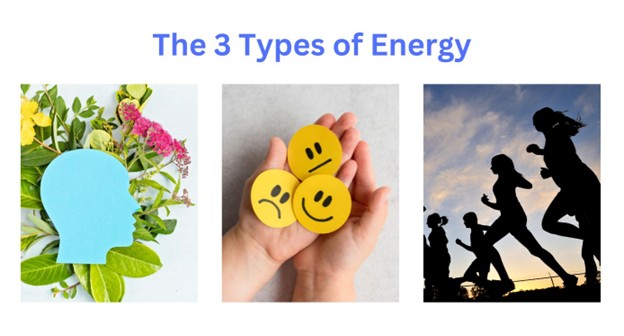
The Three Types of Energy
In the journey to becoming a conscious leader, understanding the three types of energy—mental, emotional, and physical—is essential for optimizing your overall productivity and success. Each type of energy plays a distinct role in how you function daily and mastering them can significantly impact your leadership effectiveness.
Mental Energy
Mental energy is the powerhouse for focus, creativity, and problem-solving. It influences your ability to concentrate, imagine possibilities, and visualize goals. If you find yourself easily distracted by social media or other non-essential tasks, your mental energy may be depleted.
Strategies to Maximize Mental Energy:
Meditation and Mindfulness: Incorporate daily meditation practices to clear your mind and improve focus.
Journaling: Spend a few minutes each day writing down thoughts and ideas to organize your mind.
Task Prioritization: Focus on high-priority tasks during peak mental energy periods to boost productivity.
Emotional Energy
Emotional energy relates to your overall sense of well-being and how your thoughts and self-talk impact your mood. Positive emotional energy is linked with higher levels of happiness and resilience.
Strategies to Enhance Emotional Energy:
Positive Affirmations: Start your day with affirmations to cultivate a positive mindset.
Self-Care Routines: Implement regular activities that nurture your emotional health, such as hobbies or social connections.
Reflective Practices: Engage in reflection to understand and manage your emotional responses better.
Physical Energy
Physical energy is what we commonly refer to as feeling “energized.” It encompasses alertness, fitness levels, and general health. Maintaining a high level of physical energy is crucial for enduring long workdays and overcoming challenges. According to studies, regular physical activity can increase energy levels and reduce fatigue by 30%.
Strategies to Boost Physical Energy:
Regular Exercise: Incorporate at least 30 minutes of exercise into your daily routine to keep your energy levels high.
Balanced Nutrition: Fuel your body with a diet rich in nutrients to sustain energy throughout the day.
Adequate Rest: Ensure you get sufficient sleep to recharge your physical energy reserves.
Balancing the Three Types of Energy
To become an unstoppable leader, it is vital to balance and maximize all three types of energy. By doing so, you equip yourself with the necessary resources to tackle any task and achieve your goals efficiently. Studies show that leaders who actively manage their energy experience a 25% increase in productivity and a 20% reduction in burnout rates.
Maximizing Your Energy Throughout the Day
As a leader, the ability to maintain high energy levels is paramount to achieving success and inspiring those around you. In this segment of Chapter 6, we delve into strategic techniques designed to maximize and sustain your energy throughout the day. By integrating these methods into your daily rituals, you can enhance productivity, boost creativity, and maintain a positive mindset even in the most challenging situations.
Mental Shadowboxing
Mental shadowboxing is a transformative exercise that involves confronting and overcoming mental barriers. This technique encourages you to write empowering statements that reinforce your identity and goals. By engaging in mental shadowboxing, you cultivate a resilient mindset, ready to tackle obstacles head-on.
To practice mental shadowboxing, find a quiet space and gather your thoughts. Write down affirmations like, “I am a powerful leader. I achieve my goals with confidence.” Repeat these affirmations regularly to build mental strength and clarity.
Verbal Mantras
Verbal mantras take self-affirmation a step further by vocalizing your intentions. Speaking these affirmations aloud can significantly alter your energy and mindset. A study found that vocal affirmations can reduce stress levels by 25%, promoting a sense of control and positivity.
To use verbal mantras, create personal power statements such as, “I am capable and strong.” Speak these affirmations out loud, ideally in front of a mirror, to reinforce self-belief and motivation.
Physical State Change
Physical state change is a dynamic technique to instantly boost energy. This method involves quick bursts of physical activity to elevate heart rate and invigorate your mind and body. Studies indicate that short, intense physical activity can enhance brain function and mood by up to 18%.
When feeling sluggish, try this technique by engaging in activities like jumping jacks, clapping, or dancing. Use these movements to quickly shift your energy and refocus on your tasks.
Meditation and Relaxation
Meditation and relaxation are essential practices for maintaining energy levels over the long term. These techniques help calm the mind and reduce stress, allowing for clearer decision-making and increased focus. Research shows that regular meditation can improve concentration and reduce stress by 30%.
To use this technique, dedicate at least 7 minutes daily to meditation or do relaxation exercises. Try using guided meditations or calming music to assist in achieving a tranquil state.
Mental Stimulation
Mental stimulation involves engaging with content that inspires and challenges your thinking. This practice can boost creativity and motivation, equipping you with fresh perspectives. Exposure to new ideas can increase mental flexibility and innovation by 22%.
You can stimulate your mind by reading industry-related books or articles to generate new insights. Or by watching motivational videos or listening to podcasts that align with your goals.
By incorporating these energy-maximizing techniques into your routine, you create a robust foundation for enduring leadership success. Each method offers unique benefits, enabling you to tailor your energy management strategies to your needs.
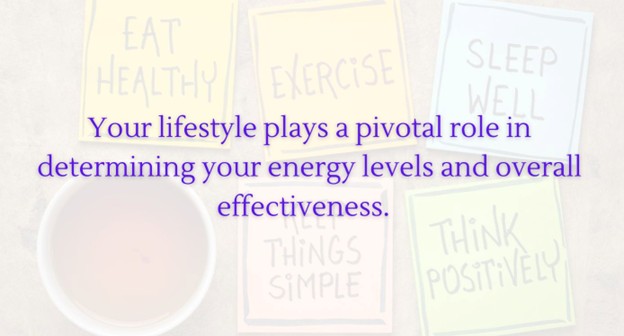
Lifestyle and Its Impact on Energy
In the pursuit of effective leadership, your lifestyle plays a pivotal role in determining your energy levels and overall effectiveness. While “work hard, play hard” is a familiar mantra, the nuances of how you live in between can significantly influence your daily energy reserves. Let’s explore the key lifestyle factors that contribute to sustained energy and how you can incorporate these elements into your leadership routine.
Fitness
A robust fitness routine is fundamental to maintaining high energy levels. Regular physical activity not only enhances physical endurance but also reduces stress and elevates mood. Studies indicate that individuals who exercise regularly experience a 20% increase in energy levels and report feeling less fatigued. Incorporating activities such as walking, cycling, or even desk exercises can foster a more energetic and resilient you.
Some fitness tips to keep in mind include aiming for at least 150 minutes of moderate aerobic activity weekly; including strength training exercises at least twice a week; and integrating movement into your daily routine, like taking stairs instead of elevators.
Nutrition
Have you ever heard of the saying, “What you put in is what you get out?” What you fuel your body with directly impacts your energy levels. A diet rich in nutrients – comprising of whole grains, lean proteins, healthy fats, and plenty of fruits and vegetables – can provide the sustained energy needed for peak performance. Conversely, processed foods and sugar-laden snacks, which are void of nutrients, can lead to energy crashes and decreased productivity.
Some nutritional strategies you may want to consider include maintaining a balanced diet with a variety of nutrient-dense foods; staying hydrated to support metabolic processes and energy production. In fact, keep in mind that the more mental work you do, the more hydration you’ll need; and limiting caffeine and sugar intake to prevent energy slumps.
Sleep
Quality sleep is crucial for restoring energy and maintaining focus. Inadequate or poor-quality sleep can lead to decreased cognitive function and productivity. Research shows that adults need 7-9 hours of restorative sleep each night to maintain optimal energy levels.
Some tips to enhance your sleep include establishing a consistent sleep schedule by going to bed and waking up at the same time daily; creating a relaxing bedtime routine to signal to your body that it’s time to wind down; ensuring your sleep environment is conducive to rest, with minimal light and noise.
Stress Management
As a leader, managing stress effectively is vital to sustaining energy. Chronic stress can deplete your energy reserves and affect your overall well-being. Techniques such as meditation, deep breathing, and journaling can help you stay calm and focused, enabling you to navigate challenges with resilience.
Some stress reduction techniques include practicing mindfulness or meditation for at least 7 minutes a day; using deep breathing exercises to center yourself during stressful situations; maintaining a journal to reflect on your experiences and process emotions.
Personal Development
Continual personal growth fosters motivation and energy. Engaging in activities that enhance your skills and knowledge keep you inspired and invigorated. Whether through reading, attending seminars, or seeking mentorship, personal development can significantly enhance your leadership capabilities.
Some personal development practices include setting aside time each week for learning or skill development; connecting with mentors or peers who inspire and challenge you; exploring new hobbies or interests to expand your perspectives and boost creativity.
By integrating these lifestyle practices into your daily routine, you not only boost your energy levels but also enhance your leadership effectiveness.

Exercise

Course Manual 7: Establishing Healthy Boundaries
Bridging the Gap: Continuing the Journey
As we embark on Chapter 7, we delve into the transformative power of establishing healthy boundaries. As we’ve already begun exploring in previous chapters, establishing healthy boundaries is an essential step in bridging the gap between your current practices and the ideal state you aspire to achieve. By setting clear boundaries, you create a framework that supports ongoing progress and facilitates a work environment conducive to optimal performance. This proactive approach not only helps in prioritizing strategic goals but also ensures that your time and energy are managed with intention and precision. Embracing boundaries empowers you to make consistent strides toward your desired professional and personal balance, enhancing both your leadership effectiveness and overall well-being.
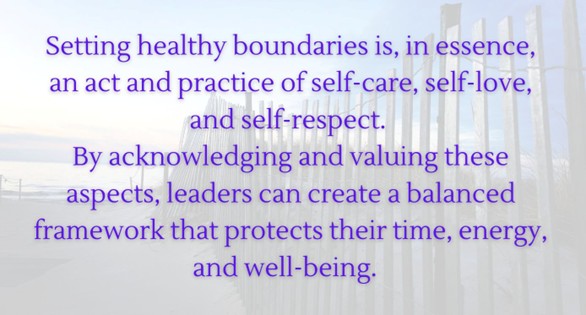
Defining Healthy Boundaries
In our journey of conscious leadership development, understanding what constitutes healthy boundaries is fundamental to achieving leadership effectiveness and personal well-being. In Chapter 5, you may recall that we began to explore the concept of setting boundaries in the context of developing a time management plan. Now, in this chapter, we delve deeper into this essential skill.
Setting healthy boundaries is, in essence, an act and practice of self-care, self-love, and self-respect. By acknowledging and valuing these aspects, leaders can create a balanced framework that protects their time, energy, and well-being. This awareness is crucial for effectively practicing boundary-setting, ensuring that personal needs and professional responsibilities are harmoniously aligned. By clearly defining these boundaries, leaders maintain clarity and purpose in their actions, fostering an environment conducive to growth and success.
Personal boundaries primarily focus on time management, involving the setting of limits on how we allocate our time and resources. This ensures prioritization of tasks that align with our goals, helping to prevent overwhelm. According to a study by the American Management Association, 55% of professionals reported that setting personal boundaries improved their productivity and job satisfaction.
Interpersonal boundaries relate to managing our interactions, expectations and communications with others. These boundaries are essential for maintaining a respectful and efficient work environment, preventing burnout, and fostering a supportive workplace culture. Research indicates that leaders who establish strong interpersonal boundaries experience a 30% increase in team satisfaction and cooperation.
Recognizing the role of boundaries as acts of self-care will be explored in more depth later in this chapter, as it is critically important for effectively practicing this essential skill. By mastering boundary-setting, you take a significant step toward achieving your ideal state in the workplace, where optimal performance and well-being are seamlessly integrated.
The Importance of Setting Healthy Boundaries
Throughout this first workshop on ‘Focus Enhancement’ of our ‘Evolutionary Leader’ program, we’ve already frequently touched upon the importance of setting healthy boundaries. This hasn’t been to bombard you but rather help you see the critical importance of this concept. Now, let’s delve deeper into why this practice is essential.
Without healthy boundaries, you risk maintaining the status quo or even facing a deterioration of your performance, efficiency, productivity and work-life balance. This can manifest as increased stress, decreased productivity, and eventual burnout. A study conducted by the Harvard Business Review found that leaders without clear boundaries are 40% more likely to experience burnout within their first five years in a leadership role.
Setting healthy boundaries is an intentional act of reclaiming control over your time and energy, rather than allowing others and circumstances to dictate them. By doing so, you create a framework that supports your priorities and aligns with your professional goals. This empowerment leads to transformative changes, where you manage demands with clarity and purpose. Establishing boundaries can result in a 20% increase in productivity and a notable improvement in overall job satisfaction, as reported by the American Psychological Association.
By setting boundaries, you empower yourself to focus on what truly matters, aligning your actions with your professional goals while protecting your well-being. This not only enhances your leadership effectiveness but also promotes a healthier, more collaborative workplace environment.
Moreover, the practice of setting healthy boundaries is being in a state of proactivity rather than taking a reactive approach—a concept we explored earlier in this workshop. By being proactive, you ensure that your time and energy are managed effectively, again preventing burnout and allowing for alignment with your professional goals. This foresight not only enhances your leadership effectiveness but also further fosters a healthier, more collaborative workplace environment.
As we explore this concept further, consider how embracing boundaries could revolutionize your professional and personal life, making a significant step forward in your conscious leadership journey.
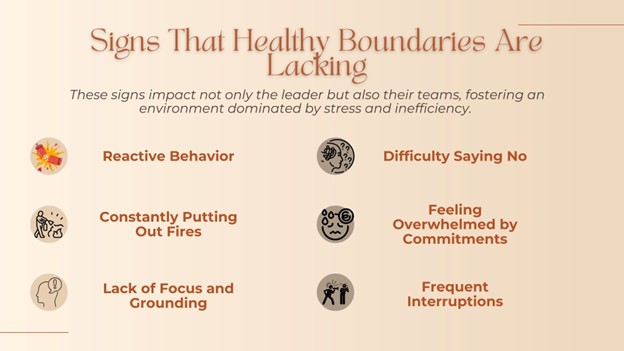
Signs That Healthy Boundaries Are Lacking
In the fast-paced environment of leadership, recognizing the signs that healthy boundaries are lacking is critical for maintaining both personal well-being and effective leadership. Here are some indicators that boundaries may be insufficient:
Reactive Behavior: Leaders often find themselves responding to immediate crises rather than managing their time strategically. This reactivity, often described as being in “fight, flight, or freeze” mode, can lead to chronic stress and burnout not to mention creating an environment and mood of you and your staff being constantly on edge.
Constantly Putting Out Fires: The day is spent dealing with unexpected issues, leaving little time for proactive planning and strategic thinking. According to the American Institute of Stress, 80% of workers feel stress on the job, with nearly half seeking help in managing it, often due to poor boundary-setting.
Lack of Focus and Grounding: Leaders may struggle to concentrate on significant tasks, leading to decreased productivity and decision-making quality. The Harvard Business Review notes that leaders without clear boundaries often experience a 30% decline in job satisfaction and effectiveness.
Difficulty Saying No: Many leaders find it challenging to refuse additional tasks, leading to an unsustainable workload. This inability to decline requests often results in overcommitment and stress.
Feeling Overwhelmed by Commitments: With an ever-growing list of responsibilities, leaders may feel perpetually overwhelmed, unable to prioritize effectively and maintain a healthy balance.
Frequent Interruptions: Without clear boundaries, leaders may experience constant disruptions throughout their day, hindering their ability to focus on strategic objectives and reducing overall efficiency.
These signs impact not only the leader but also their teams, fostering an environment dominated by stress and inefficiency. Recognizing these symptoms is the first step toward addressing boundary issues, enabling a more balanced and productive professional life. Establishing healthy boundaries is essential for creating a workplace where both leaders and their teams can thrive.

Case Studies
In this section, we explore real-world examples of workplace managers and leaders who have successfully implemented healthy boundaries, transforming their work environments and enhancing their leadership effectiveness.
Case Study 1: Transforming Team Dynamics
At a tech company, the Head of Product Development, Lisa C., faced challenges with constant interruptions and an overwhelming workload. By establishing clear boundaries, including designated “focus hours” free from meetings and interruptions, Lisa was able to reclaim control over her time. This change led to a 25% increase in project completion rates and a significant reduction in team stress levels, as reported in the company’s quarterly performance review.
Case Study 2: Reducing Burnout
Michael T., the Operations Manager at an environmental company, noticed a high turnover rate due to burnout. By prioritizing essential tasks and learning to say no to non-critical meetings, Michael effectively managed his team’s workload. Within a year, employee retention increased by 40%, and surveys showed a marked improvement in job satisfaction. This case illustrates the power of setting boundaries to foster a supportive and sustainable work environment.
Case Study 3: Boosting Innovation
At an advertising agency, CEO Rachel N. implemented a “no email after hours” policy, promoting work-life balance. As a result, the agency saw a 30% boost in creative output, with employees reporting feeling more refreshed and innovative. This initiative not only improved the quality of work but also strengthened team cohesion and morale.
These case studies highlight the tangible benefits of setting healthy boundaries in leadership. By creating a structured framework for managing time and resources, leaders can foster an environment that supports both personal well-being and organizational success. These examples serve as powerful reminders of the transformative impact of boundary-setting on leadership and team dynamics.
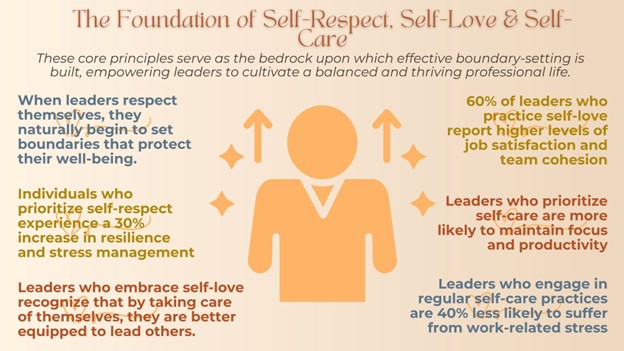
The Foundation of Self-Respect, Self-Love, and Self-Care
As mentioned earlier in this chapter, the practice of setting healthy boundaries is fundamentally rooted in self-respect, self-love, and self-care. Think about it this way – if you don’t first respect your own time and energy, how can you expect others to? These core principles serve as the bedrock upon which effective boundary-setting is built, empowering leaders to cultivate a balanced and thriving professional life.
Self-Respect: At its core, self-respect involves acknowledging the value of your own time and energy. When leaders respect themselves, they naturally begin to set boundaries that protect their well-being. A study by the American Psychological Association suggests that individuals who prioritize self-respect experience a 30% increase in resilience and stress management, highlighting the importance of this trait in leadership.
Self-Love: Practicing self-love means understanding and honoring your personal needs and limits. Leaders who embrace self-love recognize that by taking care of themselves, they are better equipped to lead others. This approach not only enhances personal well-being but also translates into improved team dynamics and morale. Research indicates that 60% of leaders who practice self-love report higher levels of job satisfaction and team cohesion.
Self-Care: Self-care is the actionable expression of self-respect and self-love. It involves setting aside time for activities that rejuvenate and replenish your energy. Leaders who prioritize self-care are more likely to maintain focus and productivity, reducing the risk of burnout. According to the National Institute for Occupational Safety and Health, employees who engage in regular self-care practices are 40% less likely to suffer from work-related stress.
By embodying self-respect, self-love, and self-care, leaders set a powerful precedent for how they expect to be treated by others. This internal alignment not only fosters personal growth but also creates a ripple effect, encouraging a culture of respect and mutual understanding within their teams. As leaders embrace these foundational principles, they pave the way for healthier, more sustainable work environments, where everyone can thrive.
Aligning Boundaries with Core Values and Goals
Effective boundary setting is deeply rooted in understanding and aligning with your core values and personal and professional goals. As mentioned in an earlier chapter of this workshop, core values serve as your compass, guiding your decisions and actions. We will explore this concept more thoroughly in a later workshop within the ‘Evolutionary Leader’ program, but it’s essential to recognize their role in boundary setting now.
Setting boundaries that resonate with your core values ensures that your actions and priorities reflect what truly matters to you. This alignment fosters authentic leadership, where decisions are made with confidence and integrity. According to a study by the Center for Creative Leadership, leaders who align their boundaries with their core values report a 35% increase in decision-making effectiveness and team trust.
Also, in an earlier chapter of this workshop, we explored determining your strategic goals, which serve as a foundation for establishing boundaries. By clearly defining what you aim to achieve, you can set boundaries that protect the time and energy needed to focus on these goals. This strategic alignment is crucial for maintaining clarity and preventing distractions. Research indicates that leaders who set boundaries around their strategic goals experience a 28% boost in productivity and goal attainment, as highlighted in a report by the American Management Association.
By aligning boundaries with both core values and strategic goals, you create a cohesive framework that supports your leadership journey. This approach not only enhances personal and professional growth but also cultivates a work environment grounded in respect and purpose. As you continue to refine your boundary-setting skills, remember that this alignment is a powerful tool for achieving sustainable success and fostering a thriving organizational culture.
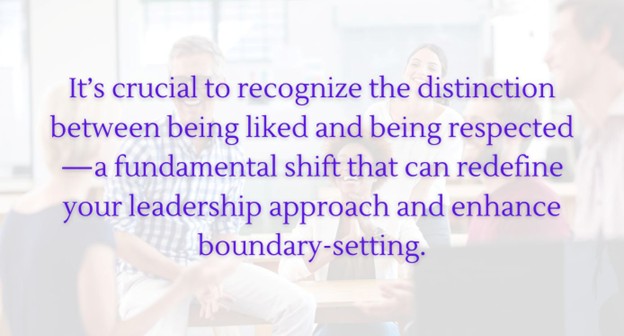
Overcoming People Pleasing in Boundary Setting
One of the most significant challenges leaders face in establishing healthy boundaries is overcoming the tendency to please others. This challenge is particularly prevalent among leaders, with a notable emphasis on women, who often feel the pressure to be both liked and accommodating. However, it’s crucial to recognize the distinction between being liked and being respected—a fundamental shift that can redefine your leadership approach and enhance boundary-setting.
As an individual contributor, you were part of a team, working alongside your peers. Transitioning into a leadership role, you now bear responsibility for guiding and protecting that team, which often requires setting firm boundaries that may not always be popular. This shift demands a reevaluation of priorities, emphasizing the necessity of respect over likability. A study by the Academy of Management found that 80% of effective leaders prioritize respect, which fosters trust and authority within their teams.
It’s important to understand that saying “no” is not only acceptable but often essential, particularly when a request or task doesn’t align with your role, core values, or strategic goals. This discernment ensures that your time and energy are allocated effectively, supporting your leadership objectives. Research from the Harvard Business Review indicates that leaders who practice saying no are 25% more likely to achieve their strategic goals and experience higher job satisfaction.
Moreover, committing to tasks that do not feel right or beneficial can infuse negative energy into projects, ultimately doing a disservice to both you and your team. Leaders who overcommit often report increased stress and decreased performance, as highlighted in a survey by the American Institute of Stress, where 67% of respondents linked overcommitment to burnout.
Setting healthy boundaries is not just a personal preference; it is a fundamental job requirement for leaders. Establishing these boundaries is essential for effective leadership and team management, forming a critical component of a leader’s responsibilities. By recognizing and overcoming the tendency to please everyone, leaders can set boundaries that uphold their integrity and foster a respectful and focused work environment.
Boundary Assessment: Evaluating and Enhancing Your Limits
Boundary assessment is a vital process for leaders aiming to maintain effective boundaries that support both personal well-being and professional success. It involves a systematic evaluation of the boundaries you currently have in place or the lack thereof, determining their effectiveness, and making necessary adjustments to enhance your leadership capabilities. By regularly assessing your boundaries, you ensure they remain aligned with your evolving goals and responsibilities.
Critical Components of Boundary Assessment
Recognizing Current Boundaries: As in anything, the first step to meaningful change is awareness of the current state of your personal and professional boundaries. Recognizing the boundaries you have around your time management limits, interpersonal interactions, and task prioritization, will allow you to effectively assess them.
Evaluating Effectiveness: Once identified, evaluating how well your boundaries are serving you is critical. Questions such as: Are they helping you achieve your strategic goals? Are they protecting your well-being and preventing burnout? According to studies, leaders who regularly assess their boundaries report a 25% reduction in work-related stress, leading to better work-life balance.
Adjusting as Needed: Making necessary adjustments to enhance the effectiveness of your boundaries is important. This might involve reinforcing certain limits, relaxing others, or setting entirely new ones as your role and goals evolve.
Tips for Conducting a Boundary Assessment
Self-Reflection: Spend time reflecting on your experiences and the impact of your current boundaries. Consider keeping a journal to document your thoughts and identify patterns or areas for improvement.
Seek Feedback: Engage with your team and peers to gather feedback on how your boundaries are perceived and their impact on team dynamics. This external perspective can provide valuable insights and areas for enhancement.
Set Measurable Goals: Establish clear and measurable goals for your boundary setting. This will help you track progress and ensure your boundaries continue to support your leadership objectives effectively.
This proactive approach not only strengthens your leadership but also fosters a respectful and efficient work environment.
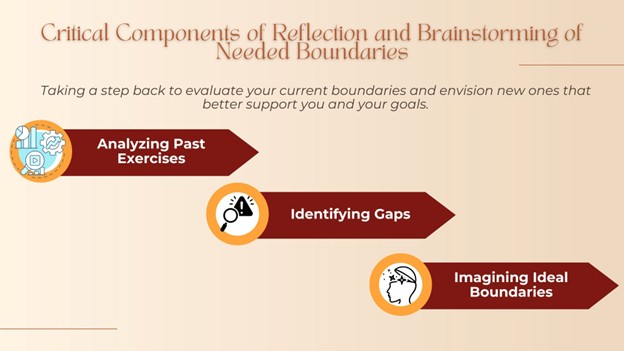
Reflection and Brainstorming of Needed Boundaries
Reflecting on the content of this workshop and brainstorming the healthy boundaries needed is a crucial process for enhancing your leadership capabilities. This reflective practice allows you to consolidate the insights you’ve gained thus far and identify gaps where boundaries can strengthen your professional and personal growth.
What Reflection and Brainstorming Involves
Reflection and brainstorming are about taking a step back to evaluate your current boundaries or lack thereof and envision new ones that support you and your goals. This process involves analyzing past exercises to determine what worked, what didn’t, and where changes are necessary. It’s about creating a mental framework for setting boundaries that align with your strategic objectives and personal well-being.
Critical Components of Reflection and Brainstorming
Analysis: By utilizing assessments, such as the Time Audit, Distraction Analysis, and Energy Peaks Identification assessments, they can provide valuable insights into your current practices and highlight areas needing improvement.
Identifying Gaps: Your insights gained can help to identify where boundaries might be lacking. This could involve recognizing the need for better time management, improved work-life balance, or more focused energy allocation.
Imagining Ideal Boundaries: Let your imagination sore and allow your vision of boundaries that could enhance your effectiveness to form. Consider how they might look in practice and how they align with your core values and goals.
Tips for Effective Reflection and Brainstorming
Create a Quiet Space: An environment free from distractions ensures focused reflection. This space can help clear your mind and open up creative thinking.
Use Guided Prompts: Consider employing questions or prompts to guide your reflection. For example, “What boundary would prevent the distractions identified in the Distraction Analysis?” or “How can I align my energy peaks with my most demanding tasks?”
Collaborate with Peers: Engaging in discussions with colleagues or mentors to gain diverse perspectives can spark new ideas and provide constructive feedback on potential boundaries.
Be Open-Minded: Approach this process with an openness to change. Recognize that your initial thoughts on boundaries might evolve as you gain deeper insights.
Statistics show that leaders who regularly engage in reflective practices and boundary brainstorming experience a 33% improvement in decision-making and strategic alignment, according to a study by the Harvard Business Review. By integrating these practices into your leadership development, you not only enhance personal growth but also contribute to a more balanced and effective team environment.

Exercise
• Each participant briefly shares a story or example of a time when setting or lacking boundaries affected their work or personal life.
• Discuss the outcomes and how the presence or absence of boundaries influenced the situation.
• As a group, identify the core elements that constitute healthy boundaries. Think about what makes a boundary effective and how it aligns with personal values and professional goals.
• List these elements on a piece of paper or a digital document.
• Select a representative from each group to share one key insight or takeaway with the larger group.
• Facilitate a brief discussion on how these insights can be applied to foster a culture of respect and productivity in their teams.

Course Manual 8: Delegating Tasks
Why Delegating Tasks is Important in Leadership
This chapter on ‘Delegating Tasks’ marks a pivotal point in this first workshop of our ‘Evolutionary Leader’ training program, as we explore the essential leadership skill of delegation. Delegation is not merely about shifting tasks; it’s a strategic tool that enhances efficiency, empowers team members, and aligns efforts with overarching strategic goals. By embracing delegation, leaders open doors to increased innovation and collaboration within their teams, fostering a dynamic environment where creativity thrives. As we delve into the transformative power of effective delegation, you’ll discover how this practice can elevate your leadership approach and drive organizational success.
Delegating tasks is a fundamental leadership skill that involves entrusting responsibilities to others to enhance overall efficiency and effectiveness within a team. This process allows leaders to focus on high-impact activities, ensuring that their strategic goals are met while empowering team members to contribute more significantly to the organization’s success.
At the core of effective delegation is the concept of the “Leader Sacred Mission,” which underscores the responsibility of leaders to cultivate more leaders. By delegating tasks, leaders not only manage their own workload more efficiently but also foster an environment where team members are encouraged to develop their skills and take ownership of their roles. This empowerment is crucial for creating a ripple effect of leadership throughout the organization, inspiring others to lead and innovate. We’ll explore this concept further in later workshops of this ‘Evolutionary Leader’ program.
Delegation plays a pivotal role in opening up avenues for increased innovation, creativity, and collaboration. When tasks are distributed effectively, team members feel more engaged and motivated to contribute their unique perspectives, leading to more creative solutions and a collaborative work culture. According to a study by the Center for Creative Leadership, organizations where leaders delegate effectively see a 30% increase in innovation and a 20% improvement in team collaboration.
Moreover, delegation enhances accountability among team members. When individuals are entrusted with specific tasks, they are more likely to take responsibility for their outcomes, ensuring that everyone is working towards the same organizational goals. This alignment toward common objectives ensures that team efforts are synchronized, much like a professional football team working cohesively on the field.
Imagine your workplace team as a football team on the field. Although team members may be dispersed across various locations and schedules, the challenge remains in synchronizing their efforts towards a shared goal. As a leader, akin to a professional football coach, your role is to see how each team member contributes to the overall objective, helping them understand their roles and encouraging them to perform their best. This analogy highlights the importance of clear communication and strategic alignment in achieving success.
Statistics reveal that leaders who master delegation can reduce their workload by up to 20%, according to the American Management Association. This reduction in personal workload allows leaders to focus on strategic initiatives, driving the organization toward long-term success. In doing so, leaders also reinforce clear boundaries, enabling them to say no to non-essential tasks and maintain a healthier work-life balance.
Delegating tasks is not just about offloading work; it’s about empowering a team, fostering innovation, and ensuring that everyone is aligned towards achieving common goals. By embracing delegation, leaders fulfill their sacred mission of creating more leaders, paving the way for a culture of resilience and creativity within their organizations.
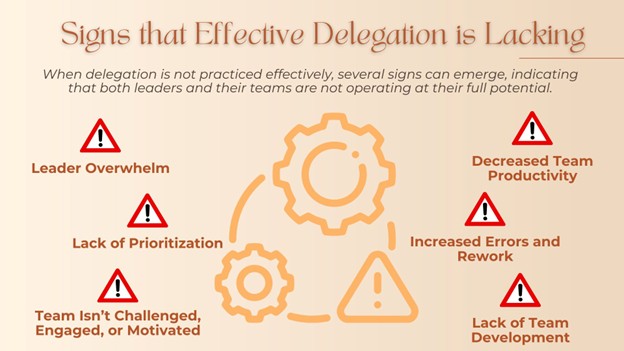
Signs That Effective Delegation is Lacking
Effective delegation is crucial for maintaining a balanced and efficient leadership approach. However, when delegation is not practiced effectively, several signs can emerge, indicating that both leaders and their teams are not operating at their full potential.
Leader Overwhelm: One of the most apparent signs of inadequate delegation is leader overwhelm. When leaders fail to delegate effectively, they often find themselves inundated with tasks that could be managed by others, leading to increased stress and burnout. According to a study published by the American Institute of Stress, 73% of leaders experience regular stress due to overloading themselves with responsibilities that could be delegated. This overwhelm not only impacts their well-being but also diminishes their capacity to focus on strategic, high-priority activities.
Lack of Prioritization: A lack of effective delegation often results in poor task prioritization. Leaders who try to manage everything themselves may struggle to distinguish between tasks that require their immediate attention and those that do not. This inability to prioritize effectively can lead to missed deadlines and decreased productivity. Research indicates that leaders who do not delegate well may waste up to 30% of their time on tasks that do not align with their strategic goals, according to the Harvard Business Review.
Team Isn’t Challenged, Engaged, or Motivated: When leaders hold onto tasks that could be delegated, team members may feel underutilized and disengaged. Without opportunities to take on challenging responsibilities, team members may lack motivation and fail to develop their skills. A Gallup poll found that only 33% of employees are actively engaged at work, a statistic that can be improved through effective delegation that empowers and motivates team members by giving them ownership of tasks and projects.
Decreased Team Productivity: Teams suffer in productivity when leaders do not delegate effectively. Without clear distribution of responsibilities, team members can become confused about their roles, leading to inefficiencies and a decline in overall team output. The Project Management Institute reports that poor delegation can result in projects running over budget and past deadlines, impacting team productivity and morale.
Increased Errors and Rework: A lack of delegation can lead to increased errors and the need for rework, as leaders stretched too thin may not have the bandwidth to ensure thoroughness and accuracy in their work. This not only affects project timelines but also the quality of deliverables. A study by the Association for Talent Development found that organizations with poor delegation practices experience a 15% increase in error rates.
Lack of Team Development: When leaders fail to delegate, they inadvertently stifle the growth and development opportunities for their team members. Without delegated responsibilities, team members miss out on learning experiences and skill development that are crucial for their professional growth. According to the Society for Human Resource Management, organizations that prioritize delegation see a 20% improvement in employee development and retention.
Keeping with the same analogy used earlier, a workplace manager and leader and their team can be likened to a professional football team, where all members work towards the same goal, although they operate from different roles and positions.
A lack of delegation in leadership in the workplace is akin to a football coach trying to play every position on the field, rather than guiding their players to use their specialized talents and skills. Just as a football team thrives on each player understanding their role and contributing to the team’s success, a workplace functions best when leaders delegate tasks that allow team members to engage meaningfully with their work.
Recognizing these signs is the first step towards improving delegation practices. By addressing leader overwhelm, enhancing task prioritization, and ensuring teams are challenged and engaged, leaders can foster a more dynamic and productive work environment, ultimately enhancing organizational success.
Investing in Recognizing Team Member Potential and Nurturing Talent
Recognizing and nurturing the potential of your team members is a cornerstone of effective delegation and an essential component of conscious leadership. Although we will explore this topic more deeply as the ‘Evolutionary Leader’ program progresses, it is crucial to introduce it here to underscore its importance in the context of delegation.
Investing in understanding and developing each team member’s unique strengths not only enhances the delegation process but also significantly boosts team morale and engagement. When leaders take the time to identify the capabilities and ambitions of their team, they can delegate tasks more effectively, ensuring that responsibilities align with each individual’s skills and developmental goals. This alignment is key to fostering a sense of ownership and motivation within the team, leading to higher productivity and satisfaction.
A study by Gallup found that employees who feel their strengths are recognized and utilized are six times more likely to be engaged in their work. This engagement translates into tangible benefits for the organization, including increased innovation and a reduction in turnover rates. Moreover, when team members are trusted with tasks that challenge them and leverage their strengths, they are more likely to contribute creative solutions and exhibit a proactive approach to problem-solving.
Recognizing and nurturing team talent also aligns with the strategic goals of the organization. By developing a workforce that is both skilled and motivated, leaders can ensure that their teams are well-equipped to meet organizational objectives and adapt to evolving business needs. According to the Society for Human Resource Management, organizations that invest in employee development see a 20% increase in performance outcomes, underscoring the critical link between talent development and organizational success.
As we continue through the ‘Evolutionary Leader’ program, you will gain deeper insights into strategies for identifying and cultivating the potential within your team. For now, consider how recognizing and nurturing talent can transform your delegation practices, enabling you to foster a more dynamic, engaged, and strategically aligned team. By investing in your team members’ growth, you not only enhance their capabilities but also reinforce your own leadership effectiveness, paving the way for a culture of continuous improvement and success.
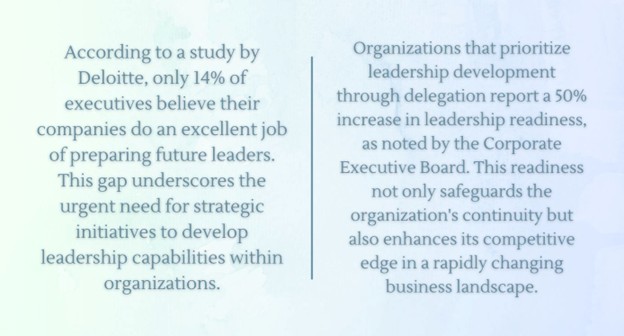
Effective Delegation and Leadership Succession Planning
Leadership succession planning is a strategic process that ensures an organization is prepared to fill key leadership roles as they become vacant. This involves identifying and developing potential future leaders to ensure a seamless transition of leadership. Effective delegation plays a crucial role in this process by preparing team members for future leadership responsibilities and enhancing the organization’s talent pipeline.
In recent years, many organizations have faced challenges in effective leadership succession planning. According to a study by Deloitte, only 14% of executives believe their companies do an excellent job of preparing future leaders. This gap underscores the urgent need for strategic initiatives to develop leadership capabilities within organizations.
Delegation serves as a powerful tool for leadership succession by providing team members with opportunities to take on new responsibilities and develop critical skills. When leaders delegate effectively, they not only manage their workload more efficiently but also pave the way for team members to gain the experience necessary for future leadership roles. This hands-on exposure is invaluable in nurturing the next generation of leaders who are well-versed in the intricacies of decision-making and strategic thinking.
Furthermore, delegation is instrumental in expanding a company’s talent pipeline. By entrusting team members with meaningful tasks, leaders can identify individuals who exhibit potential for higher-level responsibilities. This proactive approach to talent development ensures that an organization has a ready pool of capable leaders who can step up as opportunities arise.
Statistics highlight the benefits of integrating delegation into succession planning. Organizations that prioritize leadership development through delegation report a 50% increase in leadership readiness, as noted by the Corporate Executive Board. This readiness not only safeguards the organization’s continuity but also enhances its competitive edge in a rapidly changing business landscape.
By weaving delegation into the fabric of leadership succession planning, organizations can build a robust framework for sustainable growth and continuity. As we continue through the ‘Evolutionary Leader’ program, we will further explore strategies for effective succession planning, ensuring your organization remains resilient and future ready.

Case Studies
Welcome to the ‘Case Studies’ section of Chapter 8: Delegating Tasks, where we delve into real-world scenarios to illuminate the nuances of effective delegation. Through these case studies, we gain invaluable insights into the practical challenges and transformative potential of delegation in leadership.
Each case study offers a unique perspective, from the individual dynamics between managers and team members to broader organizational strategies. These examples not only highlight common delegation obstacles but also showcase how thoughtful approaches can lead to enhanced productivity, stronger team morale, and the cultivation of a trust-based culture.
By exploring these diverse scenarios, you will deepen your understanding of how effective delegation can drive business success and foster an environment of empowerment and innovation. These stories serve as powerful reminders of the impact delegation can have on both personal growth and organizational development, equipping you with strategies to enhance your leadership journey.
Case Study #1: Learning to Delegate
In the case study “Learning to Delegate” by Gina Abudi, the challenges of effective delegation are explored through the experiences of Anna, a manager, and Amanda, her direct report. Anna has delegated several projects to Amanda, but finds herself frustrated as Amanda frequently seeks guidance for every decision, indicating a lack of confidence in handling tasks independently.
The case highlights the importance of understanding the skills, experiences, and comfort levels of team members to delegate effectively. Anna’s situation suggests that she may not have fully assessed Amanda’s readiness for the tasks or provided the necessary support and autonomy. This scenario underscores the need for managers to tailor their delegation approach based on individual team member capabilities.
To resolve the issue, Anna is encouraged to have an open conversation with Amanda to understand her hesitations and collaboratively find ways to empower her to make decisions. This approach not only helps in building Amanda’s confidence but also enhances Anna’s ability to delegate effectively by aligning tasks with Amanda’s strengths and developmental needs.
You can read the full case study here
Case Study #2: Effective Delegation Examples in the Workplace
The article “19+ Effective Delegation Examples In The Workplace 2024” from Genius provides a comprehensive overview of how effective delegation can transform team dynamics and enhance business success. It highlights the importance of delegation in streamlining workloads, leveraging team strengths, freeing up time for strategic planning, boosting team morale, and improving decision-making.
The case study presents real-life examples of tasks that can be delegated across various business functions, such as email management, social media management, data entry, customer service, and project management. Each example illustrates the benefits of delegation, such as improved efficiency, enhanced quality of work, and better time management.
Key insights include the necessity of matching tasks with the right team members based on their skills and expertise, setting clear expectations and deadlines, and providing the necessary resources and authority to complete tasks. The article emphasizes that effective delegation is a hallmark of strong leadership, fostering a culture of trust and empowerment within teams.
By showcasing these examples, the case study underscores the potential of delegation to reduce burnout among leaders, as evidenced by the statistic that 48% of CEOs feel burnt out, highlighting the need for improved work management practices.
You can read the full case study here
Case Study #3: A Business Case for Effective Delegation
In the case study “A Business Case for Effective Delegation” by Sam Harrowfield, the importance of delegation in enhancing organizational performance and efficiency is explored. The study emphasizes that delegation is not merely about offloading tasks but is a strategic tool that can unlock the potential of team members and improve business outcomes.
Key points include:
Time Management: Effective delegation allows leaders to focus on high-priority tasks, thereby increasing their productivity and enabling them to meet key goals more efficiently. Research cited from the Harvard Business Review indicates that partners who delegate effectively can earn 20% more by freeing up their time.
Organizational Efficiency: Delegation boosts efficiency by assigning tasks to those best suited for them, leading to higher quality work and faster completion times.
Trust and Engagement: Delegation builds trust within teams, as it empowers employees by giving them autonomy and the opportunity to demonstrate their capabilities. This empowerment leads to increased engagement and satisfaction, which are crucial for employee retention and motivation.
Productivity and Innovation: By fostering an environment where team members feel trusted and valued, delegation encourages initiative and innovation, contributing to a more dynamic and committed workforce.
Overall, the case study illustrates that while delegation requires an initial investment of time and effort, it ultimately leads to significant organizational benefits, including improved productivity, enhanced team morale, and a stronger culture of trust and innovation.
You can read the full case study here
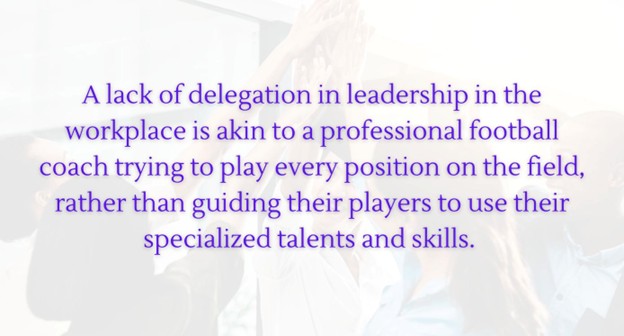
Trust as the Foundation of Effective Delegation
In the realm of conscious leadership, trust serves as the bedrock upon which effective delegation is built. It is the catalyst that transforms a simple task assignment into a powerful tool for empowerment and innovation. For leaders, establishing trust begins with themselves – having confidence in their ability to prioritize and recognize the potential within their team. This self-trust is paramount, for a leader can only trust others as effectively as they trust themselves.
Trust in Yourself
Trusting oneself involves the conviction to make sound decisions about which tasks to delegate and to whom. It requires leaders to assess their capabilities honestly and to rely on their judgment when identifying the strengths and developmental needs of team members. A study by the American Psychological Association found that leaders who exhibit high levels of self-trust are more decisive and effective in their roles, which in turn fosters a more cohesive and motivated team environment.
Self-trust also involves acknowledging one’s limitations and recognizing when to seek input from others. This openness not only enriches decision-making processes but also sets a precedent for transparency and collaboration across the team.
Trust in Others
Delegation is inherently an act of trust in others. It is about entrusting team members with responsibilities and allowing them the autonomy to execute tasks in their own way. A Gallup survey reported that employees who feel trusted by their leaders are 70% more engaged, which significantly enhances overall team performance and job satisfaction.
Trusting others involves clear communication of expectations and granting them the authority to make decisions. This empowerment not only motivates team members but also encourages them to take ownership of their work, driving innovation and productivity. When leaders trust their teams, they create a culture where individuals feel valued and are more likely to contribute their best efforts.
Cultivating a Culture of Trust
The establishment of trust within a team can lead to a transformative work environment. According to research from the Society for Human Resource Management, organizations with high levels of trust report a 36% increase in employee performance and a 50% reduction in turnover rates. Such statistics underscore trust’s profound impact on organizational success.
To cultivate this culture, leaders must lead by example—demonstrating trust through their actions and interactions. This includes providing support, feedback, and recognition, which reinforces the team’s belief in their own capabilities and that of their peers.
Trust is not merely a component of effective delegation; it is its foundation. By fostering self-trust and extending that trust to others, leaders can build a resilient and innovative team culture. This culture not only drives organizational success but also paves the way for the development of future leaders, fulfilling the sacred mission of creating more leaders within this ‘Evolutionary Leader’ training program.
Overcoming Perfectionism: Learning to Let Go and Avoid Micromanaging
Perfectionism, often defined as the relentless pursuit of flawlessness, poses significant challenges for many workplace managers and leaders. While striving for excellence can be beneficial, perfectionism can lead to excessive control and an inability to delegate, stifling both personal growth and team development. Studies show that perfectionistic tendencies can increase stress and hinder productivity, highlighting the need for leaders to adapt to more flexible and empowering management styles.
The Challenge of Perfectionism
Many leaders struggle with perfectionism, which can manifest as a need to oversee every detail and correct every perceived imperfection. This mindset often leads to micromanagement – a management style where leaders excessively control or interfere with team members’ work. According to the Journal of Applied Psychology, micromanagement can decrease employee engagement by up to 28%, leading to diminished creativity and innovation.
Learning to Let Go
Overcoming perfectionism requires leaders to trust in their own leadership abilities as well as in their team’s capabilities and to embrace the concept of letting go. This shift is not about lowering standards but about recognizing that different approaches can lead to equally successful outcomes. By learning to delegate effectively, leaders can focus on strategic priorities while allowing team members to leverage their strengths and skills.
Avoiding Micromanagement
Avoiding micromanagement is essential for fostering a culture of empowerment and accountability. Introducing the concept of co-empowering workplace relationships, leaders can create an environment where team members are encouraged to grow and develop. This involves recognizing an individual’s potential and providing the room for them to innovate and take ownership of their work.
Benefits of Co-Empowerment
By avoiding micromanagement and embracing co-empowerment, leaders open the door to increased innovation, creativity, and collaboration. Teams that operate with autonomy are more likely to explore new ideas and solutions, driving the organization forward. The Harvard Business Review reports that organizations with empowered teams see a 32% increase in collective innovation.
Fostering Accountability and Alignment
Empowered teams are also more accountable, as they take ownership of their tasks and outcomes. This leads to a more aligned workforce, where everyone works towards the same goals and objectives. According to a study by Gallup, teams with high accountability outperform their peers by 25% in productivity and engagement.
By overcoming perfectionism, learning to let go, and avoiding micromanagement, leaders can foster a culture of innovation and accountability. Embracing co-empowerment will not only enhance team performance but also pave the way for a more resilient and dynamic organization. As we delve deeper into the ‘Evolutionary Leader’ program, you’ll discover strategies to implement these practices effectively, ensuring that both you and your team thrive in a collaborative and growth-oriented environment.
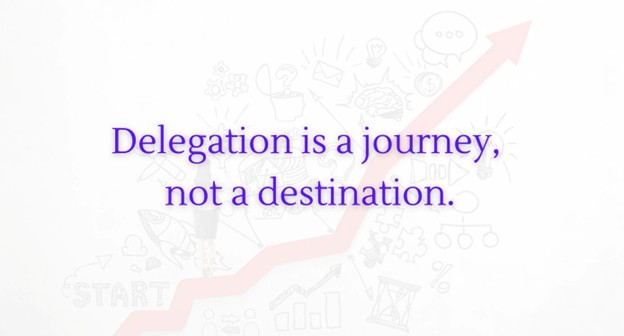
The Delegation Journey: From Initial Hurdles to Lasting Success
Embracing the art of delegation is a journey that, while demanding more effort initially, yields substantial rewards over time. It’s important to recognize that delegation is not merely about offloading tasks – it’s a strategic process centered on empowering and nurturing your team members, ultimately enhancing your growth, their growth and the organization’s success.
Initial Challenges of Delegation
As you begin to delegate, expect that there may be an increase in questions and a few initial mistakes. This phase may feel time-consuming and challenging, as you might battle with thoughts that tasks would be quicker if completed by yourself. However, this mindset undermines the broader goals of delegation, which aim to increase your productivity and effectiveness as a leader as well as cultivate a capable and autonomous workforce. Studies indicate that leaders who persist through the initial challenges of delegation experience significant long-term productivity gains. According to the American Management Association, effective delegation can reduce a leader’s workload by 20%, enabling a sharper focus on strategic initiatives.
Patience and Growth
Patience is your ally in this process. Allowing both yourself and your team to adapt and grow is crucial. While it may take time for team members to adjust to new responsibilities, being patient and providing them with the support they need is essential. Remember, each delegation effort is an investment in your team’s development and your own leadership capacity.
Empowerment and Leadership Development
Effective delegation is a cornerstone of a conscious time management plan and aligns with your leader sacred mission. It provides a platform for developing mentoring and coaching skills—competencies that are integral to the ‘Evolutionary Leader’ program and will be explored further in later workshops. By nurturing these skills, you enhance your conscious leadership capabilities, creating a robust environment for continuous personal and professional growth.
The Profound Impact of Delegation
Data supports the profound impact of delegation on team dynamics and success. Organizations that embrace delegation see a 30% improvement in team productivity and a 25% increase in engagement, as reported by Gallup. These statistics underscore the importance of viewing delegation not as a task to be checked off, but as a vital component of leadership effectiveness and organizational vitality.
While the path to effective delegation may involve more work initially, the long-term benefits far outweigh the temporary hurdles. By delegating tasks, you can begin emerging from the ‘operational weeds’ and focus on tasks in alignment with your leadership role and strategic goals. By empowering your team, you foster an environment of innovation and accountability, paving the way for sustained success and leadership excellence. As you continue your journey through the ‘Evolutionary Leader’ program, you’ll gain insights and tools to refine and enhance your delegation strategies, ensuring a thriving, empowered team ready to meet future challenges.

Exercise
• Each participant shares a brief experience where delegation either succeeded or fell short. Discuss the outcomes, focusing on what worked and what could have been improved.
• Reflect on the feelings of empowerment or challenges faced during these experiences.
• Collaboratively identify the key elements that make delegation effective. Consider factors such as trust, communication, and alignment with team strengths.
• List these elements and discuss how they contribute to successful delegation.
• Choose a representative from each group to present one key takeaway or strategy to the larger group.
• Facilitate a brief discussion on how these insights could be applied to enhance delegation practices within their teams.

Course Manual 9: Designing Your Efficient Space
Continuing Your Journey of Bridging the Gap
As we enter Chapter 9, we shift our focus to the pivotal role of crafting an ideal workspace and environment that heightens both creativity and efficiency. Building on the foundation of awareness, reflection and intention established in earlier chapters, we continue to bridge the gap between our current practices and our aspirational state of productivity and innovation. This chapter is dedicated to transforming your workspace into a catalyst for success, recognizing that the physical and psychological environments significantly impact our ability to perform at our best.
Defining the Ideal Workspace: A Catalyst for Creativity and Efficiency
Crafting an ideal workspace is an essential endeavor for leaders aiming to maximize both creativity and efficiency. This practice is not just about aesthetics or organization; it is a strategic move that significantly impacts productivity and well-being. The modern work environment demands that leaders balance myriad responsibilities while fostering innovation and maintaining focus. An intentionally designed workspace serves as the foundation upon which these capabilities are built.
A well-curated workspace enhances concentration and minimizes interruptions, acting as a catalyst for creativity. According to recent research, individuals working in environments designed to their preferences can experience a 15% improvement in creative problem-solving. This underscores the importance of a personalized workspace that aligns with individual work styles and preferences, ultimately boosting creative output and satisfaction.
The significance of an ideal workspace extends to efficiency. Studies reveal that employees in well-organized environments are 25% more efficient, showcasing the direct correlation between workspace setup and task completion rates. The strategic arrangement of tools and resources within easy reach reduces time spent on unnecessary movements and allows for seamless workflow transitions. This efficiency not only saves time but also conserves mental energy for more complex tasks.
Incorporating elements that support mental and physical well-being is crucial. Ergonomic furniture, for example, can reduce musculoskeletal strain, leading to a 17% decrease in work-related discomfort and absenteeism. Furthermore, the inclusion of biophilic elements, such as plants, has been shown to enhance cognitive function by 26%, as they contribute to a calming environment that counters stress and refreshes the mind.
The benefits of an optimized workspace are not limited to individual performance; they ripple outward to influence team dynamics and organizational culture. A leader’s commitment to maintaining an ideal workspace sets a precedent for the team, promoting a culture of efficiency and innovation. As team members observe and adopt these practices, overall productivity can increase, paving the way for collective success and growth.
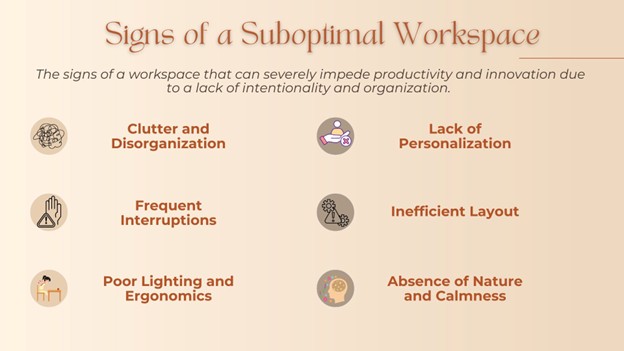
Recognizing the Signs of a Suboptimal Workspace
Identifying a suboptimal workspace is crucial for leaders striving to enhance creativity and efficiency. A workspace that lacks intentionality and organization can severely impede productivity and innovation. Recognizing the signs of such a workspace is the first step toward transformation and optimization.
Clutter and Disorganization: A primary indicator of a suboptimal workspace is excessive clutter and disorganization. Studies show that the average employee spends about 5 hours per week searching for misplaced items, leading to frustration and wasted time. This chaos can disrupt focus and hinder the ability to work efficiently, ultimately affecting overall productivity.
Frequent Interruptions: A workspace that allows for constant interruptions is another telltale sign of suboptimality. If you’ll remember, according to research, it can take up to 23 minutes to regain focus after being interrupted. This frequent loss of concentration not only delays task completion but also diminishes the quality of work produced. Implementing boundaries around availability and creating cues for focus time can mitigate these interruptions.
Poor Lighting and Ergonomics: Insufficient lighting and uncomfortable furniture can also signal an ineffective workspace. Adequate lighting is pivotal, as inadequate lighting is linked to a 20% increase in eye strain and fatigue. Similarly, a lack of ergonomic furniture can lead to physical discomfort, contributing to a 30% rise in musculoskeletal problems, which can further reduce productivity and increase absenteeism.
Lack of Personalization: A workspace that fails to reflect personal preferences and needs often lacks the motivational qualities necessary for peak performance. Personalized workspaces have been shown to increase job satisfaction by 25% and enhance creative thinking. The absence of personal elements can make the environment feel sterile and uninspiring, which stifles innovation.
Inefficient Layout: An inefficient workspace layout that requires unnecessary movements or makes essential tools hard to reach can also be problematic. This inefficiency can slow down workflow processes and lead to increased fatigue. An optimized layout that supports natural workflow can improve task efficiency by up to 20%.
Absence of Nature and Calmness: Finally, a workspace devoid of natural elements or a calming atmosphere can contribute to heightened stress levels and decreased cognitive performance. The inclusion of plants and natural decor has been linked to a 15% boost in well-being and a reduction in stress-related symptoms.
Recognizing these signs is vital for leaders who aim to foster an environment that supports both individual and team success. By addressing these indicators, leaders can transform their workspaces into hubs of creativity and efficiency to cultivate conscious leadership through an optimized environment.

Case Studies
In the journey towards optimizing creativity and efficiency within your workspace, learning from real-world examples becomes an invaluable tool. The following case studies illuminate successful strategies and innovative solutions undertaken by organizations committed to transforming their environments. Each story provides insightful lessons on the importance of intentional workspace design and management.
As we strive to enhance focus and foster conscious leadership, these examples serve as a testament to the profound impact that a thoughtfully curated workspace can have on performance and well-being. Whether it’s through strategic space optimization or effective resource management, these case studies reveal the tangible benefits of optimizing your physical work environment for efficiency, productivity and wellbeing.
By examining these cases, you will gain practical insights into how leaders can create spaces that not only drive productivity but also inspire innovation and engagement. This approach is essential for cultivating a work atmosphere that supports individual excellence and cultivates collective success.
Case Study #1: Enhancing Office Space and Energy Efficiency
Situation: A company was transitioning to a hybrid work model and needed to improve both office space utilization and energy efficiency.
Actions Taken: The organization implemented strategic changes to optimize their physical space, incorporating energy-efficient practices and redesigning layouts to better accommodate hybrid working conditions.
Results: These initiatives led to substantial improvements in energy consumption and workspace efficiency, creating a more sustainable and productive environment that supported the new hybrid work era.
You can read the full case study here
Case Study #2: Workspace Management with Room Manager
Situation: Various businesses were struggling with ineffective workspace management, leading to underutilized office areas and decreased employee satisfaction.
Actions Taken: These companies adopted Room Manager solutions, which provided tools for better workspace scheduling, resource allocation, and overall management.
Results: The implementation of Room Manager resulted in enhanced workspace utilization, improved scheduling efficiency, and increased employee satisfaction, ultimately leading to more effective and engaging work environments.
You can read the full case study here
Case Study #3: Microsoft: The New World of Work
Situation: Microsoft Sweden aimed to transform its office environment to better support a modern, flexible work culture.
Actions Taken: They introduced innovative workspace designs, featuring flexible spaces that could be easily reconfigured, alongside policies that supported remote and hybrid work.
Results: This approach significantly boosted employee engagement and productivity by fostering a more dynamic and adaptable work setting, aligning with contemporary work trends and enhancing Microsoft’s overall organizational performance.
You can read the full case study here

Environmental Optimization Check
An Environmental Optimization Check serves as a comprehensive assessment of your current workspace, aimed at identifying areas that may be hindering productivity and creativity. This proactive approach involves evaluating various elements of your work environment to ensure they support both efficiency and well-being.
Key Elements to Assess:
Ergonomic Furniture: Consider the setup of your desk, chair, and other furniture to ensure they support good posture and reduce physical strain. Look for features such as adjustable chairs or standing desks, which can significantly decrease musculoskeletal discomfort and improve overall comfort.
Lighting Quality: Consider both natural and artificial lighting in your workspace. Ensure that the lighting is adequate and minimizes glare, as exposure to proper lighting can enhance mood and concentration. If natural light is limited, consider using daylight-mimicking LED lights to reduce eye strain.
Biophilic Elements: Consider the presence of natural elements such as plants and water features, which can boost cognitive function and create a calming atmosphere. Including greenery not only enhances air quality but also promotes a sense of tranquility and focus.
Tips for Improving Your Workspace:
Ergonomic Enhancements: Invest in ergonomic furniture that can be adjusted to fit your body’s needs. Simple changes, like adjusting the height of your chair and screen, can prevent physical discomfort and promote sustained focus.
Lighting Adjustments: Position your desk to take advantage of natural light whenever possible. If that’s not feasible, use high-quality artificial lighting that closely replicates natural daylight to maintain energy levels and reduce visual fatigue.
Incorporate Nature: Add plants or nature-inspired decor to your workspace. This not only improves aesthetics but also reduces stress and increases productivity by connecting you with nature.
Conducting regular Environmental Optimization Checks ensures that your workspace remains a productive and inspiring environment. By making thoughtful adjustments based on your assessment, you create a supportive setting that aligns with the objectives of the ‘Evolutionary Leader’ program, fostering a culture of conscious leadership and innovation.
Revisiting Your Ideal State and Environment
In the quest to optimize creativity and efficiency, revisiting the foundational concepts from Chapter 2 is essential. This chapter originally emphasized defining your ideal state and environment—conditions that enable you to perform at your best. Aligning your workspace with these preferences is not only beneficial for immediate productivity but also for long-term personal and professional growth.
Research highlights the significant impact of personalized environments on performance. Studies show that when individuals work in settings tailored to their preferences, there is a 15% increase in creative output and a 25% boost in efficiency. These figures underscore the value of a workspace that is both functional and inspiring, catering to the unique needs and aspirations of each individual.
Key Insights:
Time and Workflow Integration: Reflecting on your peak productivity periods is important in optimizing your workspace to support these times—whether it’s mornings or late afternoons—can enhance focus and resource availability, enabling a smoother workflow.
Minimizing Distractions: Understanding sources of interruptions and addressing them can lead to more efficient work habits. Physical adjustments like strategic seating arrangements or digital solutions such as noise-cancelling tools can help maintain concentration.
Energy Alignment: Recognizing your energy peaks allows for better workspace planning, ensuring that your environment complements your natural rhythms. This might involve adjusting lighting, incorporating ergonomic furniture, or providing access to relaxing spaces to prevent fatigue.
Enhancing Personalization and Well-being:
Personalizing your workspace involves incorporating elements that resonate with you, such as preferred colors, textures, or decor items. This personal connection not only boosts motivation but also enriches the overall work experience. Likewise, integrating modern technology wisely can streamline processes and reduce digital clutter, fostering a more productive atmosphere.
Moreover, prioritizing well-being within your workspace setup is crucial. Balancing work with regular breaks and incorporating movement or relaxation opportunities can significantly enhance mental and physical health, which in turn supports sustained productivity.
By aligning your workspace with your ideal state and environment, you create a supportive foundation for thriving in your leadership journey.

Organizing Your Workspace and Removing Clutter
As we’ve been exploring, creating a well-organized workspace is a vital step in enhancing productivity and creativity. This concept extends beyond mere tidiness, as the organization or lack thereof of our surroundings has real energetic impacts that influence our work environment. An organized space fosters feelings of stability, grounding, and security, which are essential for both personal and professional growth.
The Energetic Connection:
An efficiently organized workspace supports a stable environment, promoting focus and efficiency. When your workspace is free from clutter, it aligns with the principles of energetic balance, enhancing mental clarity and reducing stress. This alignment creates an atmosphere where creativity and productivity can flourish.
The Concept of ‘Everything Has a Place’:
The idea that everything has a designated place is fundamental to an organized workspace. This is not just about aesthetics but is intricately linked to efficiency and productivity. Studies indicate that a clutter-free environment can improve focus and task performance by up to 25%. By assigning a specific place for each item, you minimize time spent searching for materials and reduce mental distractions, facilitating a seamless workflow.
Practical Steps for Organization:
Declutter Regularly: Schedule periodic reviews of your workspace to eliminate unnecessary items. This practice not only clears physical space but also rejuvenates your mental landscape, enabling better focus and creativity.
Designate Zones: Create specific areas for different types of work or materials. For instance, having a separate zone for creative tasks and another for administrative duties can help you switch gears more efficiently.
Utilize Storage Solutions: Invest in smart storage solutions that keep essential tools within reach while maintaining a clean and organized appearance. This approach prevents the workspace from becoming overwhelmed with items that disrupt flow.
Impact on Productivity:
Effective organization fosters a more efficient use of energy and time. According to research, employees in well-organized environments are 25% more productive, as they can focus on tasks without the hindrance of clutter. Additionally, a neat workspace can lead to a 15% increase in overall satisfaction and well-being, further amplifying both individual and team performance.
Ensuring Necessary Tools and Resources Are Within Reach
In the pursuit of an ideal workspace that fosters creativity and efficiency, ensuring that essential tools and resources are within easy reach is crucial. A well-equipped environment not only streamlines workflow but also enhances focus and minimizes the time spent searching for items, thereby optimizing productivity.
Research indicates that employees can lose up to 11% of their productive time due to inefficient workspace organization. This highlights the importance of strategic placement of tools and resources. By establishing a layout where everything needed for daily tasks is easily accessible, you can significantly reduce downtime and improve task completion rates.
Strategic Organization of Tools:
Identifying the most frequently used tools and positioning them within arm’s reach can save significant time and energy. For instance, keeping office supplies, reference materials, and digital devices close by reduces unnecessary movement and interruptions during focused work periods. This approach not only enhances productivity by up to 20% but also supports a seamless transition between tasks.
Maximizing Resource Accessibility:
In a digital age, having quick access to technological resources is equally important. Ensuring that all necessary software, files, and digital tools are readily available can prevent workflow disruptions. Implementing cloud-based solutions or centralized digital repositories can further increase accessibility and reduce search time for digital assets by approximately 30%.
Creating an Intuitive Workspace Layout:
An intuitive workspace layout goes beyond mere organization; it involves tailoring your environment to your work habits and tasks. Studies show that an efficiently designed workspace can boost employee satisfaction by 25%, as it aligns with their natural movements and work processes. By categorizing tools and supplies based on function and usage frequency, you create a logical system that enhances operational flow.
Benefits of an Optimized Environment:
An organized, resource-rich environment contributes significantly to mental clarity and creativity. When tools and resources are easily accessible, employees experience a reduction in cognitive load, allowing for more brainpower to be dedicated to problem-solving and innovation. This is supported by findings that suggest a 15% increase in creative output when individuals operate in well-organized spaces.
The strategic organization of tools and resources within a workspace is more than just a practical consideration; it is a foundational element in creating an environment that supports peak performance. By investing time in setting up an accessible and resource-efficient workspace, leaders can cultivate an atmosphere where creativity and efficiency thrive.

Incorporating Nature and Calmness Elements
In crafting a workspace that optimizes creativity and efficiency, incorporating elements of nature and calmness can profoundly enhance both productivity and well-being. A workspace that integrates ergonomic furniture, proper lighting, and natural elements not only boosts performance but also fosters a sense of tranquility, reducing stress and invigorating the mind.
Implementing ergonomic furniture is essential for creating a comfortable and health-conscious workspace. Proper ergonomic design reduces musculoskeletal strain and enhances comfort, leading to a 17% decrease in work-related discomfort and absenteeism. Adjustable chairs and desks that cater to individual needs can significantly improve posture and workflow, preventing fatigue and enhancing focus throughout the day.
Lighting plays a critical role in workspace efficiency and mood regulation. Exposure to natural light can enhance productivity by up to 18%, as it helps regulate circadian rhythms, improving sleep quality and overall cognitive function. Where natural light is limited, using daylight-mimicking LED lights can combat eye strain and fatigue, creating an environment that supports sustained attention and mental clarity.
Incorporating nature into the workspace, such as plants and water features, can lead to a 15% increase in well-being and a 26% boost in cognitive function. These biophilic elements improve air quality and provide a soothing visual experience, which can reduce stress and enhance creativity. The presence of greenery and natural textures has been shown to foster a calming atmosphere that refreshes the mind and supports innovative thinking.
In addition to natural elements, incorporating calming décor such as nature-inspired art or photographs can further enhance the workspace’s serenity. These elements serve as micro-breaks for the mind, offering moments of visual respite that can rejuvenate mental resources and elevate mood. Studies suggest that environments enriched with calming visuals can reduce stress levels by up to 20%, providing a supportive backdrop for focused work.
By integrating ergonomic furniture, optimal lighting, and nature-inspired elements, leaders can create a workspace that not only supports physical health but also nurtures mental well-being. This holistic approach aligns with the principles of the ‘Evolutionary Leader’ program, promoting a culture of conscious leadership and sustainable productivity. These enhancements set the stage for a workspace that is not only efficient and effective but also a source of inspiration and calm.
Eliminating Unnecessary Disturbances
Creating a workspace that optimizes creativity and efficiency involves not only incorporating beneficial elements but also eliminating unnecessary disturbances that can impede focus. Distractions in the workspace, particularly digital interruptions, are significant barriers to productivity, often leading to decreased performance and increased stress. By strategically identifying and managing these elements, leaders can cultivate an environment conducive to deep work and innovation.
Identifying Common Distractions:
Common distractions in the workspace can stem from various sources, including noise, digital interruptions like social media alerts, email notifications, non-urgent text messages, and phone calls. Research indicates that office workers are interrupted or switch tasks every three minutes, which can lead to a 40% reduction in productivity. Recognizing these distractions is the first step in addressing them effectively.
Strategies for Managing Digital Interruptions:
Digital interruptions are among the most pervasive disturbances in today’s work environments. Setting specific times to check emails and silencing non-essential notifications during focused work periods can substantially improve concentration. Research suggests that managing digital interruptions in this way can improve workplace productivity by up to 25%. Tools such as app blockers can aid in minimizing social media distractions, while setting specific times for checking messages and calls can help maintain focus on tasks at hand.
Noise Reduction Techniques:
Noise, whether from the office environment or digital alerts, can be a constant source of distraction. Implementing noise-canceling headphones or sound-absorbing materials can significantly reduce auditory disturbances. Studies show that employees working in quieter environments experience a 20% increase in concentration and task performance.
Reducing Visual Clutter:
Visual distractions, such as excessive digital alerts or movement in the peripheral vision, can also hinder focus. Creating a clean and organized workspace, possibly with the aid of privacy screens or designated quiet zones, can help minimize these visual interruptions. A visually serene environment can enhance focus by 15%, allowing for deeper cognitive processing and creativity.
Implementing Time Management Techniques:
Techniques such as the Pomodoro Technique, which involves working in short, focused bursts with regular breaks, can help manage time effectively and reduce susceptibility to distractions. This structured approach not only boosts productivity by 30% but also helps maintain sustained attention and energy throughout the workday.
By eliminating unnecessary disturbances, particularly digital interruptions, leaders can create a workspace that supports uninterrupted focus and maximizes productivity. These strategies not only enhance individual performance but also contribute to a more cohesive and efficient team dynamic. Aligning with the goals of the ‘Evolutionary Leader’ program, a distraction-free environment empowers leaders to engage deeply with their work and drive meaningful progress within their organization.
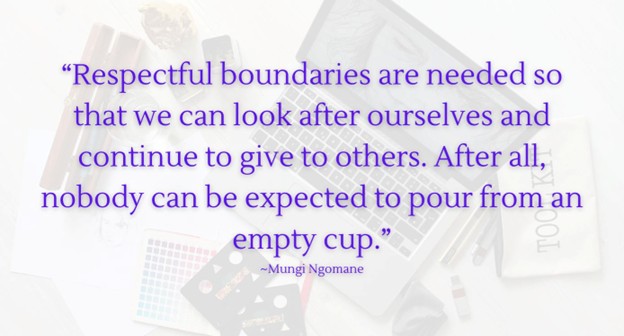
Revisiting Healthy Boundaries in Workspace Design
As we continue to refine our understanding of creating an ideal workspace, it’s crucial to revisit the concepts of healthy boundaries introduced in Chapter 7. Applying these principles to workspace design empowers leaders to protect their focus and energy, ensuring an environment conducive to sustained productivity and well-being.
Integrating Boundaries with Workspace Design:
Setting healthy boundaries within your workspace involves creating a physical environment that supports your mental and emotional needs. This includes establishing clear limits on the use of your space and time to foster a zone of uninterrupted focus. A study by the Journal of Occupational Health Psychology indicates that employees with well-defined boundaries in their workspace report a 23% increase in job satisfaction and a 31% reduction in burnout.
Strategies for Setting Workspace Boundaries:
Designate Personal Zones:
Establish specific areas within your workspace for different activities. This physical segregation helps maintain clarity and reduces task-switching fatigue. For instance, having a dedicated area for meetings or phone calls can prevent these activities from encroaching on time meant for focused work.
Create Visual Cues:
Use visual signals to communicate when you are in deep work mode. This might include a “Do Not Disturb” sign or subtle indicators like a closed door or headphones. These cues signal your unavailability for non-urgent matters, minimizing interruptions and preserving your focus.
Implement Time Blocks:
Allocate specific blocks of time for focused work, meetings, and breaks. This structured approach to time management aligns with the Pomodoro Technique, which has been shown to increase productivity by 30% by reducing the impact of interruptions and enhancing concentration levels.
Leverage Technology Wisely:
Use technology to enforce boundaries, such as calendar apps for time blocking or apps that restrict access to distracting websites during work hours. According to research from the American Management Association, effective use of time-management tools can improve productivity by up to 25%.
Personalize Your Environment:
Ensure that your workspace reflects your personal preferences and needs, which can enhance motivation and focus. Personalization can lead to a 15% improvement in creative output, as it fosters a sense of ownership and control over your environment.
Benefits of Boundary-Driven Workspace Design:
By integrating healthy boundaries into workspace design, leaders not only enhance their own productivity but also set a standard for their teams. This approach promotes a culture of respect and intentionality, where team members feel empowered to define and respect their own boundaries. The result is a more harmonious workplace, marked by increased efficiency and a shared commitment to focused work.
Revisiting and applying the principles of healthy boundaries in workspace design is a pivotal step in optimizing creativity and efficiency. By creating a workspace that respects these boundaries, leaders can ensure their environment supports both personal well-being and organizational success, embodying the core values of the ‘Evolutionary Leader’ program.

Exercise
1. Form Small Groups (2-3 participants):
2. Identify Current Workspace Challenges:
o Each participant briefly shares one aspect of their current workspace they find challenging or inefficient.
o Discuss common themes or unique challenges within the group.
3. Brainstorm Solutions:
o Utilize the concepts from Chapter 9, such as decluttering, setting boundaries, and incorporating nature elements.
o Encourage each participant to suggest at least one practical solution to improve workspace efficiency or creativity.
o Consider strategies like organizing tools within easy reach, using plants or biophilic elements for a calming effect, and setting visual or auditory boundaries to minimize distractions.
4. Share and Reflect:
o Each group shares their top three strategies with the larger group.
o Facilitate a brief discussion on how these strategies can be implemented in various work environments.
o Encourage participants to reflect on how these changes could impact their productivity and creativity.

Course Manual 10: Celebrate and Evaluate
Continuing to Bridge the Gap: Celebrating Your Journey
As we delve into Chapter 10, it’s an opportune moment to reflect on the path you’ve embarked upon. This chapter is dedicated to recognizing the strides you’ve begun to take toward closing the gap between your current practices and the aspirational state of being you’ve envisioned. Let’s celebrate the insights you’ve gathered, which have laid the groundwork for enhanced leadership and organizational success.
In Chapter 1, you explored your current time and energy management practices, a crucial step that sets the stage for more effective and conscious leadership. Engaging in this self-reflection can lead to significant productivity gains, with studies suggesting a 30% increase for those who regularly assess their practices.
Chapter 2 invited you to dream boldly and envision your ideal workplace state and environment. This visionary thinking provides a clear trajectory for your leadership journey, with data indicating that leaders with a clear vision are substantially more likely to achieve their strategic objectives.
Chapters 3 and 4 guided you through clarifying your role and responsibilities, as well as defining tasks, goals, and priorities. This clarity can potentially reduce workplace stress and enhance productivity for both you and your team.
In Chapter 5, you were introduced to the concept of devising a daily schedule that integrates technology, breaks, and buffer times. Adopting such structured approaches has been linked to significant increases in task completion rates.
Chapter 6 emphasized mindful energy management practices and the creation of an Energy Boosters toolkit. These insights can help reduce burnout risk, ensuring sustained performance and well-being.
Chapter 7 focused on establishing healthy boundaries within your schedule and environment. Implementing these boundaries can improve work-life balance, which is crucial for long-term leadership effectiveness.
In Chapter 8, you explored the art of delegation and its impact on workflow efficiency. Engaging with these concepts can enhance team cohesion and productivity.
Finally, Chapter 9 encouraged you to transform your workspace to foster focus and efficiency, potentially increasing overall output.
Wow! Congratulations on the progress you’ve made. These insights and the understanding you are building are significant on your path to conscious leadership. By recognizing and celebrating these milestones, you not only boost morale but also reinforce positive dynamics within your team. As you continue this journey, remember that these achievements are laying the foundation for sustainable success and innovation. Keep moving forward with confidence, knowing you’re building a leadership legacy that inspires and empowers others.
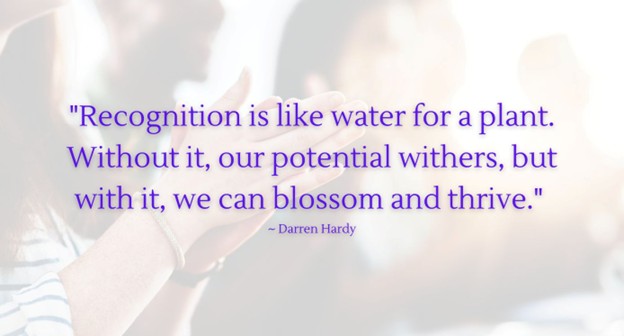
The Power of Recognition and Celebration
In the journey of conscious leadership, recognizing your own achievements and celebrating personal progress are not just ceremonial gestures; they are powerful tools that drive personal growth. Personal recognition involves acknowledging your efforts and successes. This acknowledgment serves as a motivational boost, reinforcing the behaviors and strategies that led to these successes. Celebration is the act of expressing joy and gratitude for these accomplishments, creating a positive atmosphere that inspires continued effort and excellence.
For leaders, recognizing personal achievements is essential for building confidence, maintaining momentum, and fostering a sense of purpose. It reaffirms your leadership journey, reminding you of your capabilities and the impact of your efforts. It also helps ensure you are on the right track to accomplishing your goals. Studies indicate that leaders who regularly acknowledge their accomplishments report a 26% increase in job satisfaction and a greater alignment with their personal and professional goals.
Incorporating regular personal recognition and celebration into your leadership practice can transform your personal and professional outlook. It encourages a mindset where achievements are acknowledged and celebrated, promoting innovation and individual growth. This practice not only motivates you but aligns your efforts with your broader objectives, driving sustainable success. As you continue to lead with intention and celebrate your progress, you build a resilient self-capable of navigating challenges and seizing opportunities with confidence.

Case Studies
In the “Case Studies” section of Chapter 10: Celebrate and Evaluate, we delve into real-world examples that illustrate the transformative power of recognition and celebration in leadership and organizational success. These case studies provide invaluable insights into how strategic recognition initiatives can foster engagement, boost morale, and stimulate innovation within teams. By exploring the practical applications of celebration in various organizational contexts, leaders can gain a deeper understanding of how these practices not only enhance individual and team dynamics but also drive sustainable growth and performance. This section aims to inspire leaders to integrate recognition into their leadership approach, highlighting its critical role in achieving long-term success and resilience.
Case Study #1: The article “Ain’t No Mountain High Enough: Leadership and Meaningful Celebration” from BOxD explores the challenges and importance of celebration in leadership. It highlights that many leaders, despite being team-oriented and caring, often overlook the importance of celebrating achievements due to factors like high standards, future orientation, fear of complacency, and cultural norms. The article emphasizes that recognition is deeply rooted in human psychology, boosting self-esteem and fostering a sense of belonging, which is crucial for maintaining high engagement and motivation.
The article introduces the FIREWORK criteria for deciding when to celebrate, focusing on alignment with future goals, significant improvements, resilience, setting positive examples, and teamwork. It also provides strategies for embedding celebration into business processes, such as varying celebrations, being specific and sincere, encouraging peer recognition, and personalizing recognition.
You can read the full case study here
Case Study #2: The article “Case Studies in Recognition: How Awards Have Transformed Company Culture” from Award Maven presents several compelling examples of how employee recognition programs have significantly impacted organizational culture and performance. Here’s a summary of the case studies and their relevance to what we are exploring in this chapter:
1. Cisco’s Retention Revolution: Cisco implemented a comprehensive recognition program that included personalized awards and peer-to-peer recognition, resulting in a 20% increase in employee engagement and a 10% reduction in attrition. This case highlights the importance of recognition in enhancing employee retention and engagement resulting in boosting morale and reducing turnover.
2. Adobe’s Collaboration Catalyst: Adobe introduced a “Teamwork Champion” award to foster cross-departmental collaboration, leading to faster project completion and a more innovative workforce. This case underscores the role of recognition in promoting teamwork and innovation, which is crucial for leaders aiming to enhance team dynamics and productivity.
3. 3M’s Innovation Engine: 3M’s “Golden Step Award” for groundbreaking innovation sparked a surge in creative ideas, leading to new product developments. This illustrates how recognition can drive innovation and creativity, fostering a culture of continuous improvement and strategic growth.
4. Salesforce’s Sales Surge: Salesforce’s tiered sales recognition program led to a 15% increase in annual sales revenue, demonstrating how recognition can motivate performance and foster healthy competition. This case supports using celebration to inspire excellence and align team efforts with organizational goals.
These case studies provide practical examples of how recognition and celebration can transform company culture, enhance engagement, and drive business success.
You can read the full case study here
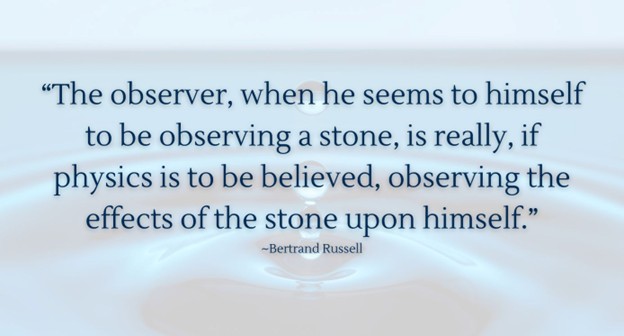
Observing the Impact of New Initiatives
As you progress through the “Evolutionary Leader” program, observing the tangible impact of your new time and energy management initiatives is crucial in validating your efforts and guiding future adjustments. Implementing these strategies should lead to noticeable improvements in productivity and a reduction in stress levels, both of which are vital indicators of successful leadership transformation.
Start by measuring productivity changes. One effective way is to track the completion of tasks against the time allocated, noting any improvements in efficiency. Research indicates that leaders who adopt structured time management systems see a 30% increase in task completion rates, enabling them to focus more on strategic leadership activities. This increase is often accompanied by enhanced goal achievement, as clearly defined priorities align with daily actions.
Simultaneously, monitor stress levels to ensure that the new practices are fostering a healthier work environment. As previously covered in this workshop, incorporating mindful energy management and setting healthy boundaries has been shown to reduce stress by up to 20%, promoting a more balanced work-life dynamic. Employees often report feeling more in control and satisfied with their work when stress is managed effectively, which correlates with a 25% improvement in overall job satisfaction.
Another key indicator is the quality of interactions within your team. With regular check-ins and delegated tasks, leaders can foster a more cohesive and supportive team environment. This approach not only alleviates individual workload pressure but also strengthens team dynamics, leading to a 15% increase in collaborative productivity.
By consistently observing and assessing these metrics, you can fine-tune your strategies to maximize their positive impact. This reflective practice not only enhances your personal leadership journey but also reinforces a culture of continuous improvement within your team. As the benefits of these initiatives become evident, your leadership effectiveness will grow, paving the way for sustained success and resilience in both personal and organizational contexts.
Embracing Failure as a Stepping Stone
In the path to conscious leadership, the ability to embrace failure as a stepping stone rather than a setback is pivotal. Shifting your perspective on failure can transform it from a negative experience into a powerful opportunity for learning and growth. This approach not only fosters resilience but also accelerates personal and organizational development through the concept of “fail forward fast.”
Leaders who adopt a growth mindset, a concept we’ll be exploring deeper in a future workshop, recognize that setbacks are not final; they are simply part of the journey toward success. Studies have shown that organizations that encourage a learning culture and view failure as an opportunity for improvement see a 30% increase in innovation and problem-solving capabilities. This mindset encourages leaders to explore new strategies and solutions without the fear of failure hindering their progress.
The mantra “fail forward fast” serves as a guiding principle in this transformation. It emphasizes the importance of quickly acknowledging and analyzing failures, extracting valuable insights, and applying these lessons to future endeavors. This proactive approach ensures that you’re continuously moving toward your vision of your ideal workplace state of being and environment, as you crafted in Chapter 2. By doing so, leaders remain agile and adaptable, ready to pivot and adjust strategies as needed.
A determination mindset is crucial here. It requires a commitment to not let challenges or setbacks derail your pursuit of accomplishing your goals. Research indicates that leaders who exhibit high levels of determination and resilience are 40% more likely to achieve their long-term objectives. This mindset empowers you to persist through difficulties, maintaining focus on your vision and the path to achieving it.
By integrating this perspective into your leadership practice, you create an environment where failure is not feared but embraced as part of the growth process. This approach not only strengthens your leadership capabilities but also inspires your team to adopt a similar mindset, fostering a culture of continuous improvement and strategic growth. As you lead with determination and embrace failure as an ally, you pave the way for sustainable success, innovation, and resilience within your organization.
The Importance of Regular Review
In the pursuit of conscious leadership, regularly reviewing your achievements and strategies is crucial to sustaining progress and avoiding complacency. Implementing a new plan or strategy should not signal the end of your efforts but rather the beginning of a dynamic process of continuous evaluation and adjustment. Without a structured plan for regular review, there is a significant risk of reverting to ineffective old habits and diminishing the potential benefits of new initiatives.
Complacency can be a silent adversary in leadership. Studies reveal that 70% of organizational change initiatives fail primarily due to a lack of sustained effort and regular review. This highlights the importance of not viewing change as a one-time event but as an ongoing journey that requires consistent attention and effort. By regularly assessing the effectiveness of your strategies, you ensure that the momentum gained from initial implementation is maintained and built upon.
The practice of regular review allows you to identify areas of success as well as aspects that may require refinement. This proactive approach helps in reinforcing positive changes and making necessary adjustments before any regressions occur. Organizations that implement systematic review processes report a 25% increase in strategic goal achievement, as they are better equipped to adapt and respond to evolving challenges.
Moreover, a regular review fosters a culture of accountability and continuous improvement. It encourages leaders to stay aligned with their goals and remain focused on their broader vision of their ideal workplace state of being and environment. By consistently evaluating your progress, you not only reinforce new habits but also cultivate resilience against setbacks, ensuring that your leadership journey remains on course.
Embedding a strategy for regular review into your leadership practice is a vital step toward achieving long-term success. It prevents the stagnation of efforts and supports the continuous evolution of your leadership capabilities, enabling you to lead with confidence and adaptability in an ever-changing organizational landscape.
Realigning Goals and Strategies
In the dynamic landscape of leadership, realigning goals and strategies is a critical step to ensure continued growth and improvement. Building on the insights from regular reviews, this process allows leaders to adapt to changing circumstances and maintain momentum in their pursuit of excellence.
Regular review acts as a compass, guiding when realignment is necessary. It provides clarity on whether current strategies align with organizational objectives and personal aspirations. Research indicates that organizations that frequently realign their goals in response to internal and external changes achieve up to 30% higher performance levels than those that do not. This adaptability is vital in a fast-paced environment where static strategies can quickly become obsolete.
Realigning goals involves reassessing priorities and strategies in light of new information, challenges, or opportunities. This proactive approach not only ensures that efforts remain relevant but also maximizes efficiency and resource allocation. For example, leaders who realign their strategies based on quarterly reviews report a 20% increase in goal attainment, as they are better positioned to navigate emerging trends and shifts in the market.
Moreover, the realignment process fosters innovation and resilience. It encourages teams to think creatively and explore new pathways, fostering a culture of continuous improvement. This adaptability is crucial for sustaining long-term success and can significantly enhance team morale and engagement, as employees feel empowered to contribute to evolving objectives.
By integrating realignment into your leadership practice, you create a responsive and agile environment that thrives on change and innovation. This ongoing process not only strengthens your leadership capabilities but also ensures that your team remains aligned with the broader vision of your ideal workplace environment. As you continuously realign your goals and strategies, you lay the foundation for enduring success and resilience in an ever-changing organizational landscape.

Exercise

Course Manual 11: Navigating Workload Changes
Understanding Workload Changes
In the dynamic landscape of modern work environments, workload changes are inevitable and can take various forms, impacting both professional and personal spheres. Understanding these changes is crucial for leaders aiming to maintain productivity and reduce stress.
Projects: As organizations evolve, projects often undergo changes in scope, timelines, and resource allocations. According to a study by the Project Management Institute, approximately 37% of projects fail to meet their initial goals due to unforeseen changes.
Workplace Seasons: Workloads also fluctuate with organizational cycles, transitioning between busy and slow seasons. Data from a Gallup survey reveals that 44% of employees experience increased stress during peak seasons.
Expanded Responsibilities: Leaders often encounter expanded responsibilities as they advance in their roles, balancing increased work duties with personal obligations. A report from the American Psychological Association highlights that 60% of working adults cite job demands as a significant source of stress.
Understanding workload changes and their implications is essential for effective leadership. By recognizing the nature of these shifts and strategically adapting to them, leaders can enhance resilience, drive innovation, and ensure sustained success for themselves and their teams. This adaptability is a cornerstone of conscious leadership, equipping leaders to navigate complexities with confidence and foresight.
The Importance of Navigating Workload Changes
In today’s fast-paced work environment, the ability to navigate workload changes is indispensable for effective time and energy management. Leaders who master this skill can maintain productivity, reduce stress, and achieve organizational goals even amidst fluctuating demands. Understanding how to adapt to changes ensures that leaders can allocate their resources efficiently, avoiding the pitfalls of burnout and inefficiency.
Research indicates that approximately 70% of employees experience significant stress due to changing work demands, according to a report by the American Institute of Stress. For leaders, this stress can cascade throughout their teams, affecting overall productivity and morale. By developing robust strategies to manage these changes, leaders can foster a resilient team environment that is both adaptive and focused.
Effective time management is critical in managing fluctuating workloads. A study from the National Institute of Mental Health found that individuals who actively manage their time report a 33% lower stress level than those who do not. Leaders equipped with time management skills can prioritize tasks, delegate effectively, and utilize their energy peaks to tackle high-priority activities, ensuring that their teams remain productive and engaged.
Furthermore, adaptability in navigating workload changes supports leaders in achieving strategic organizational goals. By aligning their efforts with the broader objectives of their organization, leaders can drive momentum and innovation, even during times of uncertainty. This alignment is crucial, as it ensures that teams remain motivated and focused on achieving success, regardless of external pressures.

Case Studies
In the ever-evolving landscape of modern workplaces, the ability to effectively manage workload changes is a crucial skill for leaders striving to maintain balance and productivity. This section presents case studies that serve as invaluable resources, offering examples of how leaders across industries have successfully navigated the complexities of workload fluctuations. These narratives not only demonstrate practical strategies but also provide insightful lessons that empower leaders to enhance their adaptability and resilience. By delving into these case studies, leaders can glean actionable insights to apply within their own organizations, fostering environments that thrive amidst change and uncertainty.
Case Study #1: Navigating Personal Workload Changes in Healthcare Leadership
Situation:
In a prominent healthcare organization, a dedicated leader was recently promoted to oversee a larger department. This new role came with expanded responsibilities, including managing an increased number of staff and overseeing multiple ongoing projects. The leader quickly realized that balancing these new duties with their existing commitments was becoming overwhelming, threatening both their professional performance and personal well-being.
Actions Taken:
To effectively manage the expanded workload, the leader implemented several strategic actions:
1. Prioritization and Time Management: The leader began by reassessing their daily tasks, identifying priorities that aligned with both departmental goals and personal strengths. They utilized time-blocking techniques to allocate focused periods for high-priority tasks, ensuring critical responsibilities received the necessary attention.
2. Delegation of Responsibilities: Recognizing the importance of empowering their team, the leader delegated tasks based on individual team members’ expertise and strengths. This not only distributed the workload more evenly but also fostered a sense of ownership and development among staff.
3. Setting Boundaries and Self-Care: To maintain balance, the leader established clear boundaries between work and personal time. They scheduled regular breaks and incorporated mindfulness practices into their routine, such as brief meditation sessions and physical activity, to reduce stress and enhance focus.
4. Continuous Learning and Adaptation: The leader sought mentorship and engaged in professional development opportunities, learning new strategies for managing workload changes and adapting to their expanded role. This ongoing learning process helped them to stay updated with best practices in leadership and management.
Results:
Through these targeted actions, the leader successfully navigated their personal workload changes, resulting in several positive outcomes:
• Enhanced Productivity and Efficiency: The leader’s strategic prioritization and time management led to a marked improvement in task completion rates and overall departmental efficiency, achieving a 30% increase in project delivery timelines.
• Improved Team Dynamics: By delegating effectively and fostering a culture of empowerment, the leader saw enhanced collaboration and morale among team members, with a 25% increase in employee engagement scores.
• Sustained Personal Well-being: The commitment to self-care and boundary setting allowed the leader to maintain a healthy work-life balance, reducing stress levels and improving overall job satisfaction.
• Strengthened Leadership Skills: The leader’s proactive approach to managing workload changes reinforced their leadership capabilities, serving as an inspiring example for peers and setting the stage for future career growth.
This case study illustrates how individual leaders in healthcare can successfully manage personal workload changes through strategic planning, effective delegation, and a focus on personal well-being, ultimately driving both personal and organizational success.
Case Study #2: Navigating a Major Project Scope Change in a Tech Company
Situation:
In a fast-growing tech company, the product development team was tasked with delivering a cutting-edge software solution that would revolutionize user experience. Initially, the project had a clear scope, defined budget, and a timeline that promised a timely launch. However, midway through the development phase, the company’s leadership decided to expand the project scope significantly to include additional features based on emerging market trends and customer feedback. This change posed a considerable challenge to the project leader, who had to navigate increased demands while ensuring the team remained focused and motivated.
Actions Taken:
Recognizing the potential impact on the project timeline and team morale, the leader adopted a strategic approach to manage the expanded workload:
1. Reassessing Priorities: The leader held a series of collaborative meetings with the team to reassess project priorities. By clearly defining the enhanced objectives and aligning them with the company’s strategic goals, the team gained a shared understanding and commitment to the revised project scope.
2. Resource Allocation and Delegation: Understanding the importance of resource management, the leader identified areas where additional support was needed and secured temporary resources from other departments. They also empowered team members by delegating specific responsibilities based on individual strengths, ensuring efficient task distribution.
3. Implementing Agile Methodologies: To maintain flexibility and adaptability, the leader implemented agile methodologies. This approach facilitated regular feedback loops and iterative progress evaluations, allowing the team to adjust quickly to any further changes or challenges.
4. Enhancing Communication and Support: The leader prioritized open communication channels, encouraging team members to voice concerns and suggestions. Regular check-ins and supportive feedback sessions were established to maintain team morale and address stress proactively.
Results:
Through these strategic actions, the leader successfully navigated the project’s expanded scope, achieving several noteworthy outcomes:
• Timely Delivery: The project was completed on schedule, thanks to efficient resource allocation and the agile approach, which allowed for quick pivots and adaptations as needed.
• Improved Team Cohesion and Morale: By involving the team in decision-making and fostering a supportive environment, the leader enhanced team cohesion and morale, leading to a 20% increase in team satisfaction scores in follow-up surveys.
• Innovative Solutions and Market Impact: The project’s additional features, driven by customer insights, resulted in a product that exceeded market expectations, leading to a 15% increase in user engagement within the first quarter post-launch.
• Enhanced Leadership Capabilities: The leader’s ability to manage workload changes not only reinforced their leadership skills but also served as a model for strategic growth and resilience within the company, inspiring future project leaders to adopt similar approaches.
This case study illustrates how strategic flexibility, effective communication, and a proactive approach to resource management can empower leaders to successfully navigate major workload changes, ultimately driving innovation and achieving sustained success.
Strategies for Successfully Navigating Workload Changes
Throughout this ‘Focus Enhancement’ workshop, we’ve delved into essential strategies for improving time and energy management that also form the bedrock of effective leadership when managing workload changes. As you continue your journey in the ‘Evolutionary Leader’ program, it’s crucial to incorporate these foundational strategies as part of your toolkit, ensuring you remain resilient and productive amidst evolving demands.
Prioritization and Time Management
We’ve emphasized the power of prioritization and effective time management as critical skills for efficiency and productivity. However, these skills are also essential for navigating workload changes. By regularly revisiting tools like we explored, such as the Eisenhower Matrix, you can maintain clarity on what tasks demand immediate attention and which can be postponed, helping you to manage your resources effectively.
Strategic Delegation
Delegation remains a cornerstone of workload management, enabling leaders to distribute tasks in alignment with team members’ capabilities. The benefits of empowering your team through delegation have been a consistent theme in our discussions. By leveraging these skills, you can enhance team productivity and cultivate a sense of ownership and growth among your colleagues while simultaneously ensuring efficiency, productivity and wellbeing.
Embracing Flexibility and Adaptability
Flexibility is vital in today’s dynamic work environments. As we’ve explored, adopting agile work practices allows you to swiftly adapt to changes, maintaining momentum even when faced with uncertainty. Embracing these adaptable approaches ensures your team can pivot efficiently, conserving energy and driving innovation.
Enhancing Communication and Feedback Mechanisms
Effective communication has been lightly explored throughout this workshop in terms of delegation and setting healthy boundaries. It is also immensely important in managing workload transitions. We will be diving deeper into this concept in a later workshop.
Regular check-ins and open dialogue foster a collaborative environment where challenges are addressed swiftly, and alignment is maintained. This foundation of transparent communication builds trust and strengthens team dynamics.
Cultivating Resilience and Well-being
The emphasis on resilience and well-being is not just about managing stress but is integral to sustaining long-term performance. By embedding wellness practices into your leadership approach as we’ve been exploring in this workshop, you support not only your personal health but also that of your team, fostering a resilient workplace capable of thriving through changes.
As you navigate the complexities of workload changes, remember to rely on these strategies, tools, and techniques as your go-to resources. Reinforcing these practices will empower you to lead with foresight and confidence, ensuring sustained success and innovation within your organization.
Workload Management Review
In the constantly evolving workplace landscape, regular assessment of workload management strategies is essential to ensure their ongoing effectiveness and alignment with organizational goals. This section explores the importance of continual evaluation, providing leaders with the insights needed to refine their approaches and optimize performance.
The Need for Regular Assessment
Workload management is not a set-and-forget process; it requires continuous scrutiny and adjustment. According to a study by Deloitte, organizations that regularly assess and adapt their workload strategies experience a 30% increase in productivity. This ongoing evaluation helps identify inefficiencies and uncover opportunities for improvement, ensuring that resources are allocated effectively and that leaders and their teams remain focused and engaged.
Benefits of Workload Management Assessment
Enhanced Productivity: By routinely reviewing workload management practices, leaders can identify tasks that may be redundant or inefficient. This proactive approach ensures that team efforts are directed towards high-impact activities that drive organizational success.
Reduced Stress and Improved Well-being: Regular assessment allows leaders to detect signs of burnout and workload imbalance early on. By addressing potential stressors promptly, leaders can create a healthier work environment that promotes well-being and resilience.
Improved Team Dynamics: Assessing workload management strategies fosters open communication and collaboration. Leaders and their teams who engage in regular evaluations are better equipped to adapt to changes and work more cohesively.
Alignment with Organizational Goals: As strategic objectives evolve, workload management strategies must be realigned accordingly. Regular assessments ensure that leader and team efforts are synchronized with the broader organizational vision, enhancing goal achievement and innovation.
Implementing Effective Workload Reviews
To maximize the benefits of workload management assessments, leaders should establish a structured review process. This includes setting clear metrics for evaluation, soliciting feedback from colleagues and team members, and leveraging data analytics to gain comprehensive insights. By incorporating these assessments into their regular schedules, leaders can foster a culture of continuous improvement and adaptability.

Exercise
1. Form Small Groups:
2. Get Comfortable:
3. Share Your Experiences:
4. Identify Strategies:
5. Share Insights:

Course Manual 12: Conscious Leader Launchpad
Embracing the Journey Ahead
Congratulations on successfully completing Workshop 1: Focus Enhancement of the ‘Evolutionary Leader’ corporate training program! This marks a significant milestone in your conscious leadership journey. You’ve taken the first steps toward transforming your leadership style by mastering the foundational skills of time and energy management, essential for thriving in today’s fast-paced work environments as well as optimally participating and learning from this program.
As you embrace the journey ahead, remember that these skills are not just tools but stepping stones toward becoming a conscious leader. Your commitment to this program thus far is a testament to your dedication to personal growth and organizational success. Here’s to your continued journey and the transformative leadership impact you will undoubtedly achieve.
Reflective Insights: Looking Back
As you transition to the next phase of your conscious leadership journey, it’s essential to pause and reflect on the personal growth and development achieved throughout this first workshop. Reflection not only solidifies learning but also enhances future performance. Studies suggest that leaders who engage in reflective practices can boost their self-awareness and decision-making abilities by up to 23%, according to the Center for Creative Leadership.
Reflecting on your journey, consider the individual successes that have marked your path. These accomplishments are not just milestones but building blocks for your evolution as a leader.
Equally important is recognizing and overcoming the challenges you faced. Research from the American Management Association indicates that leaders who learn from challenges are 37% more likely to excel in future leadership roles.
As you look back, celebrate the progress made and the insights gained. This reflection is not just about acknowledging past efforts but about leveraging these experiences to pave the way for continued success. Embrace the lessons learned and carry them forward as you continue to cultivate your conscious leadership skills, ensuring they become integral to your ongoing growth and development.
Integrating New Strategies: Moving Forward with the Program
As you advance in the ‘Evolutionary Leader’ program, it’s vital to build upon the strategies you’ve mastered during this first workshop on ‘Focus Enhancement.’ These foundational skills are not just tools to be used to optimize your participation and learning in this program but are essential components of your ongoing leadership growth and development long-term.
Deepen Time Management Practices:
Continue refining your time management skills by revisiting your daily schedule. Prioritize tasks that align with your goals for this corporate training program and allocate specific time slots for learning and reflection.
Elevate Energy Management Techniques:
Extend your use of the Energy Boosters toolkit by integrating these practices into your routine considering this corporate training program’s activities. Schedule regular energy checks to adjust your focus and maintain peak performance.
Reinforce Boundary Setting:
As the program progresses, it’s crucial to maintain healthy boundaries to protect your learning time and wellbeing. Communicate these boundaries clearly to your team and stakeholders, ensuring your program participation remains a priority.
Enhance Reflective Practices:
Incorporate regular reflection sessions into your weekly schedule to assess your progress and adapt strategies as necessary. This practice not only consolidates learning but also improves self-awareness.
Utilize Peer Support Networks:
Engage with fellow participants to exchange insights and strategies. Peer support can reinforce your learning and provide different perspectives, enhancing your understanding of the program material.
By re-emphasizing and extending these core strategies, you’ll be well-prepared to fully engage with the ‘Evolutionary Leader’ program. These practices will not only optimize your participation but also contribute to your development as a conscious leader, ready to inspire and lead change within your organization. Embrace this journey with dedication and foresight, ensuring your growth is both profound and sustainable.
Setting Your Program Intention: Planning for Success
Embarking on the ‘Evolutionary Leader’ program is not just about acquiring new skills; it’s an opportunity to set transformative intentions that guide your journey toward becoming a conscious leader. As you progress, it’s essential to establish clear intentions for what you aim to achieve by the end of this program.
Setting intentions acts as a powerful motivator, providing direction and purpose. Research from the Journal of Business Psychology highlights that individuals who set specific intentions are 90% more likely to achieve their goals. This is because intentions create a mental blueprint that aligns daily actions with long-term aspirations.
Define Your Vision:
Visualize what success in this program looks like for you. Whether it’s mastering a new leadership skill or fostering a more innovative team environment, clearly articulate your goals. This clarity will serve as your compass, ensuring you remain focused and motivated.
Break Down Your Goals:
Once your overarching vision is clear, divide it into manageable milestones. Setting smaller, achievable targets can enhance motivation by 22%, as it provides a sense of progress and accomplishment along the way.
Regularly Revisit and Reflect:
Integrate a routine of revisiting your intentions as you move further along in this program to assess your progress. Reflection not only keeps you aligned with your goals but also allows for adjustments based on new insights gained during the program.
Visualize Success Daily:
Engage in daily visualization practices to reinforce your intentions. Imagining your success activates the same neural networks used during actual performance, increasing your likelihood of achieving your goals by 11-25%.
Share Your Intentions:
Communicate your intentions with peers and mentors within the program. Sharing goals can solidify your commitment and open opportunities for support and collaboration, enhancing your personal and professional development.
By setting clear program intentions, you are not only paving the way for success but also fostering a mindset of continuous growth and focus. These intentions will act as a guiding light, helping you navigate the challenges of leadership and ensuring that your journey through the ‘Evolutionary Leader’ program is both transformative and rewarding.
Conclusion: Launching into Leadership
As you stand at the threshold of your conscious leadership journey, reflect on the transformative skills and insights you’ve gained in this initial phase of the ‘Evolutionary Leader’ program. The foundation you’ve laid through mastering time and energy management, setting boundaries, and cultivating reflective practices is instrumental not only for your development but for the evolution of your team and organization.
The journey you have embarked on is supported by compelling evidence: leaders who effectively manage their time and energy report up to a 30% increase in productivity and a 23% boost in decision-making abilities. These statistics underscore the profound impact that these foundational skills can have on your leadership effectiveness.
As you progress to the next stages of this program, embrace the opportunity to apply these insights with confidence. Your commitment to personal growth and organizational excellence is a testament to your potential as a transformative leader.
In your pursuit of excellence, remember that leadership is a continuous journey of learning and adaptation. The path may present challenges, but with the strategies you’ve learned in this workshop and will continue to learn in this program, you will soon be fully equipped to navigate them with agility and foresight.
Now, as you prepare to launch into the next phases of the ‘Evolutionary Leader’ program, do so with enthusiasm and conviction. Embrace this opportunity to lead with intention and inspire others through your commitment to conscious leadership.
Here’s to your continued success and the impactful leadership you are poised to deliver.

Exercise
1. Form Small Groups:
2. Create a Welcoming Environment:
3. Reflect on Workshop Experiences:
o Share a key takeaway from the first workshop that has had a significant impact on you.
o Discuss how this takeaway has influenced your approach to leadership or personal development.
o Listen to others and consider how their insights might further enhance your own journey.
4. Look Forward with Enthusiasm:
o Articulate what you are most excited about as you continue in the program.
o Share any specific goals or skills you wish to develop in the upcoming sessions.
o Discuss how the skills gained so far will support your future aspirations.
5. Summarize and Encourage:
o Conclude by summarizing the key themes discussed.
o Encourage each participant to state one commitment they will make to their development as they move forward in the program.
Project Studies
Chapter 1: Assessing Focus and Efficiency
You are now invited to engage in three transformative exercises designed to enhance your awareness of your current time and energy management practices.
Action item #1, the Time Audit Exercise, encourages you to evaluate your daily schedule using our Time Audit template or your own method of journaling. We recommend that you do this audit for at least a week’s time.
Action item #2, the Distraction Analysis Exercise, focuses on identifying distractions and sources of overwhelm in your environment. We recommend that you do this analysis for at least a week’s time.
Action item #3, the Energy Peaks Identification Exercise, helps you recognize patterns in your energy levels throughout the day. We recommend that you do this evaluation for at least a week’s time.
**To avoid becoming overwhelmed with these activities, it is highly recommended to start with the first exercise, settle into it for 2-3 days, then add the second exercise, settle into doing both for 2-3 days and then add the 3rd exercise. **
We encourage you to approach these exercises with a mindset of curiosity, fostering an environment of awareness and consciousness, rather than from a place of judgment or comparison.
This awareness and consciousness will begin to lay the groundwork for your conscious leadership growth and development.
Project Study Exercise 1.1: Time Audit
Evaluate your current time management practices by keeping track of your typical daily schedule of tasks and activities for the next week via our Time Audit template sheet below or via your own form of note taking or journaling.
Access the Exercise 1.1 Time Audit Template: Exercise 1.1 Time Audit Template
Project Study Exercise 1.2: Distraction Analysis
Identify any distractions, interruptions and sources of overwhelm in your schedule and environment for a week via our Distraction Analysis template sheet below or via your own form of note taking or journaling.
Access the Exercise 1.2 Distraction Analysis Template: Exercise 1.2 Distraction Analysis Template
Project Study Exercise 1.3: Energy Peaks Identification
Track your energy levels throughout the day for a week, in order to identify your peak performance times via our Energy Peaks Identification template sheet below or via your own form of note taking or journaling.
Access the Exercise 1.3 Energy Peaks Identification Template: Exercise 1.3 Energy Peaks Identification Template

Chapter 2: Designing Focus and Balance
In this section, we invite you to embark on a transformative journey toward defining your ideal state and environment. As you review and reflect on your assessments from the previous chapter, take this opportunity to gain insights into your current practices and envision the optimal conditions that support your highest potential.
By brainstorming what your ideal daily work environment and state of being would look like, you’ll lay the groundwork for enhanced time and energy management. These exercises are crafted to inspire you to elevate your focus and productivity, setting the stage for a more engaged and impactful experience in the ‘Evolutionary Leader’ program.
Embrace this chance to design a workspace and routine that fuels your creativity and well-being, empowering you to lead with clarity and purpose.
Project Study Exercise 2.1: Review & Reflect
In this first exercise, take a moment to review and reflect in your journal, notebook or on some sheets of paper on the insights you’ve gathered from the previous chapter’s assessments. Recall your observations from your Time Audit, where you meticulously tracked your daily schedule to understand your time management habits. Also, revisit your Distraction Analysis, where you identified interruptions and sources of overwhelm that impact your focus. Lastly, consider the revelations from your Energy Peaks Identification exercise, which spotlighted your peak performance times.
These reflections are pivotal in understanding your current practices and will serve as a foundation for defining your ideal state and environment. By acknowledging these patterns, you are better equipped to cultivate an environment that enhances focus and productivity, empowering you to thrive as a conscious leader.
Project Study Exercise 2.2: Dream Boldly
In this second exercise, we invite you to take a moment to dream boldly and design your ideal work environment and state of being for each day. This exercise is not merely a creative endeavor; it is a strategic step in enhancing your time and energy management. By envisioning the conditions under which you thrive, you set the groundwork for a routine that supports your highest potential. Imagine the atmosphere, tools, and interactions that empower you to be at your best. This clarity will not only deepen your engagement with the ‘Evolutionary Leader’ program but also transform your daily experience, enabling you to lead with renewed focus and vitality. Embrace this opportunity to craft a professional landscape that aligns with your aspirations and supports your journey toward conscious leadership.
Before getting started, take a moment to center and focus yourself. Remove any distractions such as turning off the television, silencing your cellphone, and shutting your laptop. Add elements that will help you brainstorm and visualize from a place of peace, calm, and positivity, like relaxing music, candles, or aromatherapy. This preparation sets the stage for a productive and immersive session.
Close your eyes and take a few deep, cleansing breaths. As you inhale, invite a sense of calm and clarity into your mind. As you exhale, release any tension you may be holding in your body. Focus on your intention of brainstorming, envisioning, and designing your ideal state of being at work and your ideal work environment. Allow yourself to embrace this time fully, creating space for creativity and insight.
Take your time; there is no need to rush. Be as detailed as possible, the brain loves detail. Think about colors and textures; consider how things feel to the touch and the ambience they create. Engage all your senses to craft a vivid picture of your ideal state and space.
In your notebook or journal, utilize the following prompts to define and design your ideal working state of being and environment where you feel calm, in control, and at your optimal effectiveness and productivity. Allow yourself to explore your emotions and aspirations and remain open-minded to new ideas that may arise. This is your opportunity to dream big, creating a vision that not only inspires you but also lays a foundation for thriving in your professional life.
1. Craft Your Professional Landscape
Begin by imagining your perfect work environment. Picture where you thrive best: Is it bustling or serene workspace? Consider the design, lighting, and tools that enhance your focus and creativity.
o Steps to Visualize:
– Identify elements that boost your productivity, such as ergonomic furniture or a clutter-free desk.
– Think about the atmosphere: Do you prefer background music or complete silence?
– Visualize how these elements contribute to a seamless workflow.
2. Outline Your Ideal Workday
Detail your perfect work routine. What activities invigorate you, and how do you want to structure your day to maximize your energy?
o Steps to Visualize:
– Picture your day from start to finish: When do you have your most productive meetings?
– Define breaks and leisure activities that recharge you.
– Consider digital tools you use to streamline tasks.
3. Establish Meaningful Connections
Reflect on the relationships that empower you professionally. Who do you collaborate with? What kind of team dynamics invigorate you?
o Steps to Visualize:
– Identify key mentors and colleagues who motivate you, who support you.
– Envision regular interactions that foster innovation, support and positivity.
– Think about communication styles that enhance teamwork.
4. Prioritize Personal Well-being
Envision how you balance work and life. How do you nurture your mental and physical health? What hobbies keep you energized?
o Steps to Visualize:
– Picture your ideal work-life integration: How do you spend your mornings before work? Your evenings after work? Your weekends?
– Identify activities that reduce stress and promote relaxation.
– Visualize how you maintain energy levels throughout the week.
5. Pay attention to how your visualization makes you feel: Is it exciting, inspiring, and motivating? Or is it overwhelming, stressful, or unrealistic?
Adjust your vision as needed and keep going until you have a crystal-clear picture of what success looks like for you.
By meticulously defining your ideal state of being and your ideal work environment, you’ll create the ultimate conditions for thriving both in the ‘Evolutionary Leader’ program and in your professional journey. This clarity will not only enhance your time and energy management but also empower you to lead with confidence and purpose.

Chapter 3: Creating Leader Role Clarity
In this section for Chapter 3: Creating Leader Role Clarity, these exercises are crucial for fostering a profound understanding of your role, ultimately enhancing clarity and effectiveness in your leadership approach. Exercise 3.1 guides you to determine and clarify your role objectives by examining your job description and engaging in meaningful conversations with your manager or director. This foundational step empowers you to align your responsibilities with the strategic goals of your organization. Building on this, Exercise 3.2 leverages the ‘Hats of Leadership’ Framework to deepen your comprehension of your leadership role. By mapping your responsibilities and aligning personal development with organizational objectives, you will cultivate a more nuanced understanding of your goals and expectations. Through these exercises, you will reduce stress, improve decision-making, and pave the way for a thriving organizational culture.
Project Study Exercise 3.1: Determining, Clarifying, and Understanding Your Role Objectives
In this exercise, you will focus on gaining a clear understanding of your leadership role’s key objectives. This clarity is essential for enhancing your effectiveness and reducing the stress that comes with ambiguity.
Step 1: Review Your Job Description
1. Obtain a Copy of Your Job Description: Begin by reviewing the document that outlines your role’s responsibilities. Pay attention to the specific tasks and expectations detailed within.
2. Identify Key Objectives: Highlight the primary objectives and responsibilities mentioned. Note any areas where expectations are unclear or could use further clarification.
Step 2: Engage in a Conversation with Your Manager or Director
1. Schedule a Meeting: Arrange a meeting with your manager or director to discuss your role in depth.
2. Prepare Questions: Develop a list of questions aimed at clarifying your responsibilities and expectations. Consider asking about:
o The strategic goals of your department and how your role supports them.
o Specific outcomes or deliverables you are expected to achieve.
o Any areas where your role may evolve or expand in the future.
3. Seek Feedback: During the meeting, seek feedback on your current performance and areas for development. Ask for guidance on prioritizing your tasks and aligning them with organizational goals.
Step 3: Document Your Insights
In your journal, notebook or on some sheets of paper…
4. Record Key Points: After your discussion, document the key insights and clarifications you gained. Create a list of updated objectives and responsibilities based on your conversation.
5. Reflect on the Discussion: Consider how this new clarity impacts your daily work and long-term goals. Reflect on how understanding your objectives can enhance your decision-making and reduce stress.
Project Study Exercise 3.2: Deepening Role Understanding Using the ‘Hats of Leadership’ Framework
In this exercise, you will leverage the ‘Hats of Leadership’ Framework to deepen your understanding of the key objectives, goals, and expectations of your leadership role using a notebook, your journal or the framework template below. This exercise will guide you in aligning your personal growth with organizational objectives, enhancing your leadership effectiveness.
Step 1: Map Your Role with the ‘Hats of Leadership’ Framework
1. Review Your Current Objectives: Start by reflecting on the objectives and insights gained from the previous exercise, Exercise 3.1.
2. Identify Framework Buckets: Categorize your responsibilities into the three framework buckets: “Behind the Scenes,” “In the Spotlight,” and “In the Director’s Chair.”
o Behind the Scenes: Operational and logistical tasks.
o In the Spotlight: Interpersonal and motivational roles.
o In the Director’s Chair: Strategic vision and planning.
Step 2: Analyze Each Bucket
1. For each bucket, determine the following:
o Skills and Abilities:
– Determine what skills and abilities are needed to effectively perform the tasks and responsibilities you listed for your role
– Further categorize each skill or ability as a hard skill or ability or a soft skill or ability
o Mind Engagement:
– Determine primarily what part of the brain is primarily engaged – the Conscious or Subconscious mind – for each bucket
o Challenges and Obstacles:
– Brainstorm what possible challenges and obstacles you can already see exist and anticipate may arise in the future
Step 3: Personal Growth and Development Plan
1. Identify Development Areas: Based on your analysis, list key areas where you need development to meet your role’s objectives efficiently.
2. Align with Organizational Goals: Ensure your personal development plans align with the strategic goals of your organization, enhancing both personal and organizational success.
Step 4: Reflect and Document
1. Reflect on Insights: Write down the insights gained from mapping your role using the framework. Consider how this deeper understanding influences your daily leadership practices especially your time and energy management.
Also, consider how this deeper understanding influences your participation in this ‘Evolutionary Leader’ program.
2. Maintain an Ongoing Journal: Keep a reflective journal or notebook to document new insights, reflections, challenges, and changes in your role. Regularly update it to track your growth and adjust your strategies as needed.
By completing this exercise, you will enhance your role clarity, leading to more informed decision-making and a reduction in workplace stress. This proactive approach will empower you to lead with confidence and contribute to a thriving, efficient organizational culture.
Access the Exercise 3.2 Hats of Leadership Template: Exercise 3.2 Hats of Leadership Template

Chapter 4: Focused Clarity
In these exercises, we will translate the principles of setting clear goals and priorities into actionable steps. This section is designed to guide you through a series of exercises that will help you craft a list of strategic goals and priorities, ensuring that your daily activities align seamlessly with your long-term vision. By engaging in exercises including Goal Alignment Reflection and Task Prioritization Evaluation, you’ll learn to rank tasks by their importance and urgency, identify opportunities for delegation, and create a streamlined workflow that minimizes stress and enhances performance. These exercises are not just about organizing tasks, they’re about empowering you to lead with clarity and purpose, transforming your leadership journey into one marked by significant personal and organizational achievements.
Project Study Exercise 4.1: Crafting Clear Goals
This exercise is designed to help you transform the insights you’ve gained from all the previous exercises you’ve done so far in this workshop.
• Take the information and your insights from your Time Audit, Distraction Analysis and Energy Peaks Identification assessments.
• Take the information and your insights from your review and reflection of those evaluations.
• Take the information and your insights from your brainstorm of designing your ideal work environment and daily state of being.
• And take the information and your insights from your role clarity determination.
And transform them into a structured list of your clear goals.
Step 1: Identify Strategic Goals
• Reflect and Review: Begin by revisiting the information and insights gained from your previous exercises. In your journal, notebook or on a sheet of paper, answer this question: What are the key strategic objectives that stand out for you?
• Define SMART Goals: Now, turn these insights into specific, measurable, attainable, relevant, and time-bound (SMART) goals.
o Be sure each goal is specific and detailed; you don’t want general or vague goals.
o Be sure to include why you must achieve each goal as well.
Access the Exercise 4.1 Crafting Clear Goals Template: Exercise 4.1 Crafting Clear Goals Template
Project Study Exercise 4.2: Goal Alignment Reflection
Building on the previous exercise, this exercise focuses on Goal Alignment Reflection, where you will evaluate how your newly crafted goals fit into your daily activities. By the end of this exercise, you will have fine-tuned your approach to ensure that your efforts are fully aligned with your strategic objectives, thus enhancing motivation and reducing burnout.
Step 1: Review Daily Tasks
• Daily Task Analysis: Begin by reviewing your current daily tasks. List them comprehensively, considering both professional and personal activities.
• Alignment Check: Compare these tasks with the strategic goals you crafted in Exercise 4.1. Identify which tasks directly contribute to your SMART goals.
Step 2: Identify Misalignments
• Spot Misalignments: Highlight tasks that do not align with your strategic objectives. Consider their necessity and impact on your overall goals.
• Analyze Impacts: Reflect on how these misaligned tasks affect your productivity and stress levels. Are they necessary, or can they be modified or eliminated?
Step 3: Make Adjustments for Alignment
• Modify or Remove: Strategically modify tasks that can be altered to fit your goals or remove those that offer little value.
Step 4: Embrace Alignment Benefits
• Boost Motivation: Recognize how aligning tasks with your goals enhances motivation by providing a clear sense of direction and achievement.
• Reduce Burnout: Appreciate how focusing on aligned tasks can reduce stress and prevent burnout, allowing for sustained energy and enthusiasm.
Access the Exercise 4.2 Goal Alignment Reflection Template: Exercise 4.2 Goal Alignment Reflection Template
Project Study Exercise 4.3: Task Prioritization Evaluation
This exercise is designed to help you evaluate and prioritize your tasks to ensure they align with both your personal and professional goals.
Step 1: Comprehensive Task Listing
• Task Inventory: Utilize your list of all of your current tasks – both professional and personal – that you created in the previous exercise, Exercise 4.2.
• Categorize Tasks: Group tasks based on their nature (e.g., project work, administrative duties, personal errands).
Step 2: Rank Tasks Using the Eisenhower Box
• Quadrant Categorization: Use the Eisenhower Box template provided to sort your tasks into four categories:
o Urgent and Important: Tasks that demand immediate attention and contribute significantly to your goals.
o Important but Not Urgent: Tasks crucial for long-term success that require planning and scheduling.
o Urgent but Not Important: Tasks that can be delegated to others to free up your time.
o Not Urgent and Not Important: Tasks that can be postponed or eliminated to streamline your workload.
Step 3: Evaluate and Adjust Task Priorities
• Reassess Task Importance: Review your categorized tasks and ensure they are aligned with your strategic goals. Adjust the priority of tasks that may need re-evaluation.
• Focus on High-Impact Activities: Concentrate on tasks in the ‘Urgent and Important’ and ‘Important but Not Urgent’ quadrants, as these will drive the most significant progress towards your objectives.
Step 4: Delegation and Elimination
• Delegation Opportunities: Identify tasks in the ‘Urgent but Not Important’ quadrant that may be suitable to delegate to others. We’ll explore in a later chapter how to Delegate Tasks effectively.
• Eliminate Inefficiencies: Consider removing or postponing tasks in the ‘Not Urgent and Not Important’ quadrant to reduce unnecessary workload.
Step 5: Embrace the Benefits of Task Prioritization
• Stress Reduction: Appreciate how prioritizing tasks can significantly lower stress by providing clarity and focus on essential activities.
• Productivity Enhancement: Recognize the improved productivity that comes from dedicating time and resources to high-impact tasks, allowing for greater achievements in your leadership role.
By completing these exercises, you have begun developing a strategic approach to task management that not only aligns with your goals but also fosters an environment of efficiency and reduced stress. This clarity will empower you to lead with greater effectiveness and inspire your team towards collective success.
Access the Exercise 4.3 Task Prioritization Evaluation Template: Exercise 4.3 Task Prioritization Evaluation Template

Chapter 5: Time Mastery Blueprint
This section is dedicated to refining your time management skills through a series of practical exercises designed to enhance your productivity, focus, and overall well-being. Building on the insights you’ve gained from previous chapters, these exercises will guide you in strategically allocating time slots, leveraging technology effectively, and incorporating vital rest and recharge strategies into your routine.
Each exercise serves as a step in your conscious leadership journey, providing you with tools and techniques to manage your time with greater precision and intention. By focusing on strategic time slot allocation, you will learn to align your tasks with peak energy times, ensuring you tackle high-priority activities when you are most alert. The technology utilization analysis will encourage you to explore digital tools that can streamline your workflow and increase efficiency. Finally, the rest and recharge strategy evaluation will help you integrate breaks and buffer times that are crucial for sustaining energy and preventing burnout.
We encourage you to engage fully with each exercise, as doing so will maximize your learning and development. These exercises are not just tasks to complete but opportunities to transform your approach to leadership, empowering you to lead with clarity and resilience. Embrace the chance to cultivate a more conscious and effective time management plan that supports both your personal growth in this ‘Evolutionary Leader’ training program and beyond as well as your leadership effectiveness.
Project Study Exercise 5.1: Strategic Time Slot Allocation
In this exercise, you’ll refine your ability to allocate specific time slots for tasks based on their priority and your personal energy peaks, utilizing various time allocation techniques covered in this chapter. This practice is essential for enhancing your productivity and focus as a conscious leader.
Objective:
To develop a personalized daily schedule that aligns your highest-priority tasks with your peak energy times, experimenting with different time allocation techniques to maximize productivity.
Instructions:
1. Review Your Insights:
o Reflect on your Time Audit and Distraction Analysis evaluations from chapter 1 which you used to identify recurring tasks and common interruptions.
o Revisit your Energy Peaks Identification evaluation which you used to determine when you’re most alert and productive throughout the day.
o Refer to your Task Prioritization Evaluation which you used to identify critical tasks needing focused attention.
2. Identify Priority Tasks:
o List your top priority tasks aligned with your strategic goals. Use the insights you gained from the Chapter 4 Exercises to ensure these tasks are both urgent and important.
3. Align Tasks with Energy Peaks:
o Match your high-priority tasks with your peak performance times. This alignment helps you tackle demanding tasks when your energy level is at its highest.
4. Explore Time Allocation Techniques:
o Pomodoro Technique: Work in short, focused sessions (25 minutes), followed by a 5-minute break. This enhances concentration and prevents burnout.
o Task Batching: Group similar tasks together to complete them within a single time block, reducing task-switching and increasing efficiency.
o Day Theming: Allocate entire days to specific types of work or themes (e.g., Mondays for meetings, Wednesdays for project work) for streamlined focus.
o Time Blocking: Schedule every part of your day, including work tasks, breaks, and personal activities, to create a structured routine.
o 2-Minute Rule: If a task takes less than two minutes, do it immediately to prevent small tasks from accumulating.
5. Allocate Time Slots:
o Designate specific time slots in your daily schedule (using an App on your mobile phone, in your planner, etc) for each priority task using one or more of the techniques above. Ensure these slots are during your identified energy peaks.
o Also, include buffer times for unexpected disruptions or smooth transitions between tasks.
6. Experiment and Reflect:
o Try different time allocation techniques to find the most effective approach for your productivity. Consider combining techniques for greater efficiency.
• Keep in mind that you may find that different Time Allocation Techniques may work best for different circumstances or seasons. For example, you may find that Task Batching works best for you on a regular daily basis but for projects or busy seasons, you may find that Time Blocking is more efficient for these periods.
o At the end of your day, reflect on the effectiveness of your time slot allocations and techniques used. Adjust your schedule as needed, ensuring it remains flexible and aligned with your priorities and energy levels.
Outcome:
By completing this exercise, you’ll develop a dynamic and responsive time management plan that enhances your ability to focus on critical tasks during optimal times. Experimenting with various techniques will help you discover the best approach for your personal productivity, supporting your growth as a conscious leader.
Access the Exercise 5.1 Strategic Time Slot Allocation Template: Exercise 5.1 Strategic Time Slot Allocation Template
Project Study Exercise 5.2: Technology Utilization Analysis
In this exercise, you’ll explore how technology can enhance your time management skills by analyzing your current usage and identifying new tools or methods to improve efficiency, being sure to draw on your insights from the previous exercises in this workshop thus far.
Objective:
To evaluate and optimize your use of technology for effective time management, enhancing your productivity and focus as a conscious leader.
Instructions:
1. Review Your Insights:
o Reflect on your Time Audit assessment from chapter 1 to identify how much time you currently spend using technology for various tasks.
o Consider your Distraction Analysis assessment, also from chapter 1, to determine how technology might be contributing to interruptions or inefficiencies in your routine.
o Revisit your Energy Peaks Identification assessment from chapter 1 to see if technology could help optimize your workflow during peak performance times.
2. Current Technology Usage:
o List the digital tools and platforms you currently use for managing tasks, scheduling, communication, and any other work-related activities.
o Evaluate the effectiveness of these tools in supporting your time management goals. Are they helping streamline your tasks, or do they contribute to distractions?
3. Identify Technology Gaps:
o Determine any gaps where technology could better support your time management. For instance, could a scheduling app help you organize your day more efficiently, or might a project management tool enhance team collaboration?
o Consider whether there are tools you could use more effectively or new technologies to explore that align with your strategic goals.
4. Explore New Tools and Methods:
o Research technology solutions that address your identified gaps. Consider options like scheduling apps, project management platforms, communication tools, or time tracking software. You may want to refer back to the specific apps mentioned earlier in this chapter.
o Assess how these tools could integrate into your daily routine and potentially enhance your productivity.
5. Strategic Implementation:
o Select one or two new tools or methods to implement. Begin with a trial period to evaluate their effectiveness in enhancing your time management.
o Incorporate these tools into your routine during your identified energy peaks to leverage their full potential.
6. Reflect and Adjust:
o After trying the new tools, reflect on their impact on your productivity and focus. Are they helping you achieve your time management goals?
o Adjust your technology use as needed, ensuring it aligns with your evolving priorities and enhances your leadership effectiveness.
Outcome:
By completing this exercise, you’ll gain a clearer understanding of how technology can support your time management plan. You’ll identify opportunities to optimize your use of digital tools, promoting greater efficiency and productivity in your leadership journey.
Access the Exercise 5.2 Technology Utilization Analysis Template: Exercise 5.2 Technology Utilization Analysis Template
Project Study Exercise 5.3: Rest and Recharge Strategy Evaluation
In this exercise, you’ll evaluate and optimize your rest and recharge strategies, incorporating breaks and buffer times to enhance cognitive function and prevent burnout. This approach will help sustain your energy and focus as a conscious leader.
Objective:
To develop and integrate an effective rest and recharge strategy into your daily routine, promoting productivity and overall well-being.
Instructions:
1. Review Your Insights:
o Reflect on your Time Audit assessment once again from chapter 1 to understand how you currently allocate time for rest and recovery.
o Consider again your Distraction Analysis assessment from chapter 1 to identify if lack of breaks contributes to distractions or inefficiencies in your workflow.
o Revisit your Energy Peaks Identification assessment once again from chapter 1 to determine when you might need breaks to sustain your energy levels.
2. Current Rest and Recharge Practices:
o List the strategies you currently use for taking breaks, managing stress, and ensuring adequate sleep.
o Evaluate the effectiveness of these practices in supporting your cognitive function and preventing burnout. Are you taking breaks when needed?
3. Identify Areas for Improvement:
o Recognize gaps where rest and recharge strategies could be enhanced. For instance, are you scheduling regular breaks, or is your sleep routine consistent?
o Consider if there are additional activities or changes to your routine that could support better rest and recovery.
4. Integrate Rest and Recharge Strategies:
o Plan and schedule regular breaks into your daily routine, aligning them with your energy peaks to boost productivity.
o Incorporate buffer times between tasks to allow for mental recovery and preparation for upcoming activities.
o Establish a consistent sleep routine and include relaxation activities, such as mindfulness practices or physical exercise, to enhance restfulness.
5. Reflect and Adjust:
o At the end of your day, reflect on the effectiveness of your rest and recharge strategies. Did you notice improvements in your energy and focus?
o Adjust your strategies as needed, ensuring they remain supportive of your well-being and adapt to your evolving needs.
Outcome:
By completing this exercise, you’ll create a balanced routine that integrates effective rest and recharge strategies, enhancing your cognitive function and sustaining your energy. This approach will empower you to lead with greater clarity and resilience, supporting your journey as a conscious leader.
Access the Exercise 5.3 Rest and Recharge Strategy Evaluation Template:Exercise 5.3 Rest and Recharge Strategy Evaluation Template

Chapter 6: Mindful Energy Management
This section is designed to be a pivotal component in your journey toward mastering energy management and enhancing your leadership effectiveness. Through a series of engaging exercises, you will dive into self-reflection, experimentation, and lifestyle changes, all aimed at building sustainable energy habits that support both your personal and professional growth.
These exercises will guide you in understanding your natural disposition towards daily activities, exploring energy-boosting techniques, and making impactful lifestyle changes. By examining how you navigate the demands of leadership and life, you’ll gain valuable insights and develop personalized strategies to maintain high energy levels.
We encourage you to engage fully with each exercise, as they offer opportunities for introspection and innovation in your energy management practices. Embrace the process of experimentation and be open to adapting new habits that resonate with your unique needs and aspirations. As you immerse yourself in this section, you are setting the stage for a transformative journey that not only enhances your leadership capacity but also enriches your overall well-being.
Project Study Exercise 6.1: Determining Your Disposition
In this exercise, you’ll embark on a self-reflective journey to understand your natural disposition towards daily activities—whether you tend to overdo or underdo them. This understanding is crucial for tailoring effective energy management practices that align with your inherent tendencies. By identifying your disposition, you can create a balanced approach that enhances your leadership effectiveness and personal well-being.
Step 1: Pause and Reflect
• Set the Scene: Find a quiet, comfortable space where you won’t be disturbed. Bring along a journal or a digital device for note-taking.
• Center Yourself: Take a few deep breaths to clear your mind and bring focus to the task at hand.
Step 2: Self-Assessment
• Honest Evaluation: Reflect on your typical daily habits. Do you often find yourself pushing to the limit, working long hours without breaks, or are you more prone to procrastination and lack of motivation?
• Journaling Prompt: Write about your daily routine. Include times when you feel most productive or most drained. You may find your previous assessment of your Energy Peaks Identification helpful. Consider factors that may contribute to overexertion or underperformance.
Step 3: Identify Your Disposition
• Overdoer Traits: If you tend to maximize every moment, often feeling burnt out by week’s end, you might be an overdoer.
• Underdoer Traits: If motivation is a struggle and tasks often pile up or remain unfinished, you may lean towards underdoing.
• Mixed Traits: Some might find they fluctuate between the two depending on circumstances or stress levels.
Step 4: Tailor Your Energy Management Practices
• For Overdoers, consider:
o Incorporating Relaxation: Integrate relaxation techniques such as meditation, yoga, or scheduled breaks to recharge.
o Setting Boundaries: Practice saying no and prioritize your tasks to avoid overwhelm. We’ll be covering this topic deeper in the next chapter.
• For Underdoers, consider:
o Boosting Activity: Engage in regular physical exercise and set small, achievable goals to build momentum.
o Creating Routines: Establish structured routines to foster discipline and consistency.
Step 5: Reflect and Adjust
• Weekly Reflection: At the end of each week, evaluate the effectiveness of your practices. Are they helping you achieve a better balance?
• Adjust as Needed: Be open to tweaking your approach based on what you learn about yourself and your energy needs.
By completing Exercise 6.1, you’ll gain valuable insights into your personal disposition and learn to craft energy management practices that enhance your leadership potential. Embrace this self-awareness as a powerful tool for personal and professional growth.
Access the Exercise 6.1 Determining Your Disposition Template: Exercise 6.1 Determining Your Disposition Template
Project Study Exercise 6.2: Energy Booster Challenge
In this exercise, you’ll embark on a seven-day Energy Booster Challenge designed to help you explore the various techniques we went over in this chapter for maintaining high energy levels throughout your day. This challenge encourages you to experiment with the different techniques, track your results, and reflect on their effectiveness, ultimately building a personalized toolkit of strategies to keep you energized and focused.
Step 1: Set Your Challenge Week
• Choose Your Start Date: Decide when you will begin your seven-day challenge. Ensure you use our template below or alternatively have a journal or digital device ready for tracking your experiences.
Step 2: Select Your Daily Energy Booster
• Daily Selection: Each day, choose one energy-boosting technique to try when you notice your energy dipping, that we covered in this chapter, they are also listed below:
o Mental Shadowboxing: Write empowering statements to overcome mental barriers.
o Verbal Mantras: Speak affirmations aloud to shift your mindset.
o Physical State Change: Engage in quick physical activities to boost energy.
o Meditation and Relaxation: Dedicate time to calm your mind and rejuvenate.
o Mental Stimulation: Engage with content that inspires and challenges you.
Step 3: Track Your Results
• Daily Reflection: After using each booster, take a few minutes to record your observations:
o Effectiveness: Did the booster help improve your energy level?
o Mood Impact: How did it affect your mood and focus?
o Adaptation: Did you need to adapt the technique to fit your environment?
Step 4: Reflect on Your Experience
• End-of-Week Review: At the conclusion of your seven-day challenge, reflect on the effectiveness of each energy booster:
o Identify Favorites: Which techniques resonated with you the most?
o Challenges Faced: Were there any difficulties in implementing certain boosters?
o Personal Insights: What did you learn about your energy patterns and needs?
Step 5: Develop Your Personalized Toolkit
• Create Your Toolkit: Based on your reflections, compile a list of your top energy-boosting techniques. Consider how you can incorporate them into your daily routine as part of your mindful energy management practices moving forward.
• Embrace Variety: Remember that flexibility is key—feel free to switch up your strategies to keep your energy levels high.
Step 6: Commit to Continuous Improvement
• Ongoing Commitment: Make a commitment to regularly revisit your toolkit, adding new techniques as you discover them. Consider this challenge the start of a dynamic practice that evolves with your needs.
Through Exercise 6.2, you’ll gain valuable insights into how different activities affect your energy and performance. By building a personalized toolkit, you’ll be equipped to tackle daily challenges with renewed vigor and maintain a consistent flow of energy throughout your leadership journey.
Access the Exercise 6.2 Energy Booster Challenge Template:Exercise 6.2 Energy Booster Challenge Template
Project Study Exercise 6.3: Lifestyle Changes
In this final exercise, you’ll focus on making impactful lifestyle changes to enhance your energy levels. By dedicating time to improve one key area—fitness, nutrition, sleep, stress management, or personal development—you can significantly bolster your well-being and leadership effectiveness. This exercise will guide you through selecting and improving one area over the next seven days.
Step 1: Identify the Key Area for Improvement
• Reflect on Your Needs: Consider which area—fitness, nutrition, sleep, stress management, or personal development—requires the most attention to boost your energy levels.
• Journal Prompt: Using the template below or in your journal, write down why you chose this area and how it currently impacts your energy.
Step 2: Set Daily Actions
• Create a Daily Plan: Using the template below or your journal, design a simple action plan to address your chosen area each day. For example:
o Fitness: Commit to a daily walk, jog, or workout session.
o Nutrition: Plan and prepare balanced meals, focusing on whole foods.
o Sleep: Establish a consistent bedtime routine to enhance sleep quality.
o Stress Management: Practice mindfulness or meditation for a few minutes each day.
o Personal Development: Engage in learning activities, such as reading or skill-building.
Step 3: Implement and Track Your Progress
• Daily Commitment: Execute your daily plan and record your efforts on the template below or in a journal or digital tracker.
• Monitor Energy Levels: Note any changes in your energy levels and mood each day.
Step 4: Reflect on the Impact
• Weekly Reflection: At the end of the week, review your template or journal entries and assess the impact of your actions.
o Energy Improvement: Did you notice a boost in energy and focus?
o Challenges and Successes: What obstacles did you encounter, and what strategies were most successful?
Step 5: Integrate Changes into Your Routine
• Create Lasting Habits: Decide how you will continue these changes moving forward. Consider integrating them permanently into your lifestyle for sustained benefits.
• Share Your Experience: Discuss your journey with peers or mentors to gain support and insights.
Step 6: Commit to Continuous Growth
• Ongoing Evaluation: Regularly revisit your lifestyle choices and make adjustments as needed to maintain high energy levels and personal growth.
By completing Exercise 6.3, you’ll establish a foundation for positive lifestyle habits that enhance both your energy and leadership capacity. Embrace these changes as a vital part of your journey in the ‘Evolutionary Leader’ program and watch as your personal and professional life thrive.
Access the Exercise 6.3 Lifestyle Changes Template: Exercise 6.3 Lifestyle Changes Template

Chapter 7: Establishing Healthy Boundaries
This section is designed to guide you through a transformative process of reflection and implementation, helping you to define and uphold boundaries that will significantly reduce stress and improve your work-life balance. Through these exercises, you will not only assess your current boundaries but also take actionable steps to integrate new, more effective, healthy boundaries into your time management plan and daily interactions. By building on insights from previous exercises, you will create a structured approach that supports your leadership journey, fostering a culture of respect and productivity. Embrace this opportunity to lead with clarity and intention, ensuring that your professional and personal life are in harmonious alignment.
Project Study Exercise 7.1: Boundary Assessment Reflection
In this exercise, you will reflect on the boundaries you have set around your work and personal time. This reflection is crucial for identifying opportunities to enhance your leadership effectiveness and personal well-being. Studies show that leaders who establish clear boundaries experience a 25% reduction in work-related stress, leading to a more balanced life.
Objective:
To reflect on the effectiveness of your current boundaries, using insights from previous exercises to identify areas for improvement, and to enhance your leadership journey by being intentional and reclaiming control over your time and energy, all approached from a place of curiosity rather than judgment or comparison.
In your journal, notebook or on some sheets of paper…
Reflection Prompts:
1. Review Past Exercises:
o Reflect on the insights from the Time Audit. How did your findings highlight areas where boundaries might be lacking?
o Consider the distractions identified in your Distraction Analysis. How could stronger boundaries help minimize these interruptions?
o Think about the patterns in your energy levels from the Energy Peaks Identification exercise. How do your current boundaries support or hinder your peak performance times?
2. Assess Current Boundaries:
o Examine the boundaries you have established around your work and personal time. Are there areas where these boundaries blur?
o Evaluate how effectively your boundaries support your strategic goals, personal well-being, and respect for your time and energy.
3. Identify Opportunities for Improvement:
o Are there specific times in your daily schedule where you feel boundaries could be reinforced to reclaim control over your time and energy?
o What new boundaries could you set to better protect your time and energy? Consider this in light of self-respect, self-love, and self-care.
4. Consider the Impact:
o How would clearer boundaries reduce your work-related stress and improve your work-life balance?
o Envision how improved boundaries could transform your leadership approach and enhance team dynamics, fostering a culture of self-care and respect.
Tips for Reflection:
• Create a Tranquil Environment: Find a quiet, distraction-free space to reflect intentionally. This will help you focus and engage deeply with the exercise.
• Journaling: Use a journal or digital document to note your reflections. Writing can help organize your thoughts and provide clarity.
• Embrace Curiosity: Approach this reflection with curiosity, allowing yourself to explore your experiences without judgment or comparison. Recognize both strengths and areas needing growth as opportunities for learning and development.
Through this reflective exercise, you’ll gain valuable insights into how your boundaries can be optimized to support your leadership role. Embrace the opportunity to refine these boundaries, paving the way for enhanced focus, reduced stress, and a more balanced professional and personal life, all while honoring your self-care practices.
Project Study Exercise 7.2: Implementing and Communicating Boundaries
In this exercise, you will take concrete steps to implement your boundary assessment into your time management plan, establish a plan for communicating your availability and limits with colleagues, and explore strategies for effectively saying no to non-essential tasks. These actions are crucial for maintaining focus and enhancing your leadership effectiveness.
Objective:
To integrate the insights gained from your boundary assessment into actionable steps, ensuring your leadership journey is supported by clear and effective boundaries.
Steps to Implement and Communicate Boundaries:
Using your notebook or some separate sheets of paper…
1. Integrate Boundaries into Your Time Management Plan:
o Based on the insights from Exercise 7.1, actively incorporate your identified boundaries into your daily schedule which you created via the Chapter 5 exercises. Focus on protecting your peak energy periods by setting clear start and end times for dedicated work sessions.
o Allocate specific time slots dedicated to focused work, ensuring these align with your peak energy periods. Consider using techniques like time blocking to protect these periods from interruptions.
o Review your scheduled regular breaks and buffer times from your previous exercises to ensure they still manage your energy levels effectively.
2. Brainstorm Communication Strategies:
o Develop a clear plan for communicating your availability and limits to colleagues and team members. Consider what information is essential to share and how you will convey it.
o Role-play potential conversations with a trusted colleague or use journaling to anticipate responses and prepare your explanations.
o Decide on the most effective communication channels for different scenarios, such as emails, team meetings, or one-on-one conversations.
3. Explore Saying No to Non-Essential Tasks:
o Reflect on your Distraction Analysis findings as well as your reflections from the previous exercise, Exercise 7.1. Identify patterns where you often take on tasks that detract from your focus.
o Brainstorm scenarios where saying no is necessary to protect your boundaries and maintain focus on strategic goals.
o Practice assertive communication techniques and develop a list of polite but firm ways to decline non-essential tasks, ensuring you remain respectful and professional.
Tips for Successful Implementation:
• Be Consistent: Once you establish your boundaries, uphold them consistently to build trust and set clear expectations with your colleagues. Remember, like we explored earlier in this chapter – the foundation of setting healthy boundaries is in self-respect, self-love and self-care. If you don’t respect your own time and energy, how can you expect others to?
• Seek Support: Engage with mentors or peers who can provide feedback and support as you implement these changes.
• Reflect and Adjust: Regularly review the effectiveness of your boundaries and be willing to adjust them as needed to better support your role and responsibilities.
By completing this exercise, you will solidify your boundary-setting practices, paving the way for a more focused, efficient, and balanced professional life. Embrace these steps to become a conscious leader who effectively manages time and energy while fostering a culture of respect and productivity.

Chapter 8: Delegating Tasks
This section of exercises is meticulously designed to guide you through the nuanced process of delegation, offering a comprehensive framework to enhance your leadership capabilities. By engaging in these exercises, you will master the art of task assignment, crafting detailed delegation plans, and communicating effectively with your team.
Delegation is more than just distributing tasks; it’s about empowering your team, fostering a culture of collaboration, and aligning individual roles with organizational objectives. Through these exercises, you will learn to identify the right team members for specific tasks, ensuring that responsibilities are matched with skills and capacity for optimal performance. Additionally, you will develop structured plans that clarify objectives, set expectations, and establish progress check-ins, all while maintaining healthy boundaries to protect your time and energy.
Moreover, effective communication is vital in delegation. You will refine your ability to clearly convey tasks and expectations, cultivating an environment of trust and accountability. These skills are essential for creating strategic alignment within your team, enabling them to thrive and contribute meaningfully to collective goals.
As you progress through these exercises, you will not only enhance your leadership effectiveness but also lay the groundwork for a resilient, innovative team ready to meet the challenges of today’s dynamic work environment. Embrace this opportunity to transform your delegation practices and elevate your leadership journey.
Project Study Exercise 8.1: Delegation Task Assignment
In this exercise, you will apply the principles of effective delegation by assigning tasks identified previously as suitable for delegation. This activity will help you match tasks with the right team members, ensuring both efficiency and personal growth within your team.
Objective:
To identify appropriate team members for delegation based on their skills and capacity, fostering an environment of empowerment and strategic alignment.
Instructions:
1. Review Delegation Opportunities:
o Begin by revisiting the list of tasks you’ve identified in Exercise 4.3 as suitable for delegation. Ensure you have a clear understanding of each task’s requirements and objectives.
2. Consider Team Member Skills and Capacity:
o Reflect on your team members’ current skills, experiences, and workload. Consider who has the necessary expertise or potential to handle each task.
o Make a mental note of any development opportunities that align the task with a team member’s growth area.
3. Task-Assignment Brainstorming:
o For each task, brainstorm potential team members who could be assigned the responsibility. Consider the following:
– Skill Alignment: Does the team member possess the required skills or have the potential to learn them?
– Capacity: Does the team member have the bandwidth to take on additional responsibilities?
– Growth Opportunity: Will this task provide a valuable learning experience for the team member?
4. Documentation:
o Create a list pairing each task with the selected team member(s). Include a brief rationale for each pairing, focusing on skills, capacity, and growth opportunities.
5. Reflection:
o Reflect on how this delegation will impact your team dynamics and individual development. Consider how these assignments align with your leadership goals and the strategic objectives of your organization.
Outcome:
By completing this exercise, you will begin to create a strategic delegation plan that leverages your team’s strengths and fosters a culture of empowerment and growth. This will pave the way for more effective team collaboration and personal development, enhancing overall organizational success.
Access the Exercise 8.1 Delegation Task Assignment Template: Exercise 8.1 Delegation Task Assignment Template
Project Study Exercise 8.2: Delegation Planning and Execution
In this exercise, you’ll build on your previous task assignments by crafting a detailed plan for delegating tasks to your team members. This will ensure clarity, accountability, and successful task completion.
Objective:
To develop a structured delegation plan that outlines task objectives, expectations, progress check-ins, and deadlines, fostering clear communication and accountability.
Instructions:
1. Define Task Objectives:
o For each task from your list in Exercise 8.1, clearly outline the specific objectives. What is the desired outcome or goal for each task?
2. Set Clear Expectations:
o Establish what is expected from the team member(s) handling each task. Consider quality standards, necessary resources, and any specific methods or processes they should follow.
3. Establish Progress Check-Ins:
o Decide on regular intervals for checking in on the progress of each task. Determine the most appropriate communication method (e.g., meetings, emails) and frequency (e.g., weekly, bi-weekly).
4. Determine Deadlines:
o Assign realistic deadlines for each task to ensure timely completion. Consider the complexity of the task and the team member’s workload when setting these timeframes.
5. Set Healthy Boundaries:
o Define boundaries to protect your time and energy while maintaining support for your team. Clearly communicate your availability for questions and assistance, ensuring you provide guidance without compromising your own responsibilities and well-being.
6. Document the Plan:
o Create a comprehensive document summarizing the objectives, expectations, check-ins, deadlines, and boundaries for each delegated task. This document should serve as a reference for both you and your team members to ensure mutual understanding and accountability.
7. Reflection:
o Reflect on how this structured delegation plan will enhance your leadership effectiveness and team productivity. Consider how these practices align with the strategic goals of your organization.
Outcome:
By completing this exercise, you will have developed a thorough delegation plan that ensures clarity, accountability, and the protection of your time and energy. This approach will facilitate effective communication and task management, contributing to a more empowered and productive team.
Access the Exercise 8.2 Delegation Planning and Execution Template: Exercise 8.2 Delegation Planning and Execution Template
Project Study Exercise 8.3: Effective Delegation Communication
In this final exercise of this chapter, you’ll focus on effectively communicating your delegation plans to your team members. This will enhance clarity and ensure everyone is aligned on objectives, responsibilities, and expectations.
Objective:
To effectively communicate delegated tasks and their components to team members, ensuring clarity and mutual understanding while fostering an environment of support and accountability.
Instructions:
1. Schedule Meetings:
o Arrange one-on-one or group meetings with the team members you’ve selected for each delegated task. Choose a time that allows for a detailed discussion without interruptions.
2. Prepare for the Meetings:
o Before each meeting, review the task objectives, expectations, progress check-ins, deadlines, and boundaries you have set.
o Anticipate potential questions or concerns that team members might have. Consider how you will address these queries to ensure clarity and confidence.
3. Role-Playing (Optional):
o If you feel nervous about these meetings, practice role-playing with a trusted colleague. This can help you refine your communication and become more comfortable conveying your message.
4. Conduct the Meetings:
o Clearly communicate each task’s details, ensuring team members understand their responsibilities and the support available to them.
o Encourage open dialogue, allowing team members to voice any questions or concerns they may have.
5. Document Insights:
o After each meeting, take time to document the insights gained. Note any adjustments needed in your delegation plan based on team member feedback or new understandings.
6. Reflection:
o Reflect on the effectiveness of your communication. Consider how these meetings have enhanced your leadership approach and the team’s readiness to take on delegated tasks.
Outcome:
By completing this exercise, you’ll enhance your ability to communicate effectively with your team, fostering an atmosphere of trust and collaboration. This clarity will empower your team to operate with greater confidence and efficiency, driving collective success.
Access the Exercise 8.3 Effective Delegation Communication Template: Exercise 8.3 Effective Delegation Communication Template

Chapter 9: Designing Your Efficient Space
In this project study section, you are invited to embark on a transformative journey toward creating an ideal workspace that optimizes creativity and efficiency. This section comprises two pivotal exercises designed to elevate your work environment to one that truly supports your productivity and leadership goals. Exercise 9.1, “Conducting an Environmental Optimization Check,” guides you through assessing your physical workspace for elements that impact productivity, drawing on insights from past evaluations like the Time Audit, Distraction Analysis, and Energy Peaks Identification. Following this, Exercise 9.2, “Implementing Workspace Improvements,” empowers you to apply the insights gained, implementing strategic changes that minimize distractions and nurture energy and focus. Together, these exercises are crucial for crafting a workspace that aligns with the objectives of the ‘Evolutionary Leader’ program, enabling you to lead with enhanced clarity and intention.
Project Study Exercise 9.1: Conducting an Environmental Optimization Check
Objective:
To assess your physical workspace for elements that impact productivity and identify areas for improvement, using insights from past exercises.
Instructions:
1. Reflect on Past Insights:
o Begin by reviewing insights from your previous exercises, including the Time Audit, Distraction Analysis, and Energy Peaks Identification. Consider how these insights inform your understanding of your current workspace’s effectiveness.
o Think about times when your workspace either supported or hindered your productivity. What patterns or themes emerged from these reflections?
2. Assess Workspace Ergonomics:
o Evaluate your workspace for ergonomic factors. Consider the comfort and adjustability of your chair, desk height, and screen placement.
o Reflect on any physical discomfort experienced during work, such as back pain or eye strain, and note potential ergonomic issues.
3. Evaluate Lighting Conditions:
o Assess the lighting quality in your workspace. Identify whether you have access to natural light and whether artificial lighting is sufficient and well-positioned.
o Consider how lighting affects your mood and energy levels. Note any areas where lighting could be impacting your work negatively.
4. Analyze Organization and Clutter:
o Examine the organization of your workspace. Identify areas of clutter that might disrupt focus or increase stress.
o Consider how the current organization affects your workflow and note any areas where clutter significantly impacts your productivity.
5. Consider Biophilic Elements:
o Reflect on the presence of natural elements like plants in your workspace and their effect on your cognitive function and stress levels.
o Note areas where incorporating natural elements could potentially improve the environment.
6. Document Findings:
o Record your observations and insights for each aspect of your workspace. Focus on identifying specific areas that require change or improvement.
Outcome:
By completing this exercise, you will gain a comprehensive understanding of your current workspace’s strengths and weaknesses. This assessment will serve as a foundation for making informed improvements in your next exercise, enhancing your focus and efficiency in alignment with the ‘Evolutionary Leader’ program objectives.
Access the Exercise 9.1 Conducting an Environmental Optimization Check Template: Exercise 9.1 Conducting an Environmental Optimization Check Template
Project Study Exercise 9.2: Implementing Workspace Improvements
Objective:
To implement strategic improvements to your workspace environment, enhancing focus and productivity by minimizing distractions and nurturing energy, guided by insights from your previous assessment.
Instructions:
1. Review Assessment Findings:
o Begin by revisiting the observations recorded in Exercise 9.1. Focus on areas identified for improvement, such as ergonomics, lighting, organization, and natural elements.
o Recall how previous exercises like the Time Audit, Distraction Analysis, and Energy Peaks Identification have informed your workspace needs.
2. Minimize Distractions:
o Identify and remove sources of distraction in your workspace. This might include excess clutter, disruptive noise, or visual interruptions.
o Consider implementing noise-cancellation solutions or creating designated focus zones to reduce auditory and visual distractions.
3. Enhance Ergonomics:
o Adjust your workspace setup to improve comfort and reduce physical strain. Consider investing in ergonomic furniture, such as an adjustable chair or desk.
o Align your monitor at eye level and ensure your keyboard and mouse are positioned to support a neutral wrist posture.
4. Optimize Lighting:
o Adjust lighting to support your focus and energy levels. Incorporate natural light where possible and use task lighting to illuminate work areas without causing glare.
o Experiment with different types of bulbs to find lighting that enhances your mood and productivity.
5. Organize and Declutter:
o Reorganize your workspace to minimize clutter and improve workflow. Designate specific areas for different tasks and ensure that frequently used tools are within easy reach.
o Implement storage solutions to keep your workspace tidy and efficient.
6. Incorporate Natural Elements:
o Add plants or other biophilic elements to your workspace to improve air quality and create a calming atmosphere.
o Consider how these elements can positively impact your cognitive function and stress levels.
o
7. Reinforce Boundaries:
o Reflect on the boundaries you established in previous exercises. Ensure your workspace setup supports these boundaries by clearly defining your work area and signaling when you are unavailable for interruptions.
8. Reflect and Adjust:
o After implementing changes, take time to observe their impact on your focus and productivity. Note any further adjustments needed to optimize your workspace.
o Be open to ongoing improvements as your work needs evolve.
Outcome:
By completing this exercise, you will have transformed your workspace into an environment that enhances focus, nurtures energy, and supports your leadership journey. These improvements will contribute to a more effective and efficient work experience, aligning with the goals of the ‘Evolutionary Leader’ program.
Access the Exercise 9.2 Implementing Workspace Improvements Template: Exercise 9.2 Implementing Workspace Improvements Template

Chapter 10: Celebrate and Evaluate
These ‘Project Study Exercises’ are designed to be pivotal in translating strategic planning into tangible action. These exercises empower leaders to critically evaluate their progress and refine their approaches, fostering a culture of continuous improvement. By engaging in structured activities such as recognizing achievements, analyzing productivity and stress levels, and embracing failures as learning opportunities, participants are equipped to enhance productivity and develop resilient leadership strategies. As leaders apply these insights, they cultivate an environment where growth and innovation thrive, ultimately achieving sustainable success and aligning with their broader organizational goals.
Project Study Exercise 10.1: Structured Achievement Recognition Plan
Objective:
To develop a comprehensive plan for recognizing and celebrating achievements on a daily, weekly, monthly, and yearly basis, enhancing confidence, motivation and engagement within yourself and your team.
In your journal or notebook…
Instructions:
Schedule regular daily, weekly and monthly time in your schedule to recognize and celebrate your achievements.
Here are some tips:
1. Daily Recognition:
o Identify Daily Wins: Reflect on your daily accomplishments, no matter how small. Document these achievements in a journal or digital tool.
o Celebrate Small Successes: Acknowledge your individual efforts with a form of celebration such as personal reflection time or a favorite treat.
2. Weekly Reflection:
o Weekly Review Session: Write a reflection entry to assess progress and celebrate key milestones achieved during the week.
o Celebrate with Peers and Loved Ones: Share your weekly accomplishments with peers and loved ones, creating a supportive network that acknowledges your efforts. This could involve discussing successes during a coffee break or having a dedicated time at home to share achievements with family.
3. Monthly Milestone Celebration:
o Monthly Achievement Review: Compile your weekly reflections to create a summary of achievements and milestones reached over the month. Take time to reflect on these achievements.
o Reward and Recognition: Consider implementing a reward system for yourself fostering personal acknowledgment and showing self-appreciation.
4. Yearly Achievement Celebration:
o Annual Review and Celebration: Schedule an annual self-review session to reflect on your year’s successes and challenges.
o Goal Setting for the Next Year: Use this time to set new goals and aspirations, building on the success and lessons you’ve learned over the past year.
Outcome:
By completing this exercise, participants will establish a systematic approach to recognizing and celebrating achievements at different intervals. This practice will reinforce a culture of appreciation, motivating individuals to maintain high levels of engagement and productivity.
Project Study Exercise 10.2: Analyzing Productivity and Stress Levels
Objective:
To assess the impact of newly implemented time and energy management strategies on productivity and stress levels, focusing on task completion and team interaction quality. This evaluation aims to refine strategies for enhanced leadership effectiveness.
Instructions:
1. Define the Evaluation Period:
o Set a four-week period to evaluate changes in productivity and stress levels as a result of the strategies implemented beginning in Chapter 5. This duration provides sufficient data for meaningful analysis.
2. Establish Initial Metrics:
o Review your initial insights from Chapters 5 through 8, such as your strategic time slot allocation, technology utilization, and rest and recharge strategies. Use these insights to create baseline metrics for task completion and stress levels.
3. Daily Task Evaluation:
o Track daily task completion against the time allocated for each activity. Note any improvements in efficiency or areas where tasks exceed their time slots. Utilizing the insights you received from your Time Audit assessment from Chapter 1 may also be helpful as well.
o Document stress indicators, such as moments of overwhelm or fatigue, and relate these to specific tasks or times of day. Utilizing the insights you received from your Distraction Analysis and Energy Peaks Identification assessments from Chapter 1 may also be helpful as well.
4. Weekly Interaction Review:
o Assess the quality of interactions within your team each week. Consider factors such as communication effectiveness, collaboration levels, and team morale.
o Reflect on how your time and energy management strategies influence these interactions, noting any improvements or challenges.
5. Data Analysis:
o At the end of the four weeks, analyze the data collected. Identify trends in task completion efficiency and team interactions. Correlate these with the strategies employed.
o Pay special attention to any persistent issues, such as recurring stress points or communication barriers, that may need addressing.
6. Strategy Adjustment:
o Based on your analysis, make necessary adjustments to your time management and energy allocation strategies. Consider adopting new methods or refining current practices to enhance productivity and reduce stress.
o Update your leadership goals to reflect these refined strategies, ensuring they align with both personal development and team objectives.
7. Reflect and Capture Insights:
o Reflect on the overall impact of your strategies on productivity and stress levels. Write a summary of your findings, highlighting key lessons and outlining future action plans.
o Document any strategy modifications and the rationale behind them, ensuring clarity for future reference.
Outcome:
By completing this exercise, participants will gain insights into the effectiveness of their time and energy management strategies on productivity and stress levels. This evaluation will enable leaders to make informed adjustments, fostering a more efficient and resilient leadership approach that supports both personal growth and team success.
Access the Exercise 10.2 Analyzing Productivity and Stress Levels Template: Exercise 10.2 Analyzing Productivity and Stress Levels Template
Project Study Exercise 10.3: Embracing Failure as a Stepping Stone
Objective:
To shift perspectives on failure by reflecting on past experiences, extracting valuable lessons, and developing strategies to leverage these insights for future growth in leadership.
In your journal or notebook…
Instructions:
1. Reflect on Past Failures:
o Set aside dedicated time to reflect on past failures in your professional journey. Consider those moments where outcomes were not as expected, and explore the emotions and impacts involved.
o Use a journal or digital document to record these experiences, focusing on the context, actions taken, and immediate reactions to the outcomes.
2. Identify Lessons Learned:
o For each failure, list the key lessons or insights gained. Consider what these experiences taught you about your decision-making, leadership style, or team dynamics.
o Reflect on how these lessons have influenced your approach to challenges and decision-making since then.
3. Develop Growth Strategies:
o Based on the lessons identified, brainstorm strategies to apply these insights proactively in your leadership role. Consider how you can integrate these lessons into your daily practices and decision-making processes.
o Create a plan to implement these strategies, including specific actions you can take to foster a growth-oriented mindset within your team.
4. Reframe Failure as Learning:
o Shift your perspective by viewing failures as opportunities for learning and development. Embrace the “fail forward fast” mantra, recognizing that setbacks can be stepping stones to success.
5. Document and Share Insights:
o Write a reflective summary of your experiences and the growth strategies you’ve developed. Highlight how your perception of failure has evolved and the positive impacts of this shift.
o Consider sharing your insights with peers or mentors to gain additional perspectives and support in implementing your strategies.
6. Commit to Continuous Learning:
o Make a commitment to regularly revisit past failures and new challenges as opportunities for growth. Establish a routine for reflecting on new setbacks and refining your leadership strategies accordingly.
Outcome:
By completing this exercise, participants will develop a resilient mindset that views failure as a valuable learning opportunity. This shift will empower leaders to embrace challenges with confidence and foster a culture of continuous improvement within their teams, enhancing both personal and organizational growth.

Chapter 11: Navigating Workload Changes
The ‘Project Study’ section of this chapter serves as an essential component for reinforcing the principles of navigating workload changes. Designed to bridge theoretical concepts with real-world application, these exercises focus on cultivating practical skills and reflective insights necessary for effective workload management. By engaging in this hands-on approach, participants will enhance their conscious leadership capabilities, equipping them to proactively address the complexities of dynamic work environments. Through these targeted exercises, leaders are empowered to develop robust strategies that not only maintain productivity and reduce stress but also foster a culture of innovation and resilience within their teams.
Project Study Exercise 11.1: Establishing Your Workload Changes Toolkit
Objective:
This exercise aims to assist you in crafting a personalized toolkit for managing workload changes effectively. By leveraging strategies explored in this workshop, you will build a comprehensive approach to adapt and thrive amidst dynamic work demands. Reflect on your insights from previous project study exercises to enhance your toolkit with proven techniques.
In your journal or notebook…
Instructions:
1. Select Core Strategies:
Begin by reviewing the strategies discussed in this chapter and throughout this workshop. Identify those that align with your leadership style and past experiences.
2. Reflect on Past Learnings:
Consider previous project study exercises in this workshop. Recall the challenges you faced, the strategies you employed, and the results you achieved. Use these reflections to inform your toolkit.
3. Toolkit Development:
Construct your personalized toolkit by listing the strategies and tools that you will implement to manage workload changes that arise. Ensure each tool is actionable and relevant to your current work context. Consider including frameworks like time-blocking, delegation plans and communication protocols.
4. Application in Real-World Scenarios:
Think of an ongoing or upcoming project where workload changes are anticipated. Plan how you will apply your toolkit to manage these changes effectively, focusing on maintaining productivity and minimizing stress.
5. Collaborate and Share:
Consider pairing up with a colleague or mentor to share your toolkit. Discuss how these strategies can be tailored to different scenarios and exchange feedback to refine your toolkit further.
Outcome:
Upon completing this exercise, you will have a robust and tailored toolkit to handle workload changes confidently. This toolkit will empower you to remain adaptable and effective in your leadership role, fostering resilience and innovation within your team.
Access the Exercise 11.1 Establishing Your Workload Changes Toolkit Template: Exercise 11.1 Establishing Your Workload Changes Toolkit Template
Project Study Exercise 11.2: Scheduling Periodic Workload Management Reviews
Objective:
This exercise is designed to help you establish a routine for conducting effective workload management reviews. By leveraging insights from this chapter, you will create a structured approach to continuously refine your workload strategies, ensuring alignment with organizational goals and enhancing overall productivity.
Instructions:
1. Set Clear Objectives:
Determine the primary goals of your workload management reviews. Consider what you aim to achieve, such as proactively navigating workload changes, improving team efficiency, reducing stress, or aligning efforts with strategic objectives.
2. Identify Key Metrics:
Choose the metrics you will use to evaluate workload management effectiveness. These could include productivity rates, employee engagement scores, or stress levels. Ensure these metrics align with the objectives you’ve set.
3. Plan Feedback and Data Incorporation:
Develop a plan for gathering feedback from colleagues, your manager and team members and incorporating data analytics into your reviews. Decide on the methods you’ll use to collect this information, such as surveys, one-on-one meetings, or performance data.
4. Schedule Regular Reviews:
Establish a schedule for conducting these reviews. Decide on the frequency—monthly, quarterly, etc.—that best fits your time and energy management needs and allows for timely adjustments.
5. Implement and Adjust:
Plan how you will implement insights gained from these reviews to enhance your workload strategies. Be prepared to make adjustments based on the feedback and data collected, ensuring continuous improvement.
*Consider implementing this not only for your individual workload review but also that of your team*
Outcome:
By completing this exercise, you will have a comprehensive plan for conducting periodic workload management reviews. This routine will empower you to proactively address workload challenges, foster a responsive team culture, and maintain alignment with broader organizational goals.
Access the Exercise 11.2 Scheduling Periodic Workload Management Reviews Template: Exercise 11.2 Scheduling Periodic Workload Management Reviews Template

Chapter 12: Conscious Leader Launchpad
In this final ‘project study’ section of this first workshop, we delve deeper into refining your leadership journey through thoughtful exercises designed to optimize your engagement and growth within the ‘Evolutionary Leader’ program. These project study exercises, including optimizing your leadership launchpad and setting clear intentions, provide a focused framework to enhance your daily practices and align your aspirations with the program’s goals. By revisiting your strategies and articulating positive goals, you pave the way for meaningful personal and professional development, ensuring that your journey is not only transformative but also strategically aligned with your long-term leadership vision.
Project Study Exercise 12.1: Optimizing Your Leadership Launchpad
Objective:
This exercise is designed to help you refine and enhance your daily schedule and energy management practices established during Workshop 1. By revisiting and optimizing these systems, you can ensure full engagement and maximize the benefits of the remaining ‘Evolutionary Leader’ program.
Instructions:
1. Review Your Current Practices:
o Take a moment to review the daily schedule and energy management strategies you’ve developed so far.
o Consider what additional adjustments may need to be made in order for you to optimally continue to participate in this ‘Evolutionary Leader’ program.
2. Incorporate Additional Strategies:
o Begin to integrate these new elements into your schedule to better align with your goals for this program. This could involve setting aside dedicated time for program activities, incorporating additional breaks to recharge, and further ensuring your environment supports focus during your program activity times.
3. Set Actionable Goals:
o Define one or two specific, actionable goals you will implement this week to optimize your daily schedule and energy practices to include participating optimally in this program.
o Set the intention to regularly evaluate the incorporation of these new elements and make adjustments as needed.
Expected Outcome:
By the end of this exercise, you will have a tailored plan that optimizes your time and energy management strategies, enhancing your participation in the ‘Evolutionary Leader’ program. This refined approach will not only support your personal growth but also empower you to lead with greater efficiency and focus.
Access the Exercise 12.1 Optimizing Your Leadership Launchpad Template Exercise 12.1 Optimizing Your Leadership Launchpad Template
Project Study Exercise 12.2: Setting Your Intention for Success
Objective:
This exercise is designed to focus your motivation by setting clear and positive intentions for your journey through the ‘Evolutionary Leader’ program. By articulating your goals, you aim to achieve meaningful results by the program’s end, enhancing both personal and professional growth.
In your journal or notebook…
Instructions:
1. Reflect on the Positives:
o Begin by taking a moment to reflect solely on the positive aspects of your leadership journey. Consider what you’ve already accomplished in Workshop 1 and how these successes have set the stage for further growth.
o Think about the skills and strengths you’ve developed and how they can propel you forward.
2. Define Your Goals:
o Write down specific, positive goals that you wish to accomplish by the end of this program. These goals should align with your personal values and professional aspirations.
o Focus on areas such as increasing confidence, enhancing leadership capabilities, or discovering your purpose within your organization.
3. Visualize Your Success:
o Spend a minute visualizing yourself achieving these goals. Imagine the steps you’ll take and the support you’ll receive from peers and mentors.
o Envision the positive impact these accomplishments will have on your leadership style and your team.
4. Commit to Your Intention:
o On a fresh page, write a clear statement of intention for participating in and completing this program. For example, “My intention for participating in and completing this program is to become a more confident leader who inspires innovation and fosters a collaborative team environment.”
Expected Outcome:
By the end of this exercise, you will have a focused intention that serves as a guiding light throughout the remainder of the program. This intention will help you maintain motivation, provide direction, and ensure that the results you achieve are both meaningful and aligned with your long-term leadership goals.
Program Benefits
Management
- Operational Efficiency
- Productivity Boost
- Decision Mastery
- Strategic Precision
- Goal Alignment
- Authentic Influence
- Engagement Optimization
- Innovative Processes
- Team Cohesion
- Resource Maximization
Human Resources
- Retention Strategy
- Culture Optimization
- Satisfaction Increase
- Succession Development
- Burnout Alleviation
- Talent Attraction
- Loyal Dedication
- Resilient Workforce
- Growth Facilitation
- Career Pathways
Customer Service
- Service Excellence
- Quality Enhancement
- Patient Connection
- Community Impact
- Innovative Care
- Resilient Service
- Empathy Enhancement
- Trust Building
- Service Innovation
- Loyalty Increase
Client Telephone Conference (CTC)
If you have any questions or if you would like to arrange a Client Telephone Conference (CTC) to discuss this particular Unique Consulting Service Proposition (UCSP) in more detail, please CLICK HERE.












